Last Updated on March 20, 2024 by

Marrakech is a city of stark contrasts. Its ancient, dusty streets within the medina seamlessly blend with the trendy and vibrant neighbourhoods that surround it. This juxtaposition is further enriched by the presence of century-old gardens and the breathtaking backdrop of its legendary mountain ranges. Marrakech’s allure lies in its ability to harmoniously merge the old and the new, offering visitors a captivating glimpse into its diverse and multifaceted identity. In this blog, you will discover 10 unique things to do in Marrakech to personalise your next stay in Morocco.
When I planned our 10-day Morocco road trip, I knew Marrakech was an essential part of this adventure. As soon as we entered the walls of the Medina, I started feeling a sense of excitement. Many different little alleys were branching out in every direction and my only thought was to explore them all. Every time I have the opportunity to explore a place with so much history, I feel incredibly privileged to be able to experience everything it has to offer. That’s why I was so excited to visit Marrakech.
Every single inch of the medina was screaming “history hereeee!” and I was ready to get it all. Nevertheless, I have to warn you that Marrakech is not a city for everyone. I have the feeling that is a little bit like Cairo. You can love it or hate it. Much of your perception will be determined from your way of approaching the city. If you focus too much on the bed sides, you’ll end up to see only those. Therefore try to get the best of each experience you’ll do and keep a positive attitude. This guide will help you to know better the city and decide which places are worth to put on your itinerary. Enjoy!
Table of Contents
A short history of Marrakech
Marrakech “The red city”
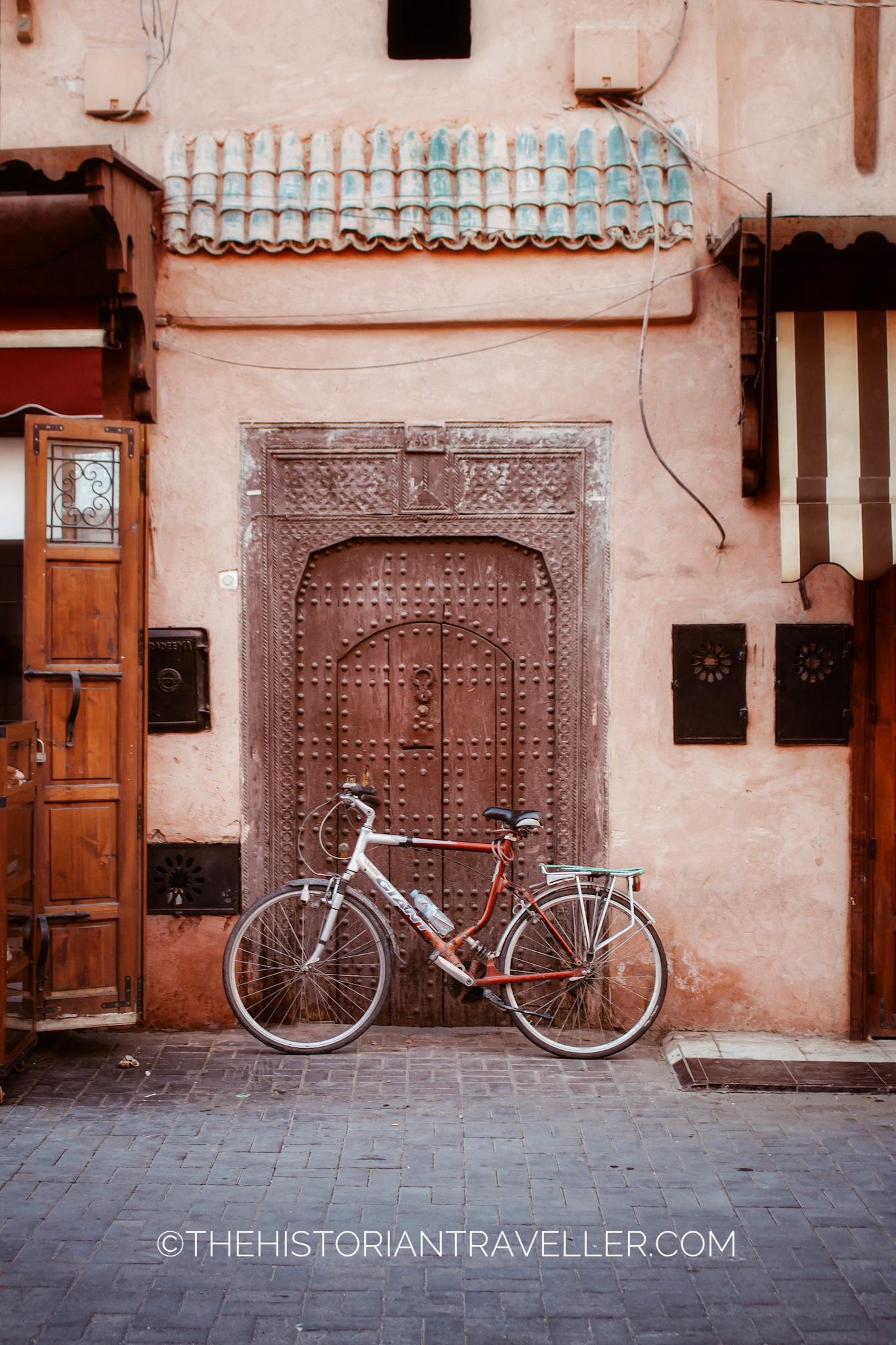
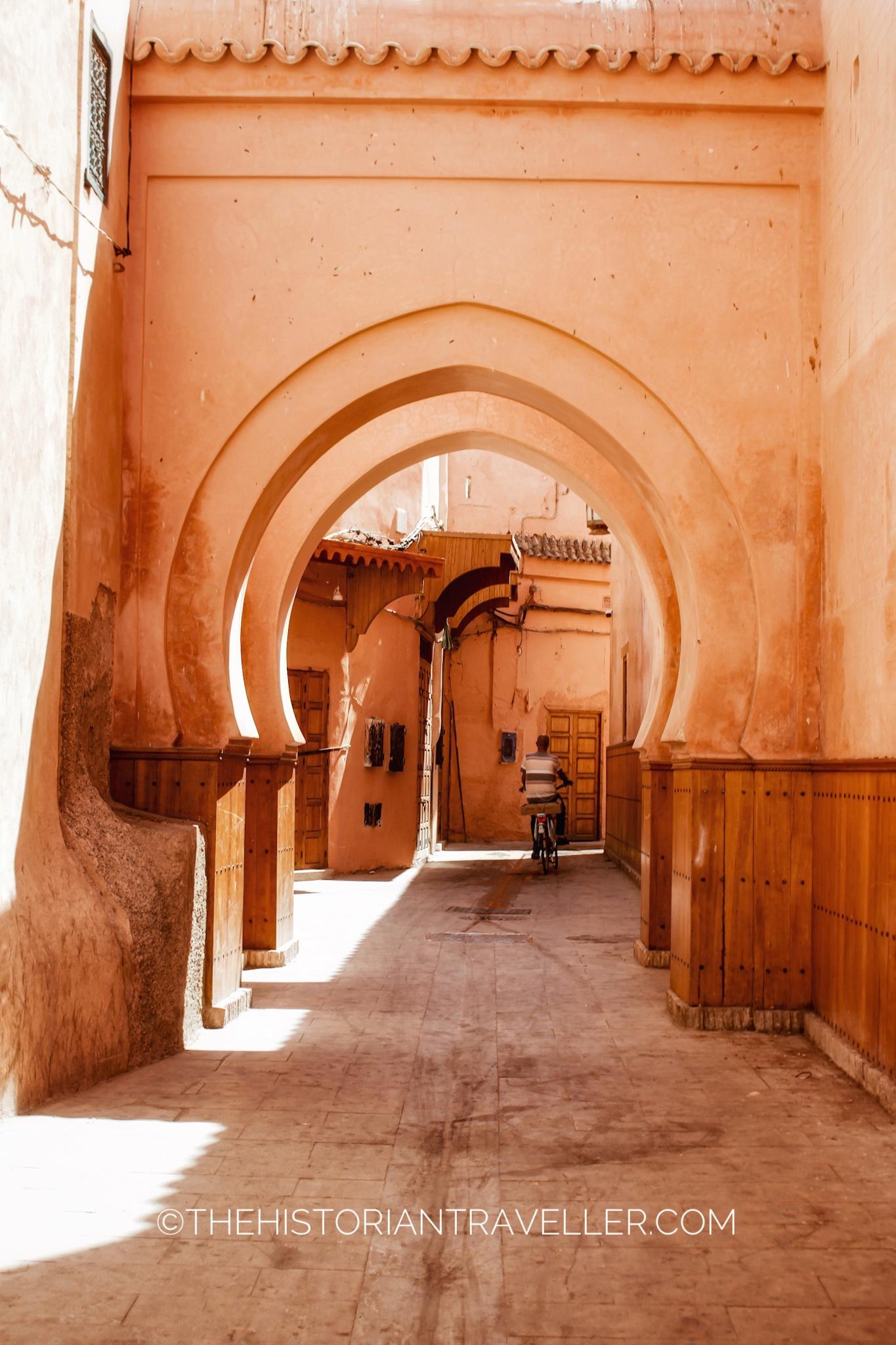
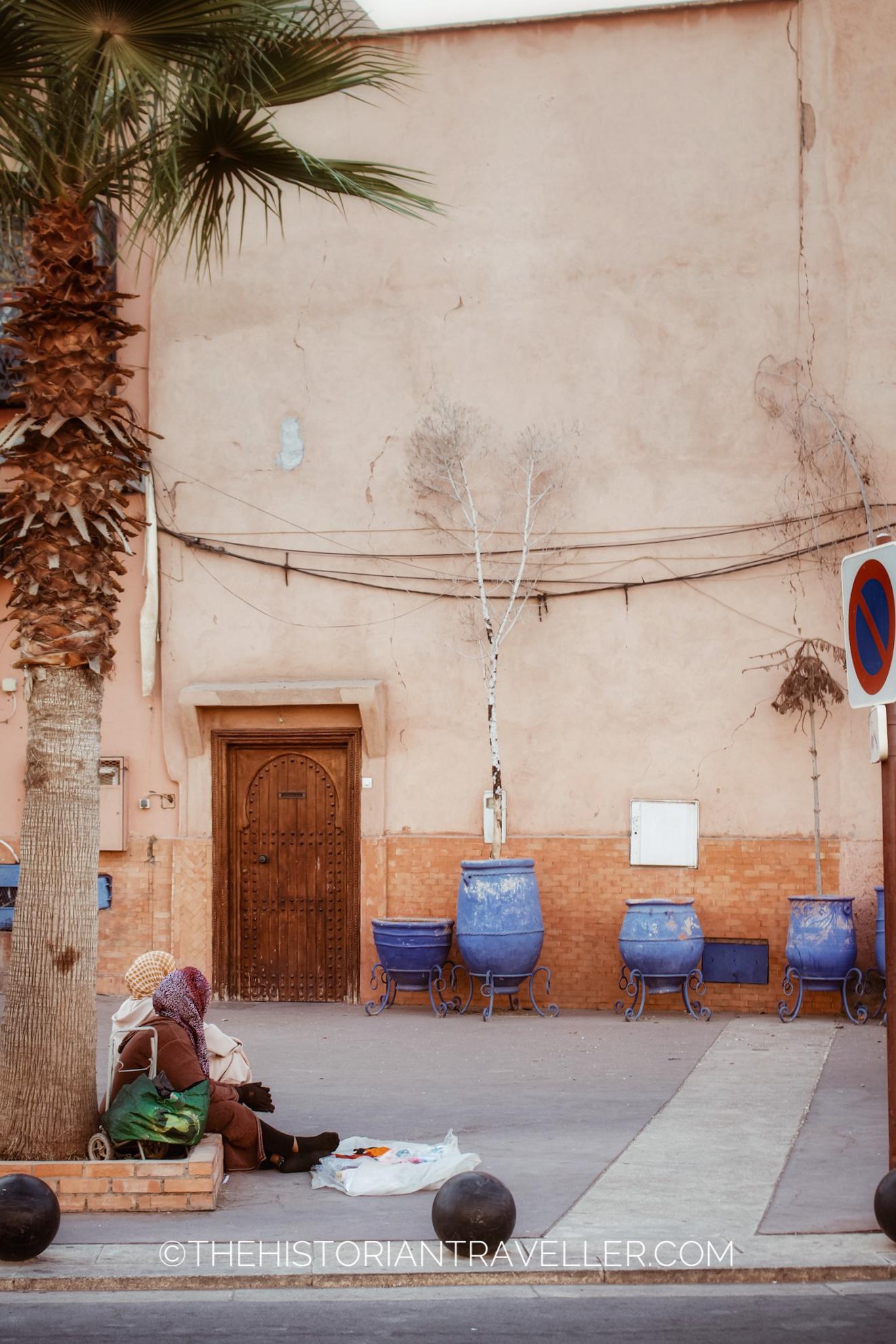
Almadinat alhamra “The Red City”. This is a name that strongly belongs to Marrakech since its days of imperial capital of the Almoravid Empire. Founded in 1070 by the Emir Abu Bakr ibn Umar, Marrakech has always been an established cultural, religious, and trading centre for the Maghreb.
The Almoravids, a Berber Muslim dynasty coming from the Western Sahara, deeply influenced the architectural and urban structure of Marrakech till nowadays. Indeed, the famous red walls enclosing the historical medina, as well as the area of the Koutoubia Mosque and Jemaa el-Fnaa still appears similar as they were centuries ago.
Almohads and Saadians
in 1147, another great dynasty came to power in Marrakech: the Almohads. Historical records suggest that they purged the Almoravid population over three days and established the city as their new capital. To assert their power and legitimacy over the city, the new ruling dynasty destroyed or replaced most of the Almoravid architectural structures. Among the finest examples of Almohad architecture that you can visit today, there are the Menara Gardens and the Kasbah Mosque.
After centuries of great instability following the death of the Caliph Yusuf II in 1224, Marrakech regained its status as the capital of Morocco in the 16th century. The Saadian dynasty played a crucial role in this resurgence, bringing wealth to the city by constructing sumptuous palaces and restoring the crumbling architecture left by previous rulers. One notable example of their architectural legacy is the now-ruined Badi Palace.
Marrakech’s religious significance was also heightened during this period, as it became the designated location for the tombs of Morocco’s seven patron saints. These saints were seven historical Muslim figures created by Sultan Moulay Isma’il in the 17th century with the aim of transforming Marrakech into a city of pilgrimage. As the city established itself as a religious and cultural centre, it also earned the designation of being one of Morocco’s ‘forbidden cities.’ In fact, European Christians were not allowed to enter Marrakech until 1867 unless they had authorisation from the Sultan.
Contemporary Marrakech
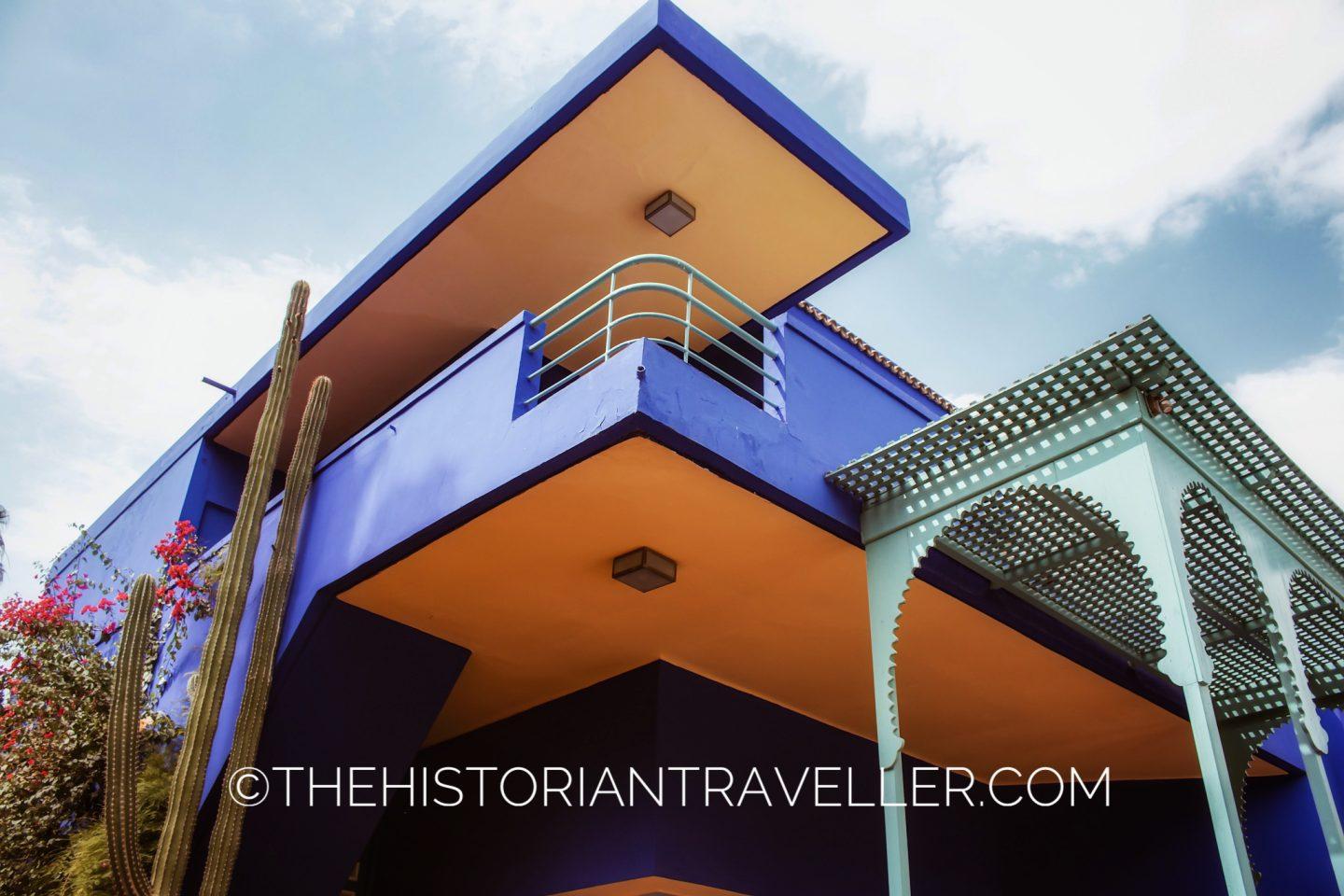
The 20th century was marked by political and social unrest. When the French established their protectorate over Morocco in 1912, T’hami El Glaoui, known as the ‘Lord of the Atlas,’ assumed the position of Pasha of Marrakesh. Historical records indicate that the Glaoui clan played a significant role in facilitating the French seizure of the city, which contributed to the turmoil and even led to the massacre of its citizens. The Glaoui family ruled Marrakech and the surrounding regions until 1956, when Morocco regained its independence.
Between 1960 and 1970, Marrakech experienced a resurgence in cultural and social significance, evolving into an important tourist hot-spot. Artists and notable Western figures spent considerable time in Marrakech, contributing to its newfound prosperity and trendy atmosphere. This ultimately led to a surge in investment in the city’s architectural layout.
The flourishing of riad renovations and the construction of new hospitality infrastructure can be traced back to this period. In 1985, UNESCO declared the Medina of Marrakesh a UNESCO World Heritage Site, raising international awareness of the city’s cultural heritage.
Marrakech is now a vibrant multicultural city. Steeped in history yet open to modern influences, it continues to draw millions of tourists annually. Its unique blend of tradition, architecture, cuisine, and culture make it a captivating destination for travellers seeking an immersive and enriching experience.
Best time to visit Marrakech
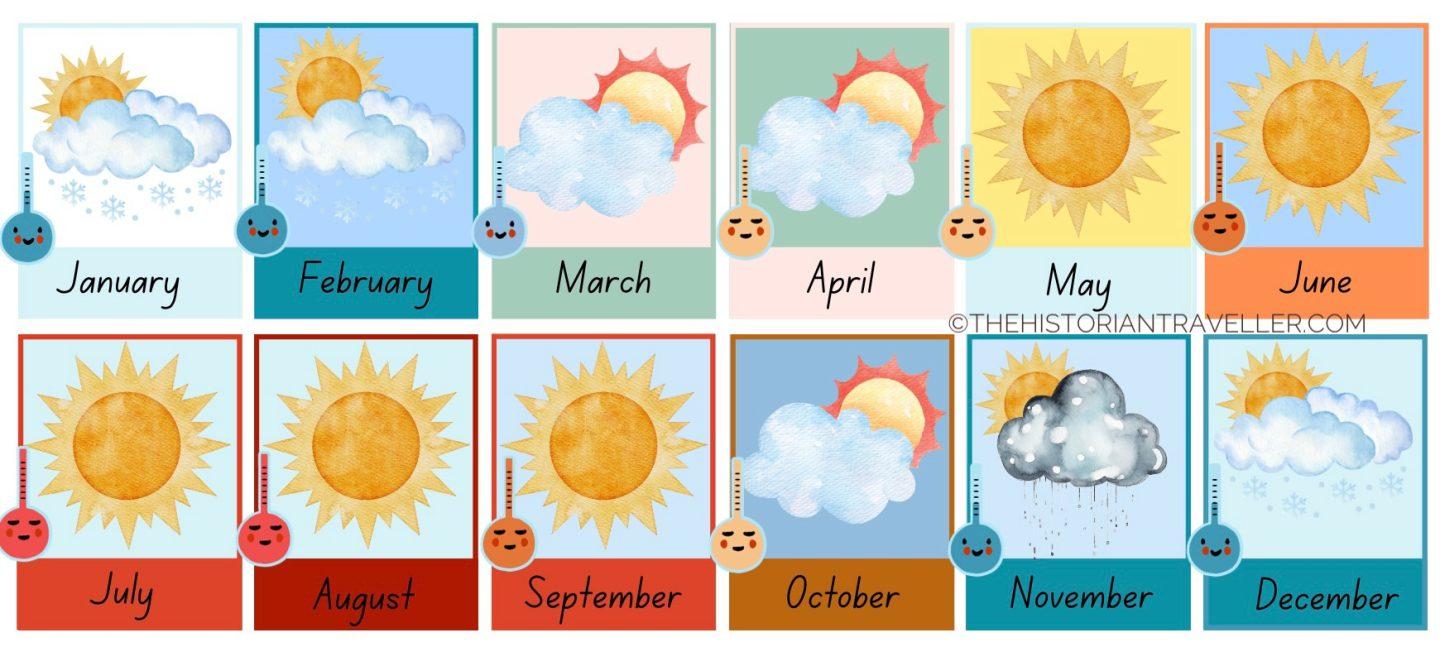
Marrakech features a hot semi-arid climate with long, hot, dry summers and brief, mild to cool winters. This means that it is a destination potentially visitable all year round. Nevertheless, certain months will definitely provide a better outdoor experience than others. Indeed, from March through mid-May and late September to mid-November, temperatures are consistently pleasant without becoming unbearably hot. Moreover, rainfall tends to be lower than in the winter season.
Summer in Marrakech, as in the rest of Morocco, brings high temperatures ranging from 35 to 42 °C. This makes city exploration, particularly during the daytime, a little challenging. Winter is a bit cooler, with temperatures falling to their lowest in January, ranging between 18 °C and 22°C. Although the nearby Atlas Mountains will be capped in snow, providing a breathtaking photogenic setting.
Getting around Marrakech
Transport
It’s very easy to get around Marrakech. Indeed, most of the city’s attractions are within the historical medina and this is completely car-free! Therefore, to get around Marrakech medina, you’ll need just your feet. However, if you are planning to visit different areas you might opt for local buses or taxis.
Local buses in Marrakech
If you don’t want to walk lengthy distances from one side to another of the city, you might opt for local buses. Buses stops at key locations outside the walls and tickets are pretty cheap (between 4and 30 DH, depending on the distance). Alsa is the local bus company going around Marrakech. You can check the routes and timetables here.
Perhaps, a route you might be interested particularly is the L19 Express Bus. This connects the airport to key destinations within the city such as Hivernage, Bab Doukkala, Marrakech Railway Station, Jemaa el-Fna, Gueliz, etc. The bus is every 20 mins and a roundtrip ride is 30 DH (the ticket is valid 2 weeks but you’ll need to keep your receipt!). Tickets can be bought inside the bus.
Taxi in Marrakech
Petit yellow taxis are the ones used to get around reasonable distances within the city of Marrakech. We used a couple of Petit Taxi to get out of the Medina in Marrakech. Unfortunately, no one of the drivers wanted to turn on the meter, so we established a fair price before getting on the taxi. This was never more than 100 MAD. Consider that a ride from the Medina (Koutoubia or Jemaa el-Fnaa to Ville Nouvelle usually cost around 10 euro, even less if your driver is very honest).
Uber or other car sharing taxi services are non-existent in Marrakech. Therefore, if you need to refine your haggling skills for getting somewhere without being ripped-off.
Marrakech Neighbourhoods
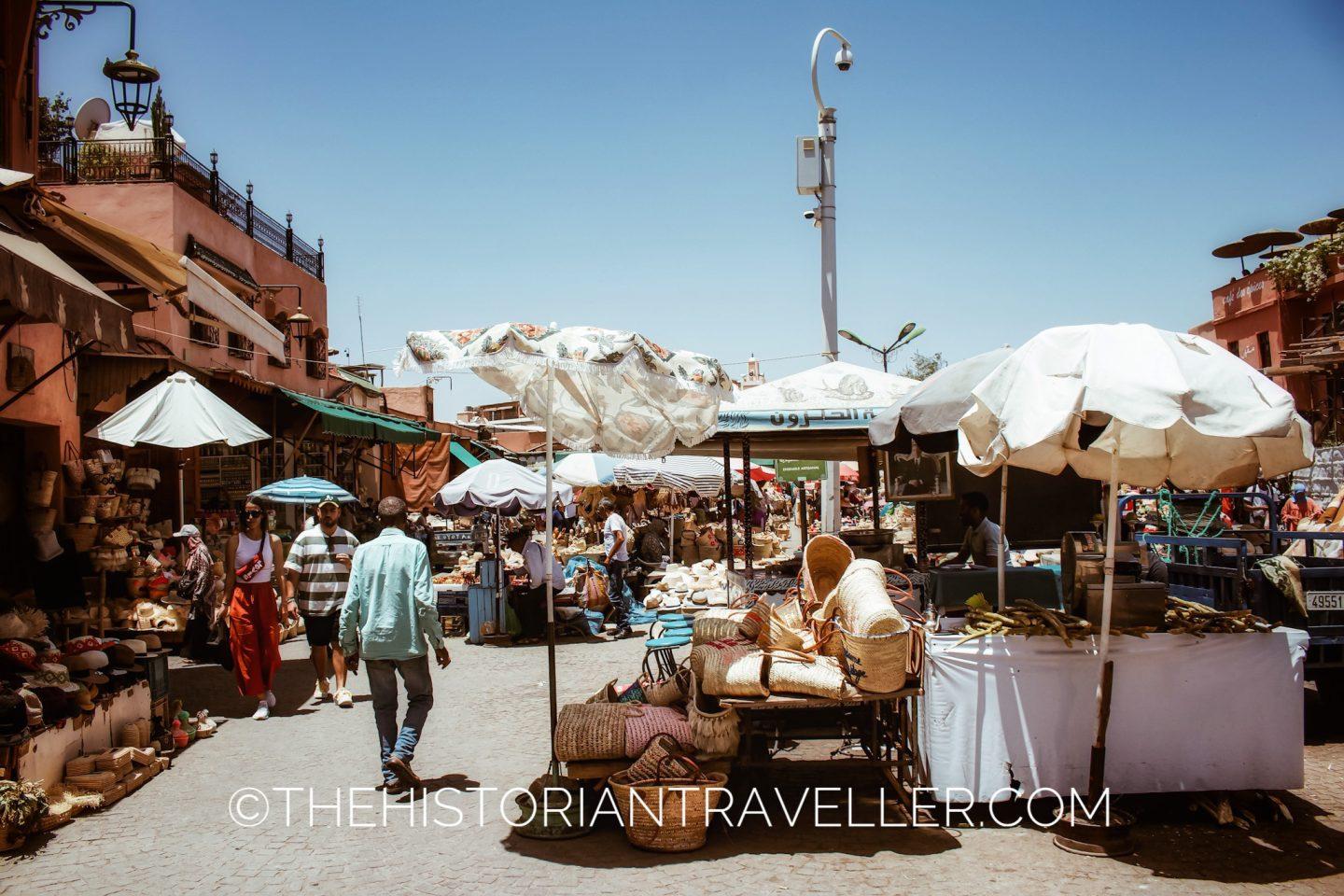
Before immersing yourself in the exploration of the bustling streets of Marrakech’s Medina, it’s beneficial to have some knowledge of the city’s various neighbourhoods. Marrakech is divided into more than 30 small neighbourhoods. Nevertheless, there are only about 12 main distinct neighbourhoods that are on the tourists’ radar, each offering its own unique landmarks and sightseeing experiences.
Historical neighbourhoods
- Medina. This is additionally divided into southern, northern and central medina. It’s the oldest part of Marrakech. Here you will find the vibrant Jemaa el-fnaa and some of Marrakech oldest architectural examples.
- Mouassine. Almost indistinguishable from the medina area, this neighbourhood stretches from Jemaa el-Fnaa into northern Marrakech. It’s an area full of magical souks and rooftop restaurants. Here you’ll find the Secret Garden.
- Kasbah. This is the fortified area of Marrakech. Here the magnificent Bab Agnaou (pictured above) stands as guard of the royal quarters since the 12th century. The Kasbah neighbourhood includes some of the most prominent Saadian architecture like Badi Palace and the tombs.
- Mellah. This is the historical Jewish neighbourhood of Marrakech. Attached to the Kasbah, this lovely pinkish quarter is quiet and nice to explore. Don’t miss a stop to the Lazama Synagoue and the Jewish cemetery.
- Bab Doukkala. Situated at the north-western edge of the medina, this neighbourhood is famous for its jewellery souks and busy markets. Its name comes from the monumental Almoravid gate.
Contemporary neighbourhoods
- Gueliz. This new and vibrant neighbourhood of Marrakech is home of its most famous museums: Jardin Majorelle and YSL. Slightly off the beaten track, it has also some interesting architecture to photograph.
- Ville Nouvelle. As the name says, this is one of the newest parts of the city boasting with lovely cafes and contemporary art. Don’t miss a stop at the Comptoir des Mines.
- Hivernage. Is a trendy district in Marrakech. Boasting with luxury hotels and popular restaurants, this is a perfect place for a glamour night out. For a peaceful walk check-out the 12th-century El-Harti Park.
10 things to do in Marrakech
1. Discover historical Marrakech
If you are a history lover, Marrakech is the perfect place for you. With a medieval medina protected as a UNESCO World Heritage Site, the city treasures some of the most impressive historical sites in the whole Morocco. Here is a small list of places you can include in your bucket list for your next Marrakech itinerary.
UPDATE: please note that some of these historical attractions suffered major damages during the earthquake of September 2023. Therefore, they might be closed suddenly for urgent reparations or see long periods of closure for restoration and safety reasons.
Bahia Palace
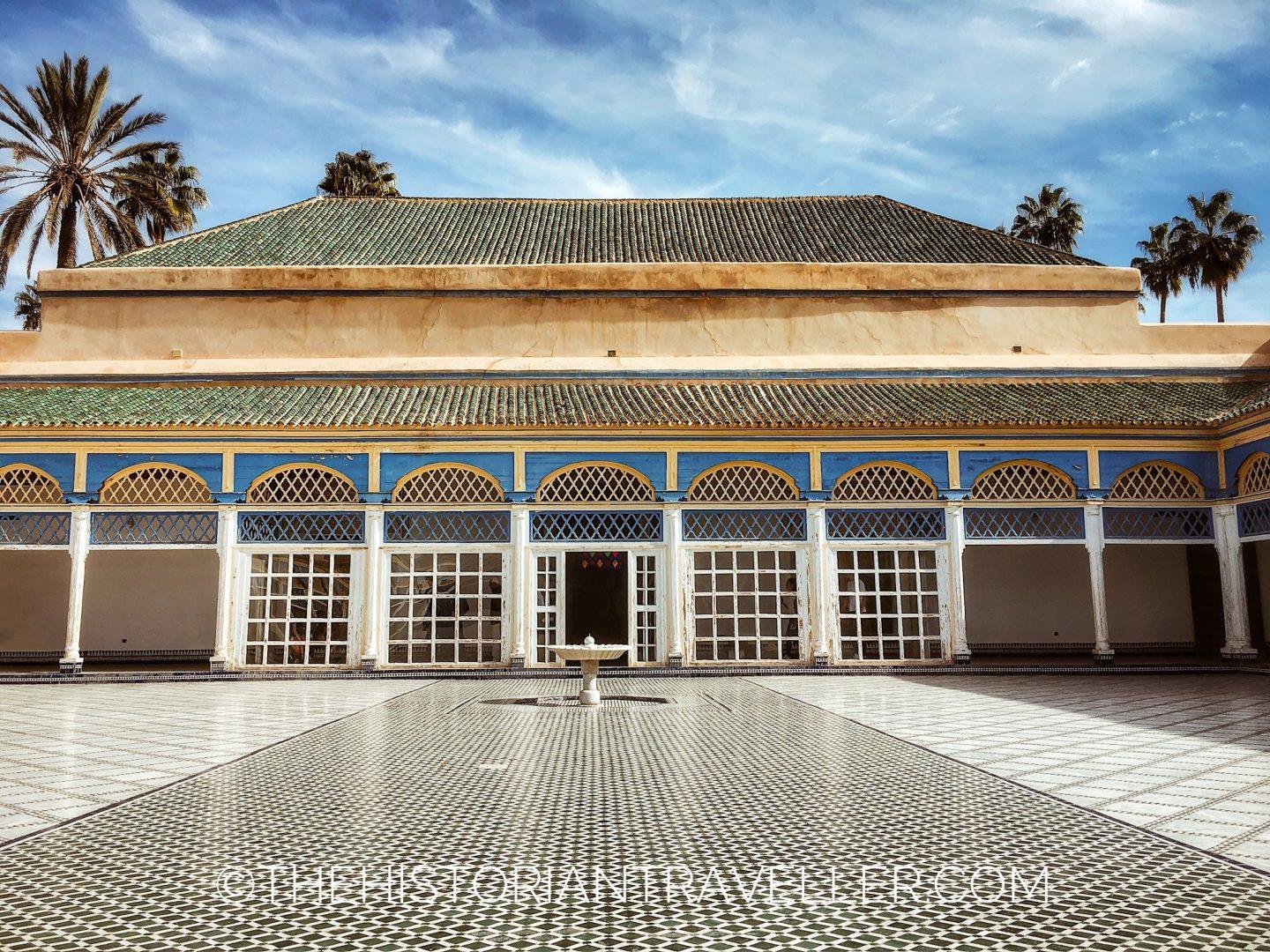
Famous for its stucco carved walls and intricate decorations, Bahia Palace is a must visit in any Marrakech stop. The palace was built in less than 50 years between 1859 and 1900 and still today is one of the most visited attractions in Marrakech. Bahia Palace has just reopened to visitors after the September 2023 earthquake affected seriously some of its structures.
The layout of the palace is divided into several courtyards and inner riads. The oldest part of the palace is called Grand Riad. This is flanked by the Small Courtyard and Cour d’Honneur. A very large courtyard, which is considered the heart of Bahia Palace. The building visit is completed with the Petit Riad. A square courtyard garden featuring richly decorated galleries.
Entrance Fee: 70 DH
Tip: Arrive as early as possible to avoid large group of tourists and have more photo opportunities.
Almoravid Koubba
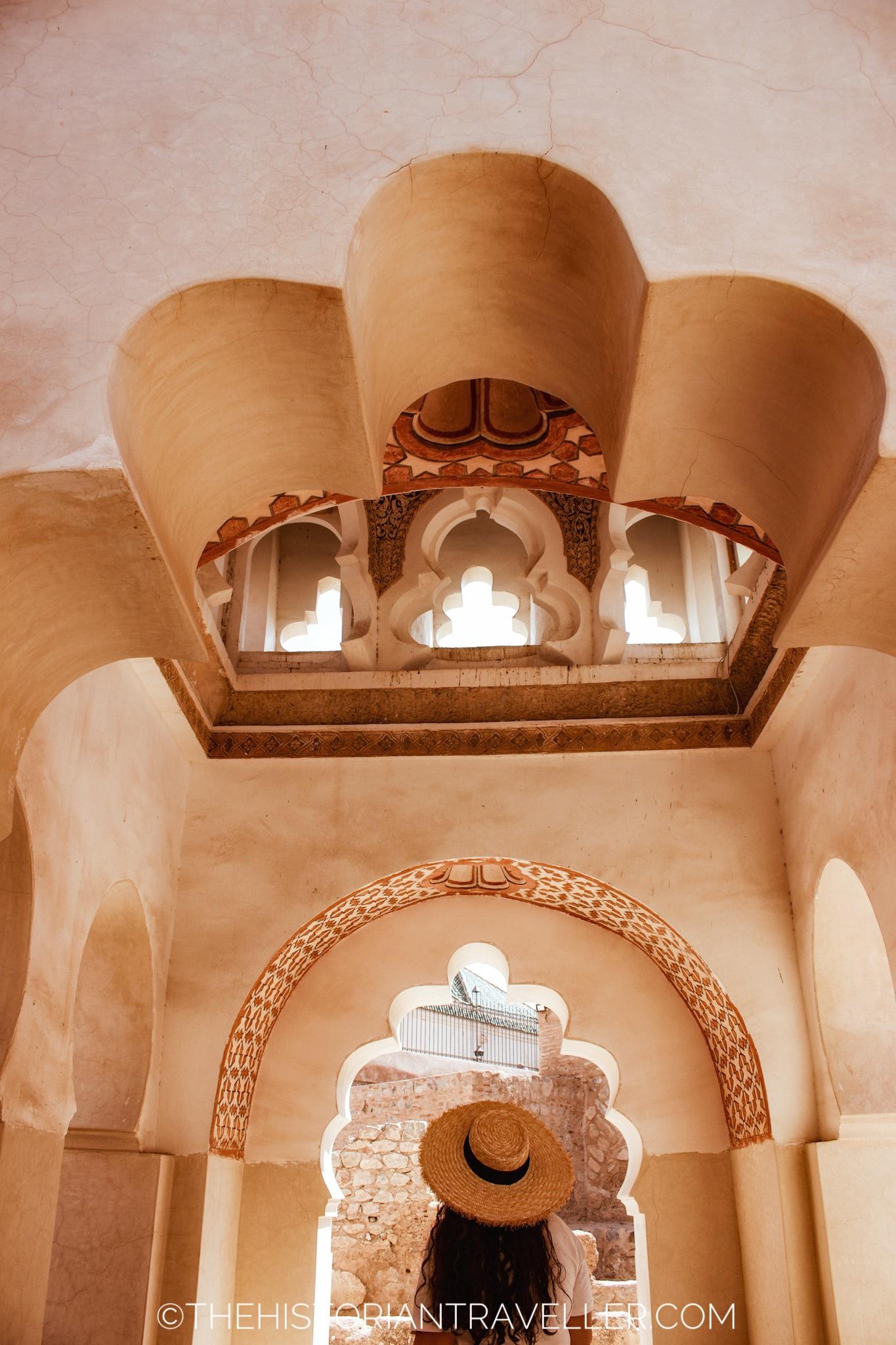
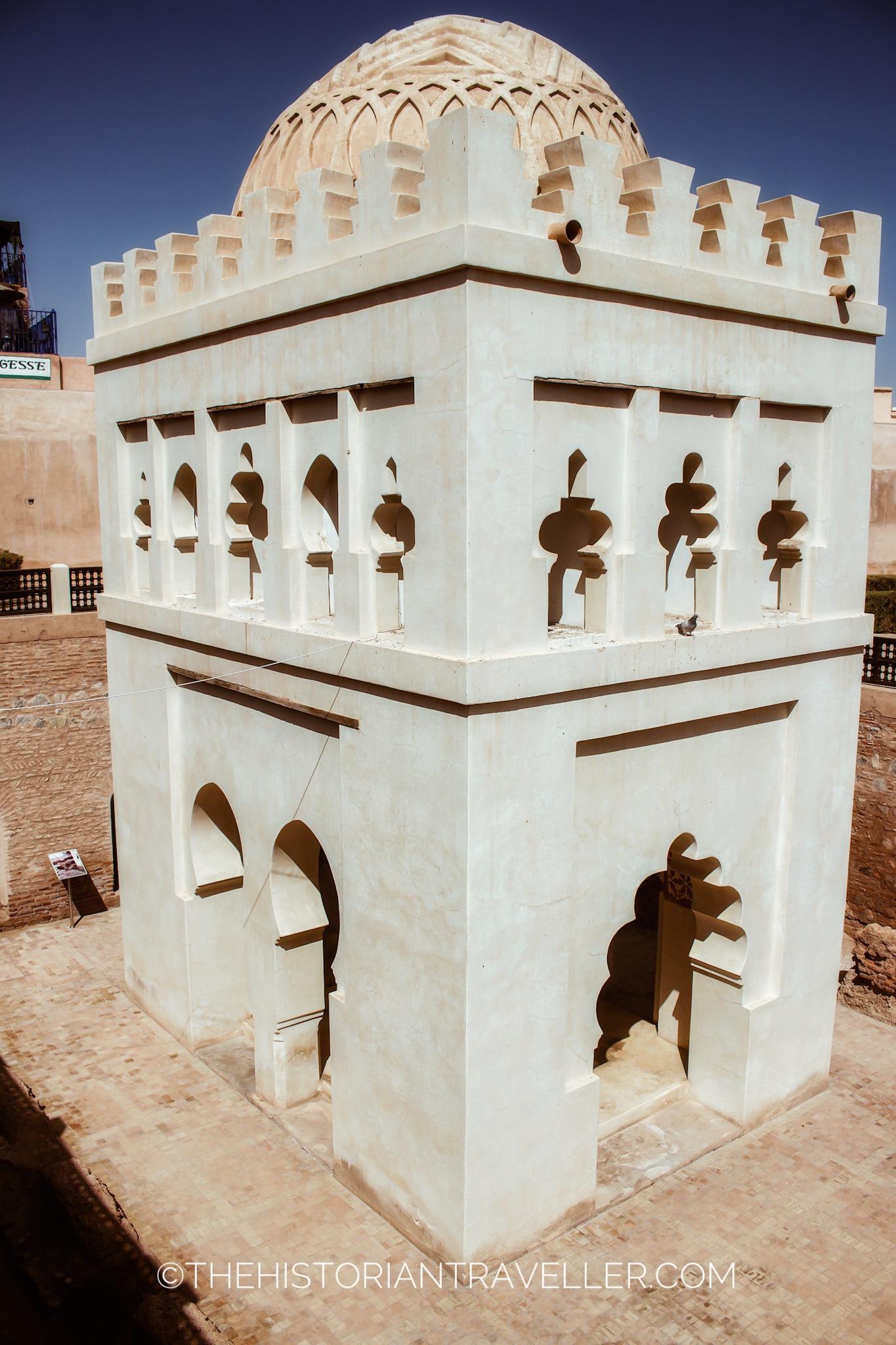
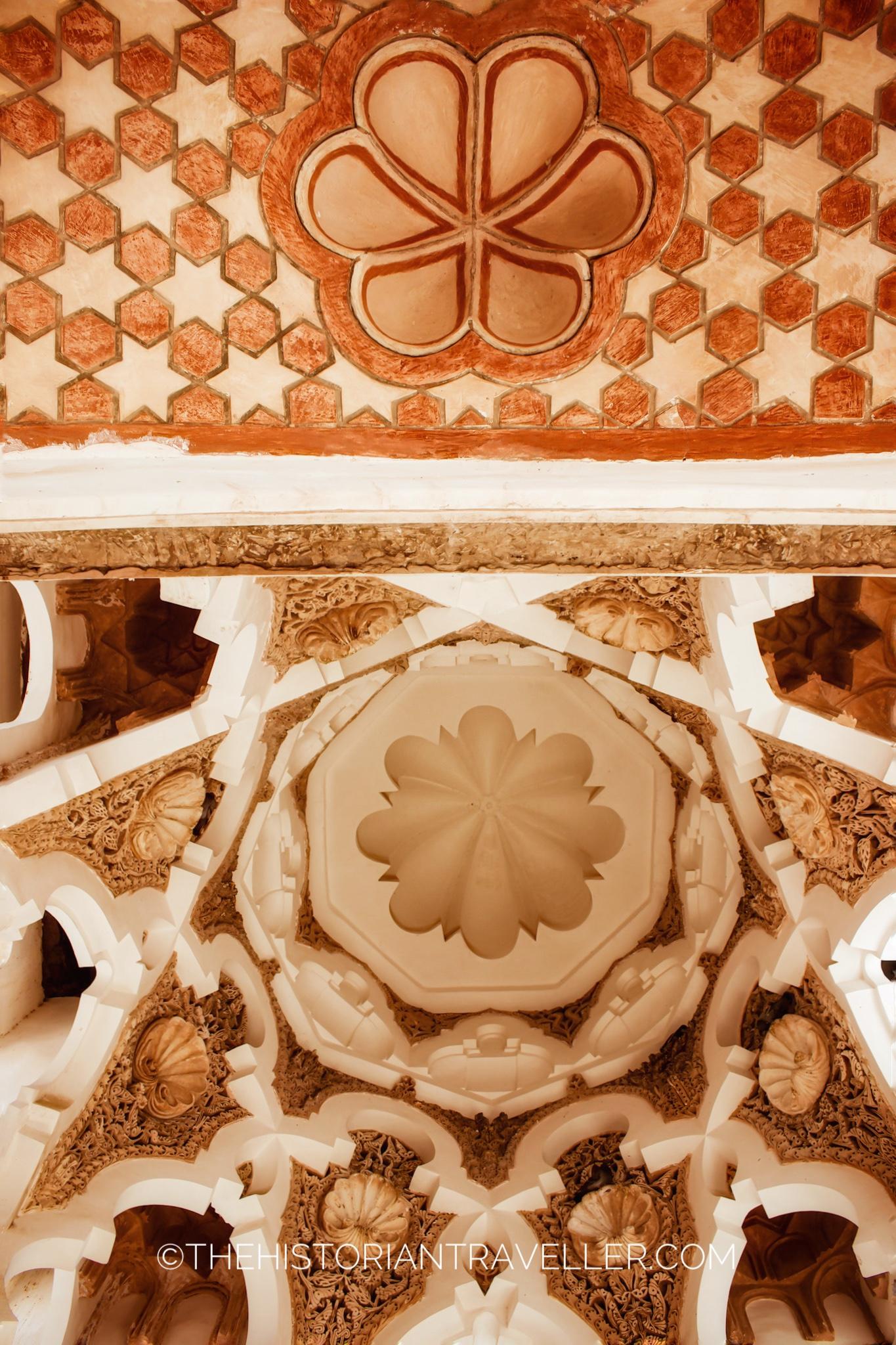
The Almoravid Koubba is a unique underrated attraction in Marrakech. Almost one in two people visiting the city miss it. Mostly because they don’t understand what it is or simply can’t find it. To me it was quite the opposite. Because I am who I am, it was the first place I visited the morning I landed in Marrakech (still in my airport clothes!).
The Almoravid Koubba is the oldest monument in Marrakech (dating 1117). Moreover, it is also the only surviving example of Almoravid architecture in the city. The term ‘Koubba’ usually refers to a domed tomb. However, in the case of this particular building, historians and archeologists believe it was once part of the nearby Ben Youssef Mosque and it was used as a pavilion used for ritual ablutions before prayer.
While the exterior architecture is quite sober, the interior of the dome is spectacularly decorated. This reveals detailed carving of floral and vegetable patterns and intricate muqarnas not easily found anywhere in Morocco.
Entrance Fee: 50 DH
Ben Youssef Madrasa
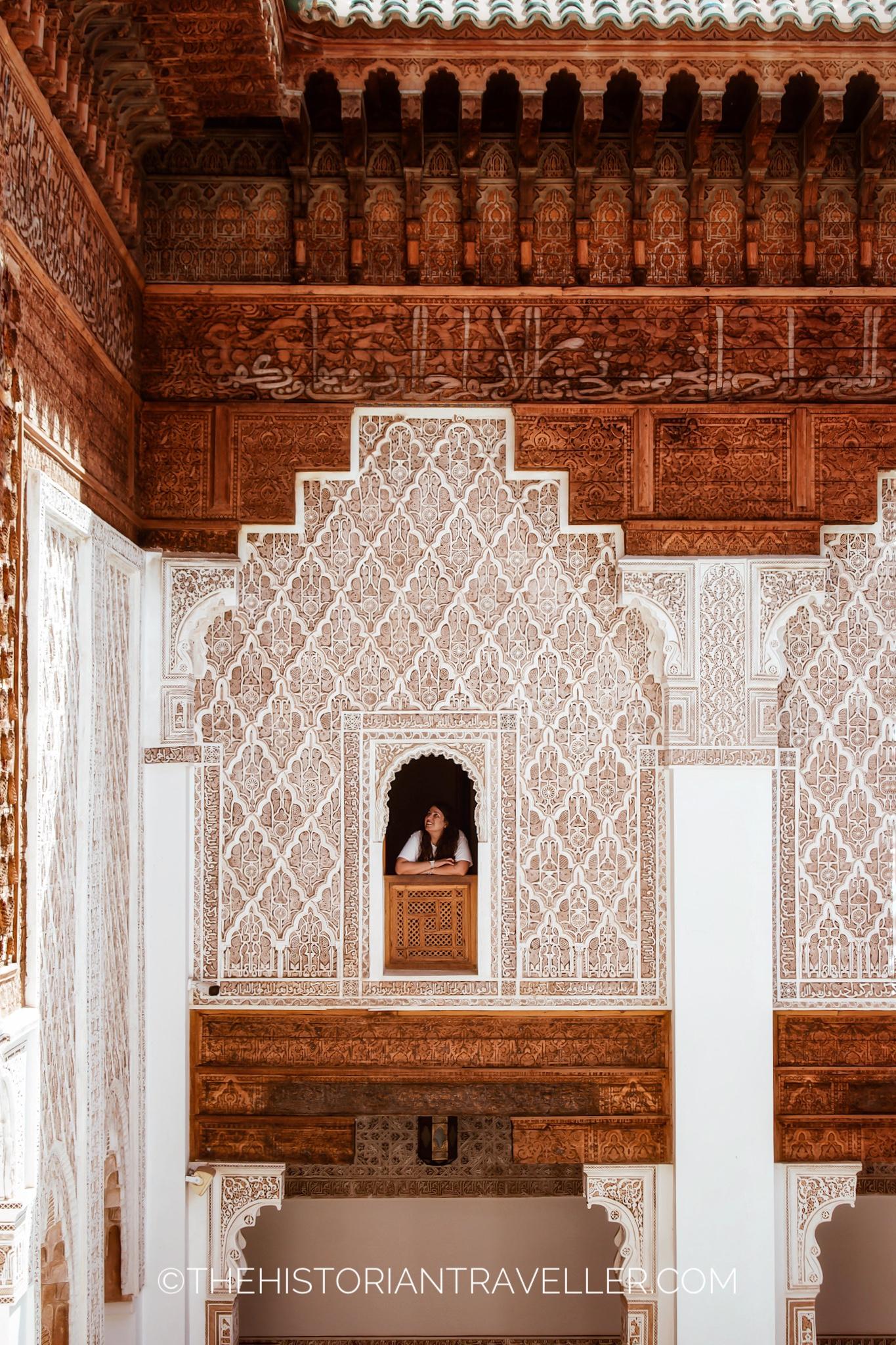
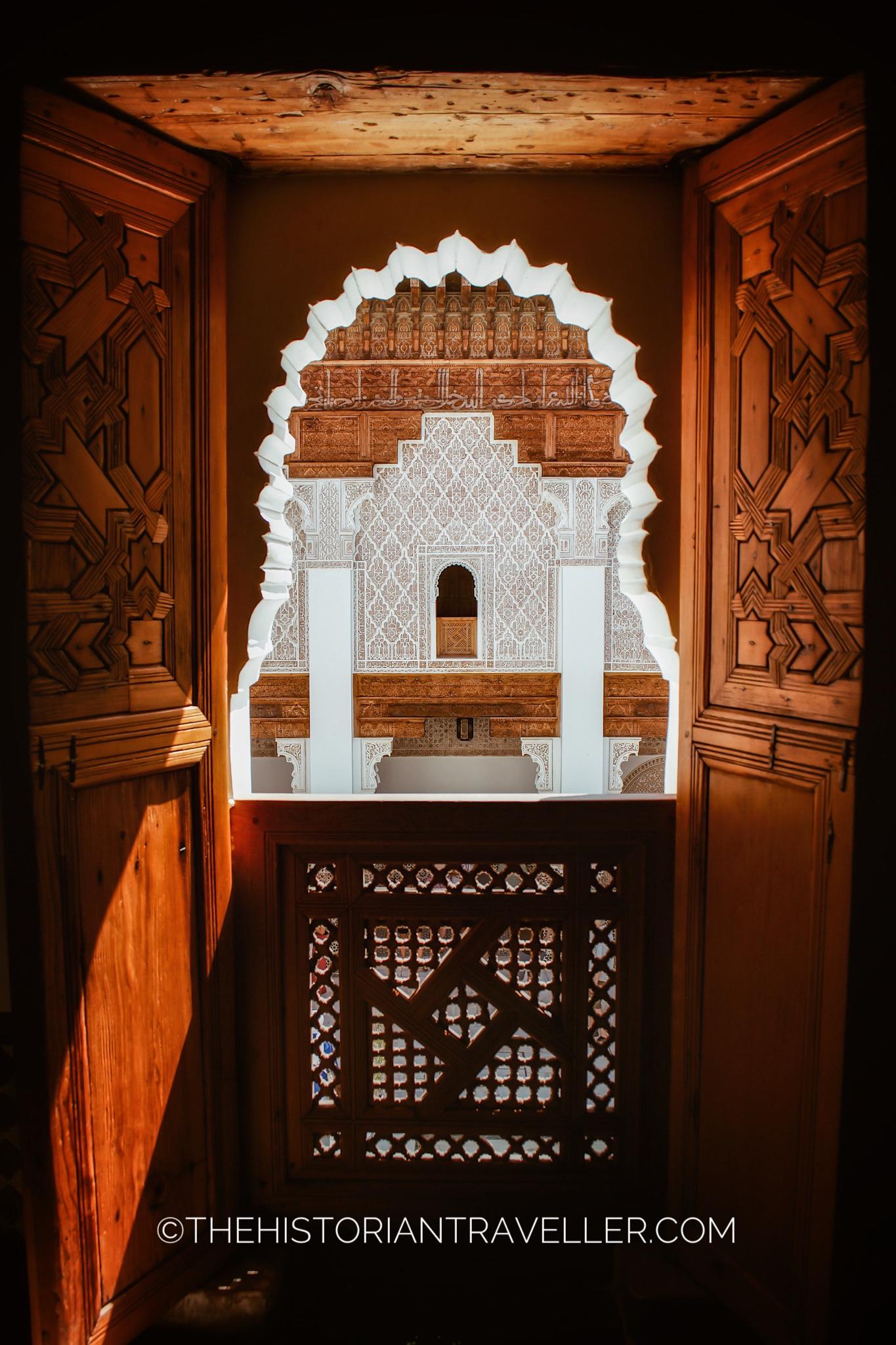
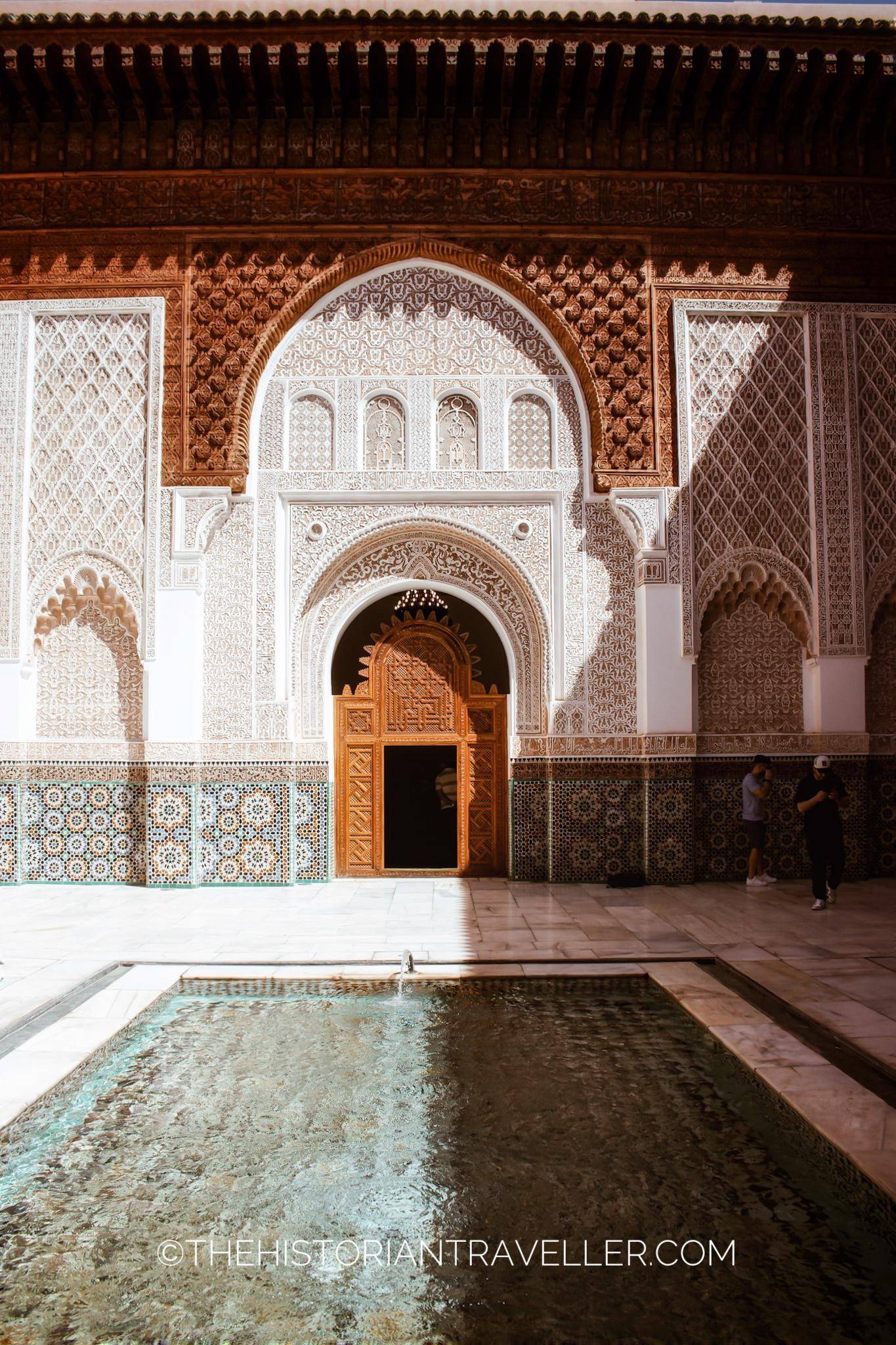
Completed between 1564-65, the Ben Youssef Madrasa was the largest educational institution in Morocco at the time of its construction. Adjacent to the Ben Youssef Mosque, it was able to accommodate up to 800 students. This Madrasa (Islamic school) in particular, was built by the Saadian Sultan Abdallah al-Ghalib. Similarly to other Madrasas of the same period, the Ben Youssef Madrasa is built around a central courtyard surrounded by corridors on different levels. These included small rooms used by students.
The Madrasa ended its school function in 1960 and it reopened as historical site in 1982. I am glad we manage to visit this architectural jewel as it was closed for renovation from 2018 to April 2022.
Entrance Fee: 50 DH
Marrakech Kasbah
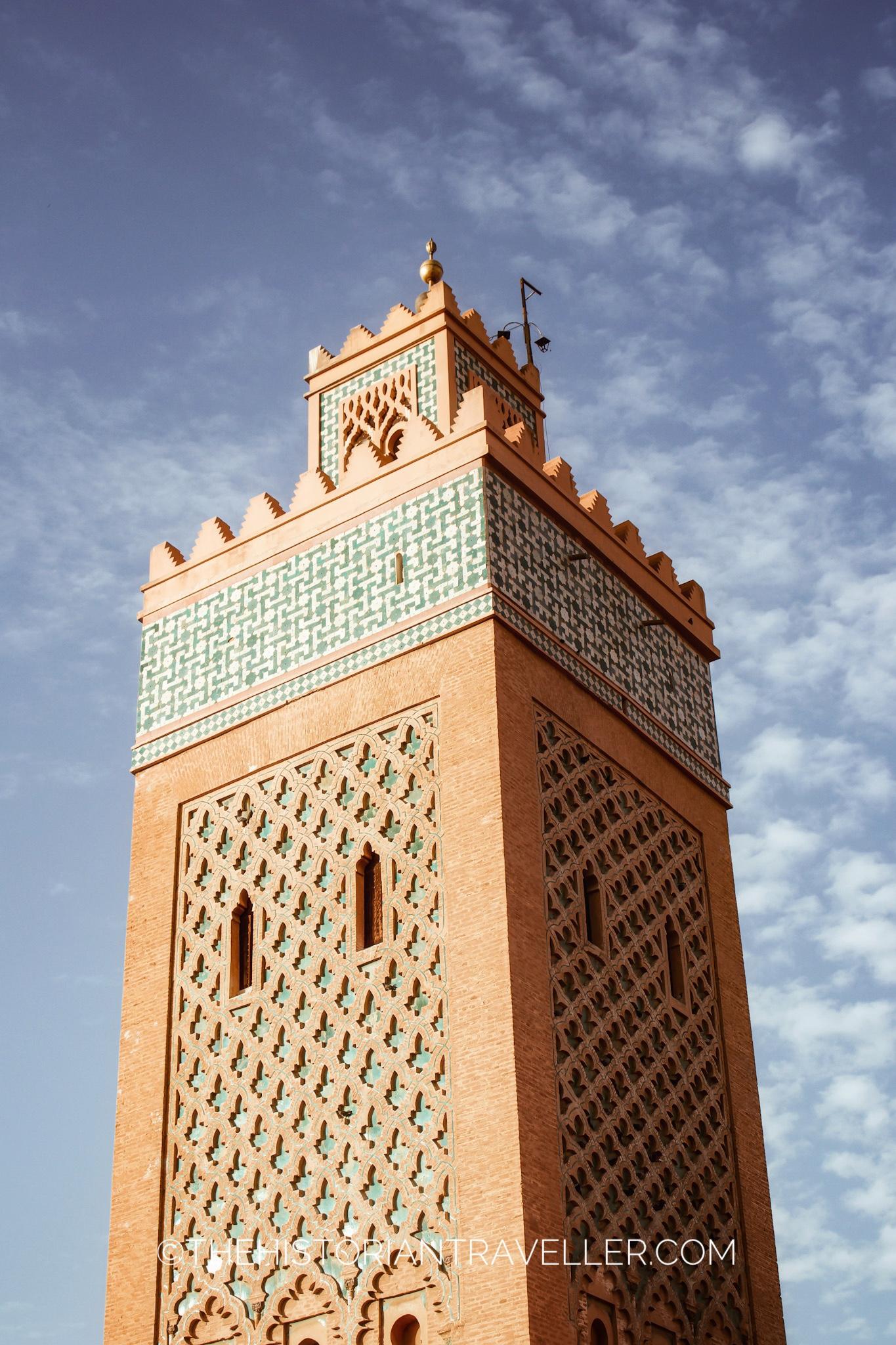
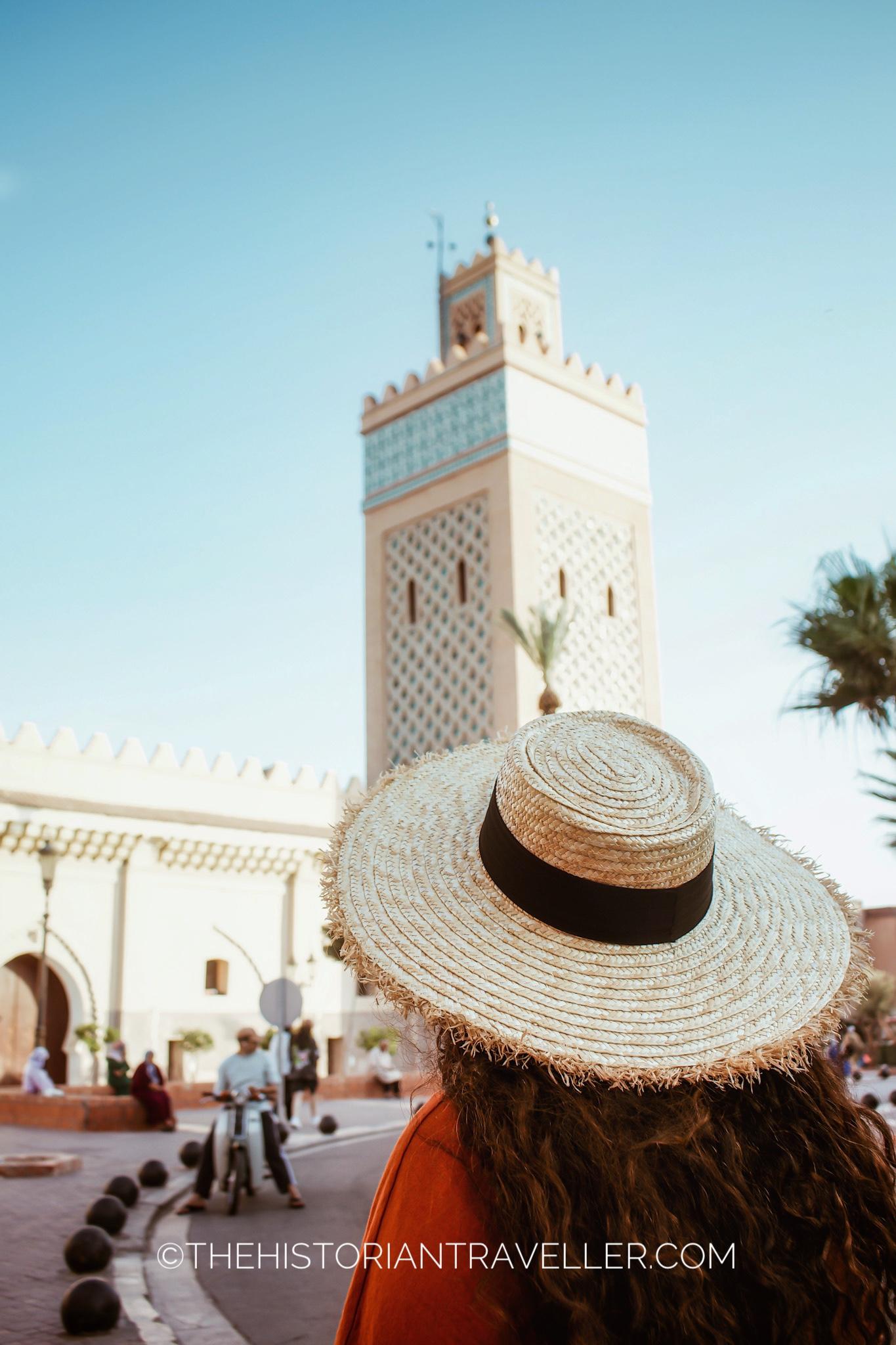
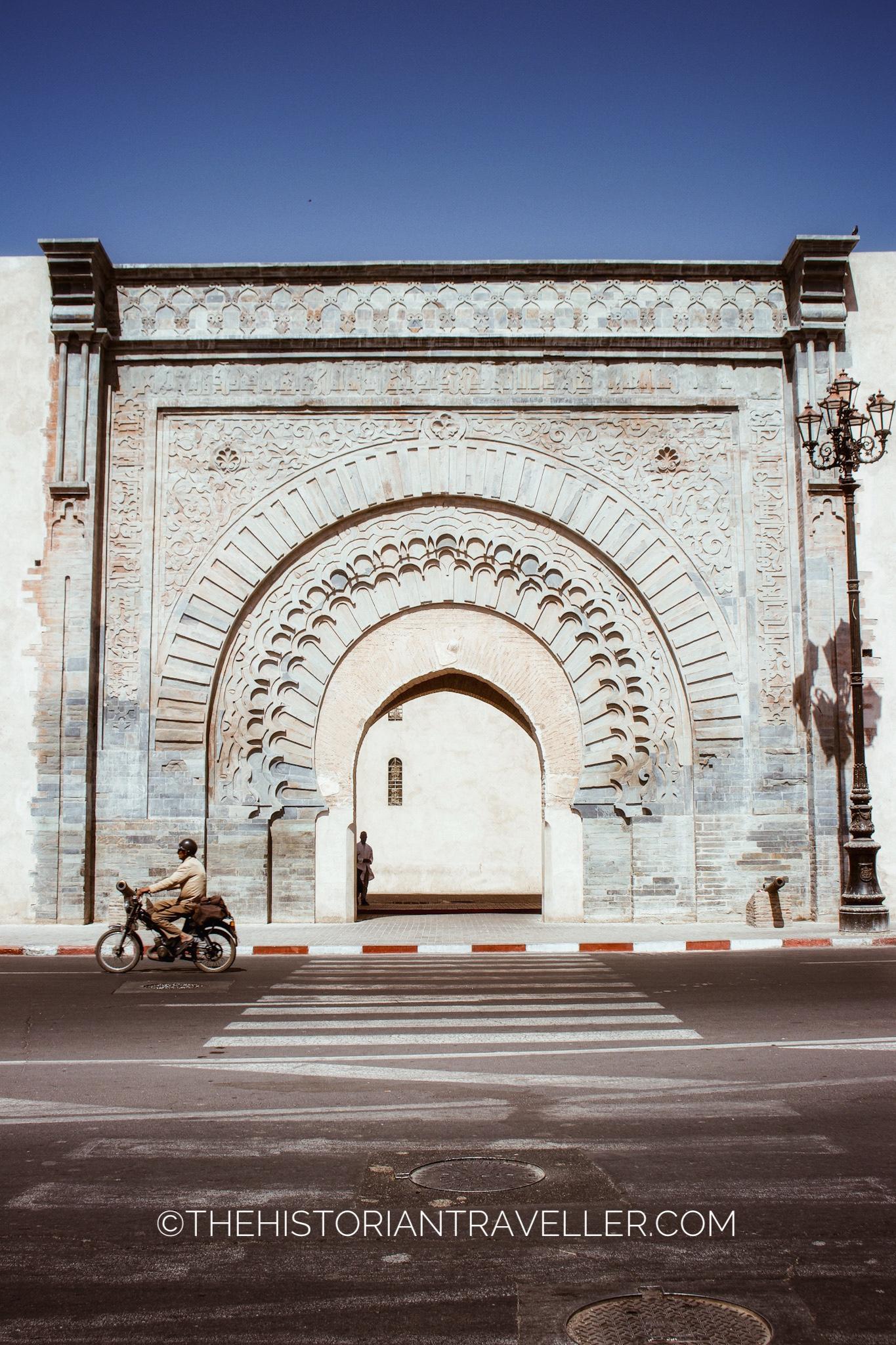
The Kasbah of Marrakech is not a single building as one might expect, but an entire large wallet district located in the southern area of the medina. This includes various neighbourhoods and attractions. A large part of the district is still occupied by the official royal palace, the Dar al-Makhzen, which serves as the residence of the King of Morocco when he visits Marrakech. The Kasbah district was founded by the Almohad dynasty in the 12th century. Unfortunately, the only two surviving structures of that period are the historical main entrance gate of the Kasbah, Bab Agnau and the Kasbah mosque (both pictured above).
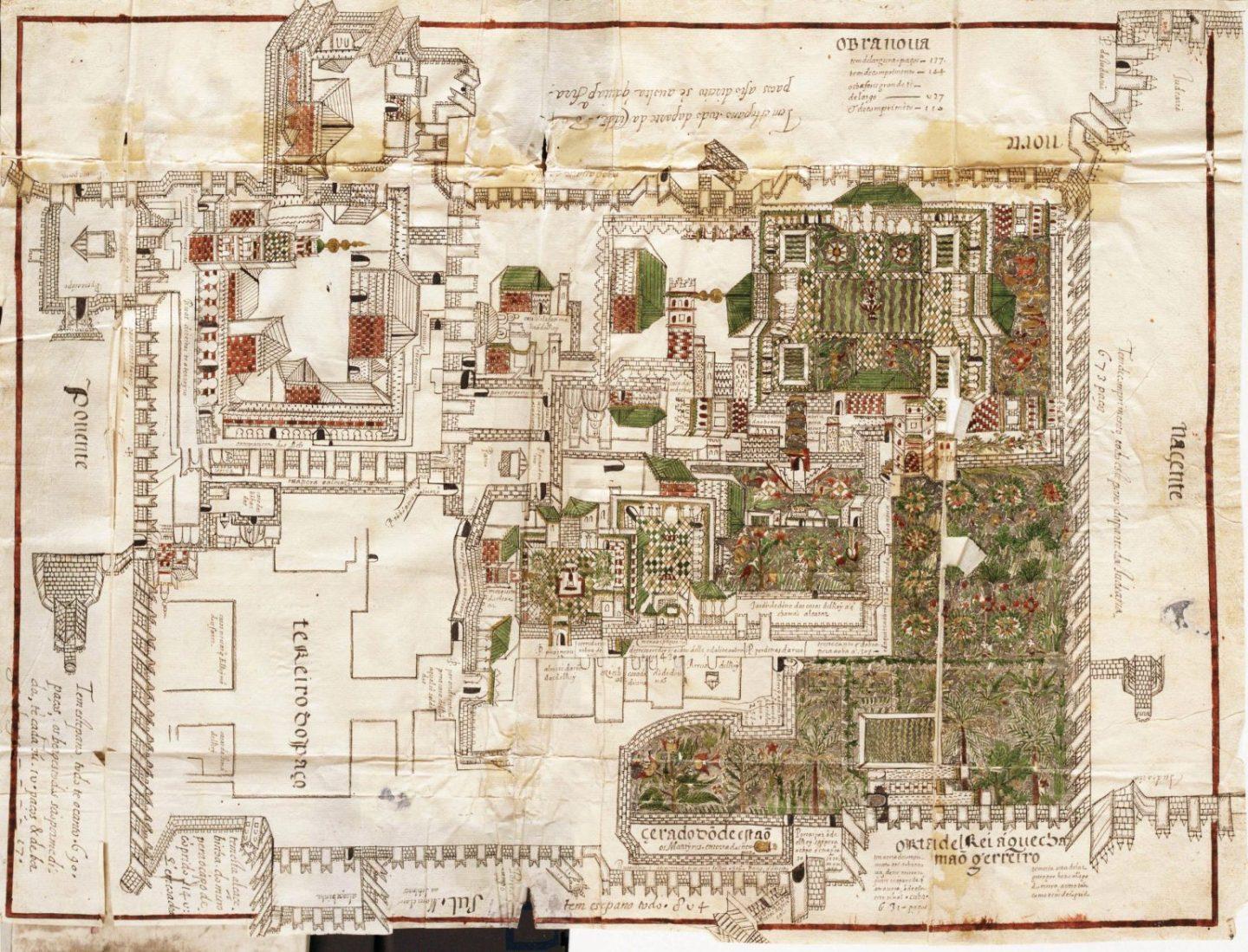
In the Kasbah District are included also the Badi Palace, the Saadian Tombs as well as the Jewish quarter of the Mellah. All these places are now freely accessible by general public but the Royal Palace remains still off limits.
If you want to know about the different types of Kasbah in Morocco, you can read my article Land of Kasbah here!
Badi Palace
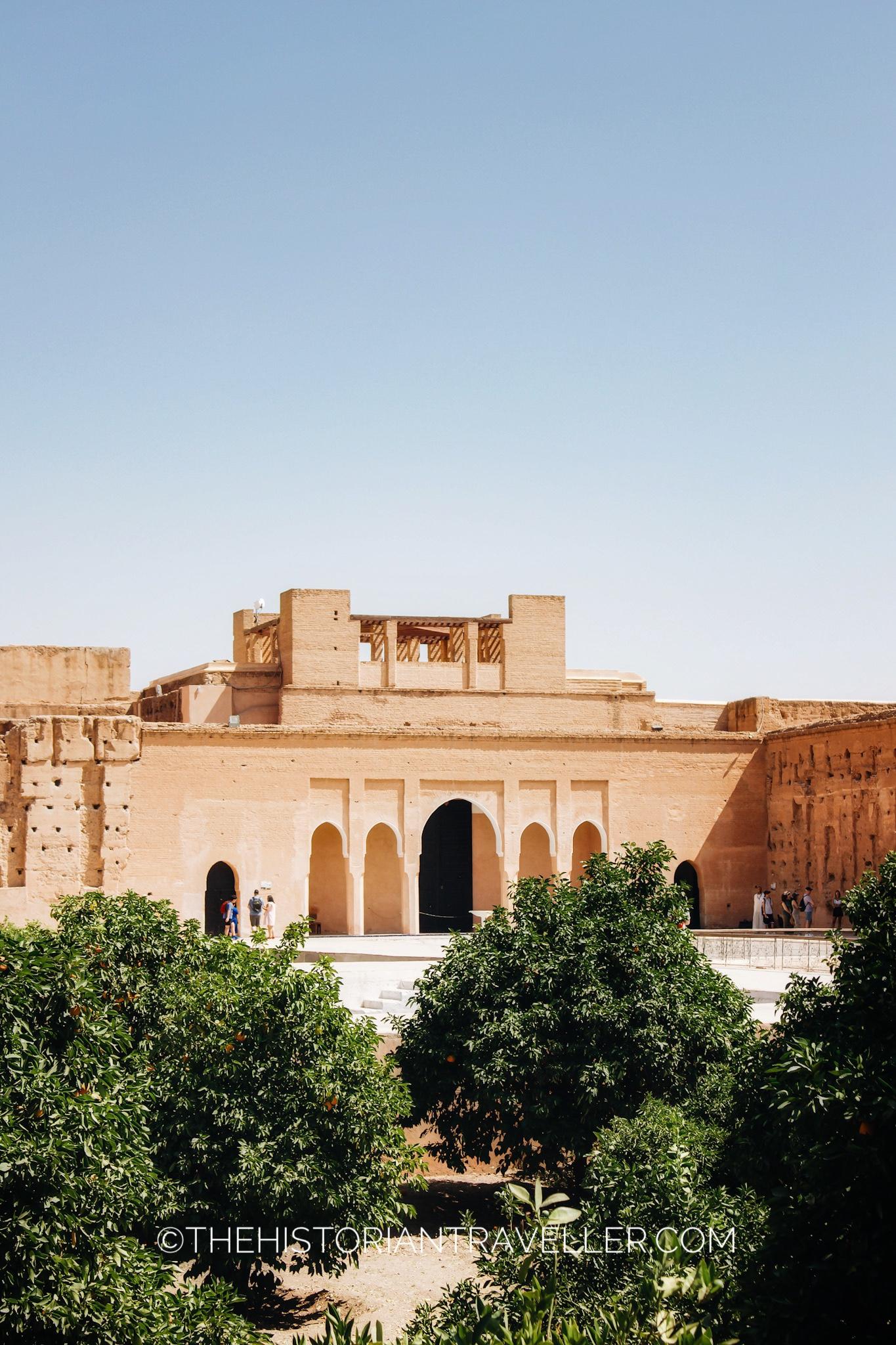
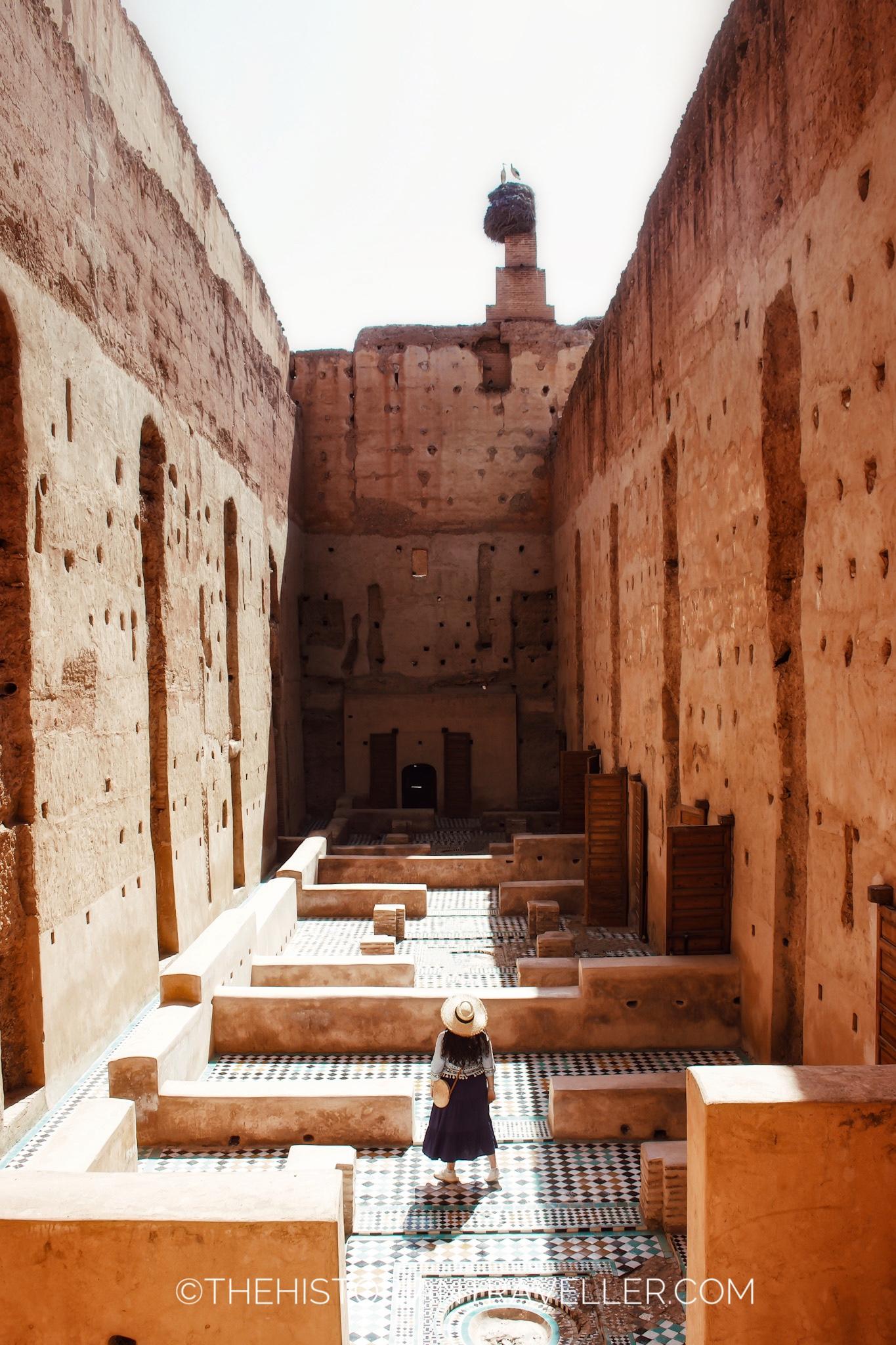
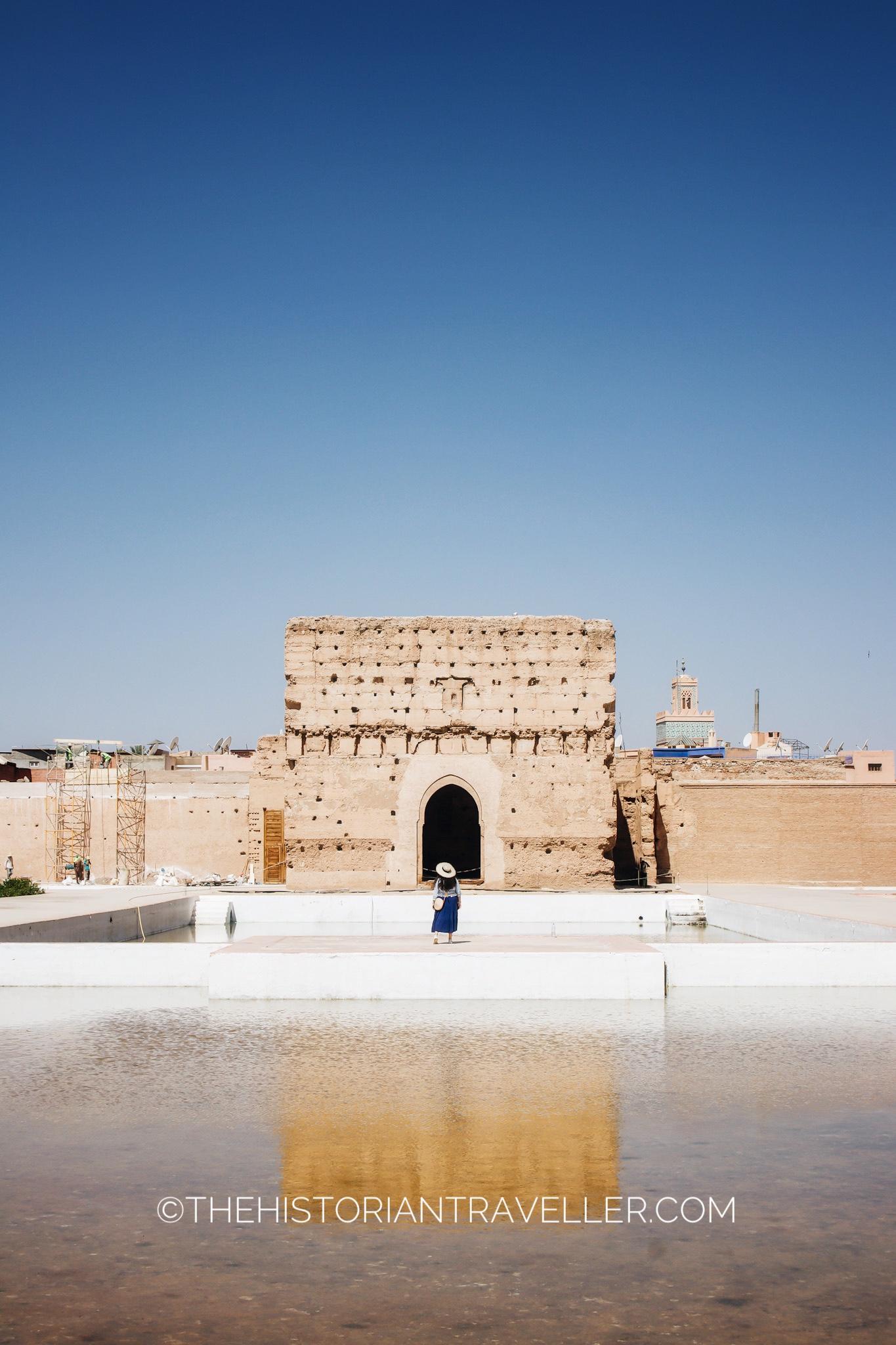
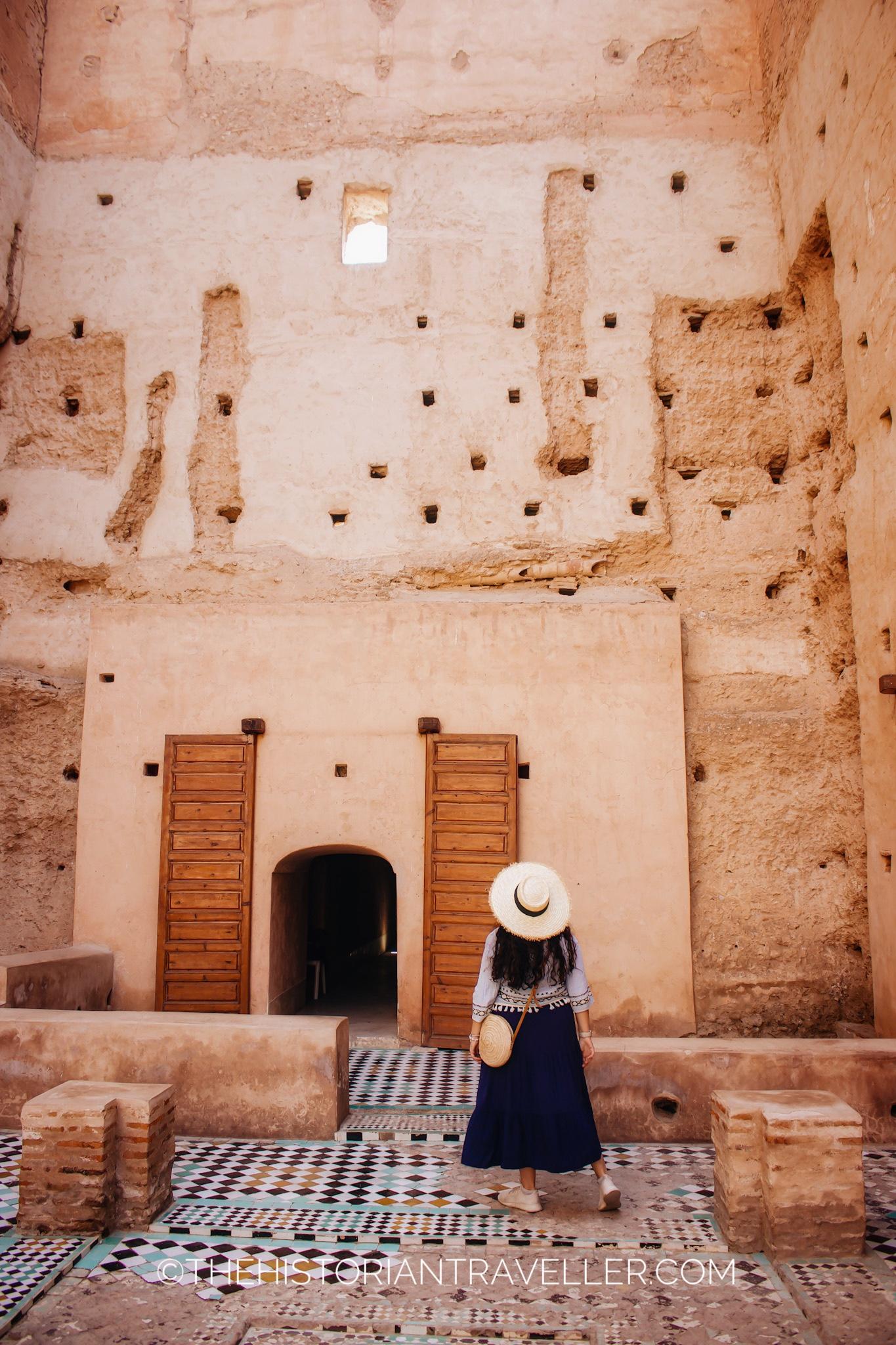
Another jewel of the Saadian Dinasty is El Badi Palace or simply Badi Palace. Now a ruined palace, it was build around 1578-93 in the area of Marrakech Kasbah as part of the Saadian Royal Complex. The name “El Badi” translates as “the Incomparable”. This is one of the 99 Names of God in Islam and it was specifically chose to depict a palace that was meant to impress its guests.
To complete the construction of El Badi Palace, the Sultan brought artisans from all over North Africa and even Europe. At the peak of its splendour, the palace must have been one of the most impressive places to visit in Marrakech, with two immense sunken gardens, marble walls, fountains and sculptures.
Tip: the palace is vast and no explanatory panels are present around. To understand its history and different areas, it is advisable to have a guide.
Entrance Fee: 70 DH
Saadian Tombs
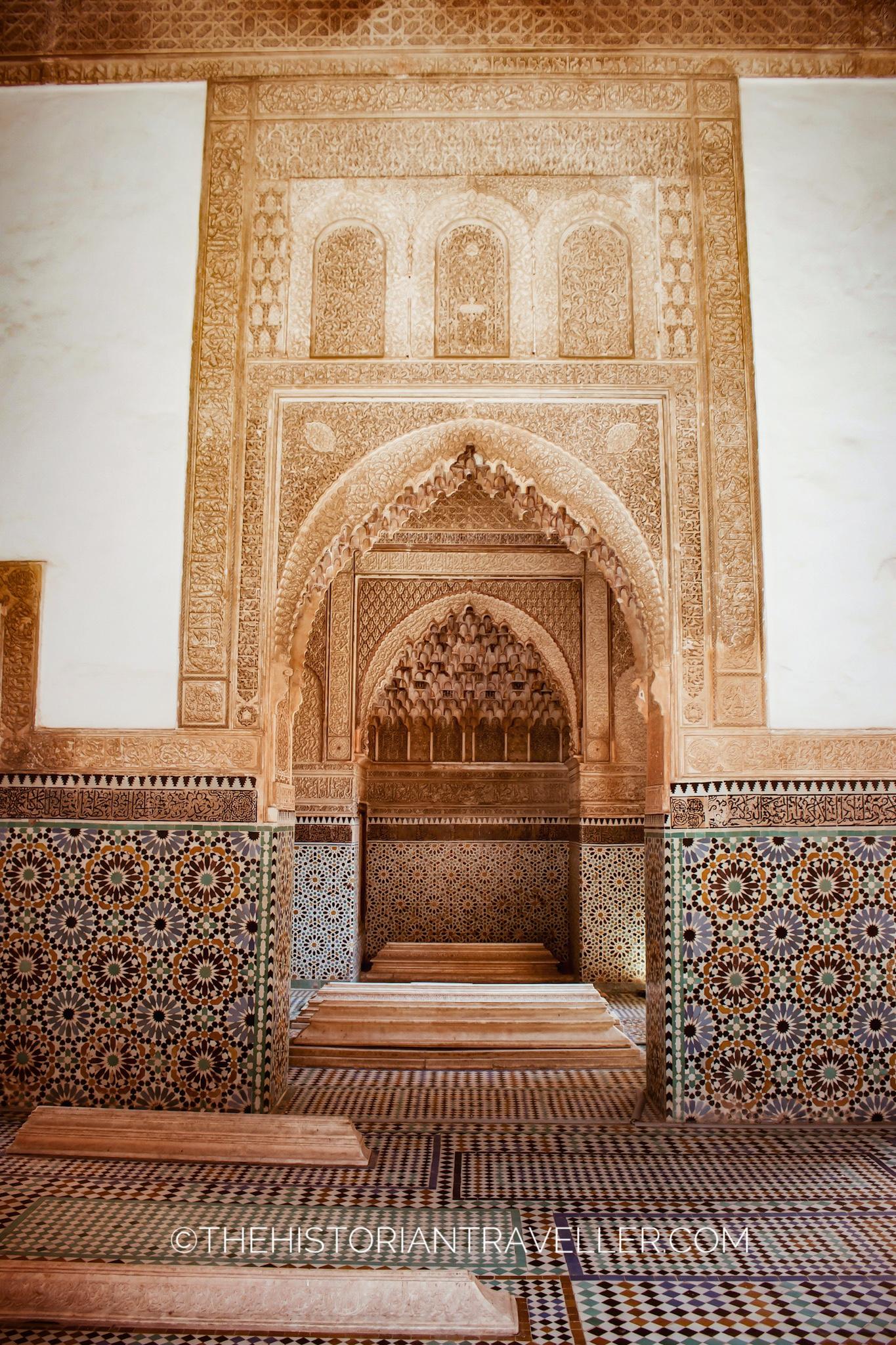
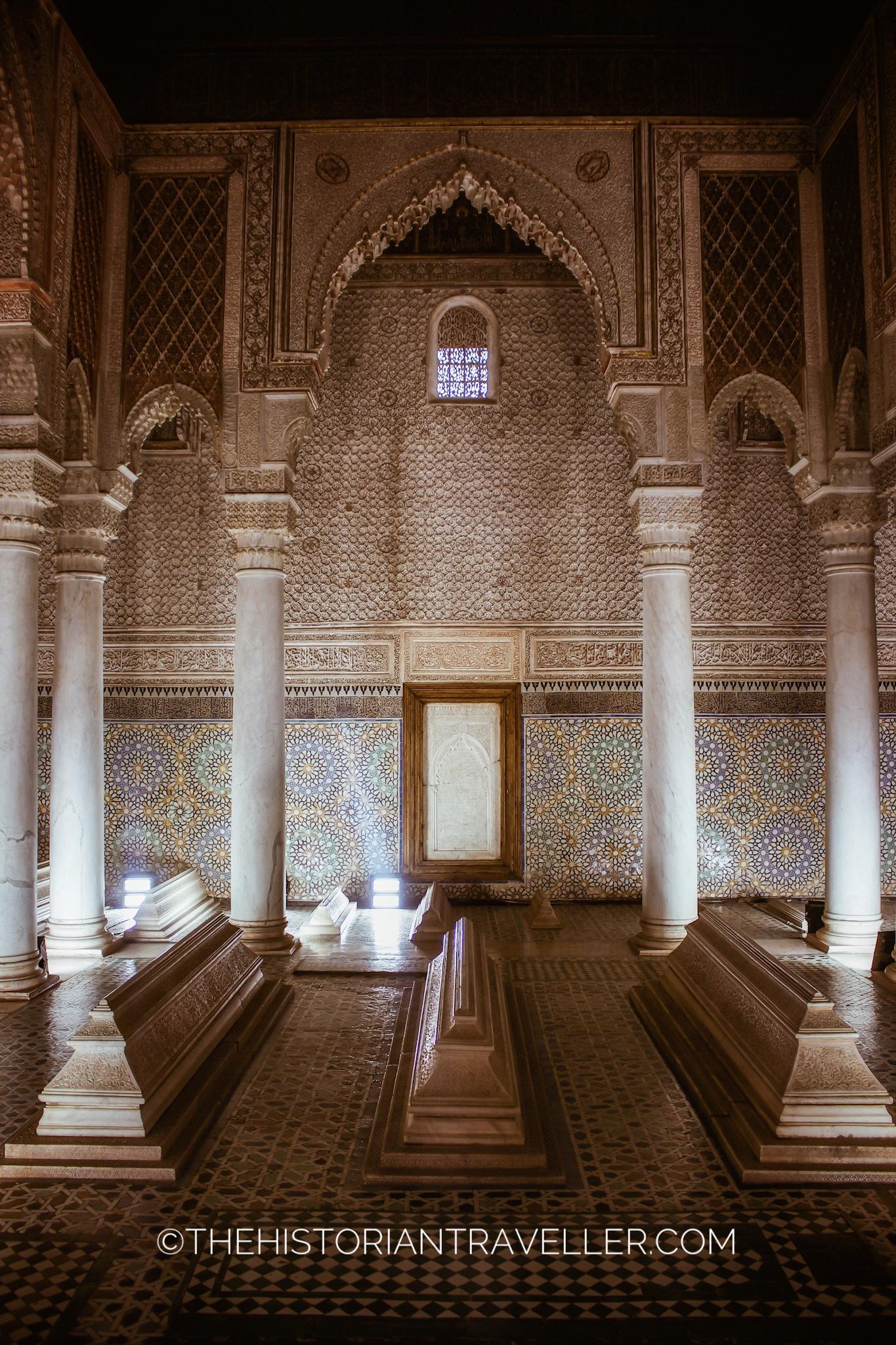
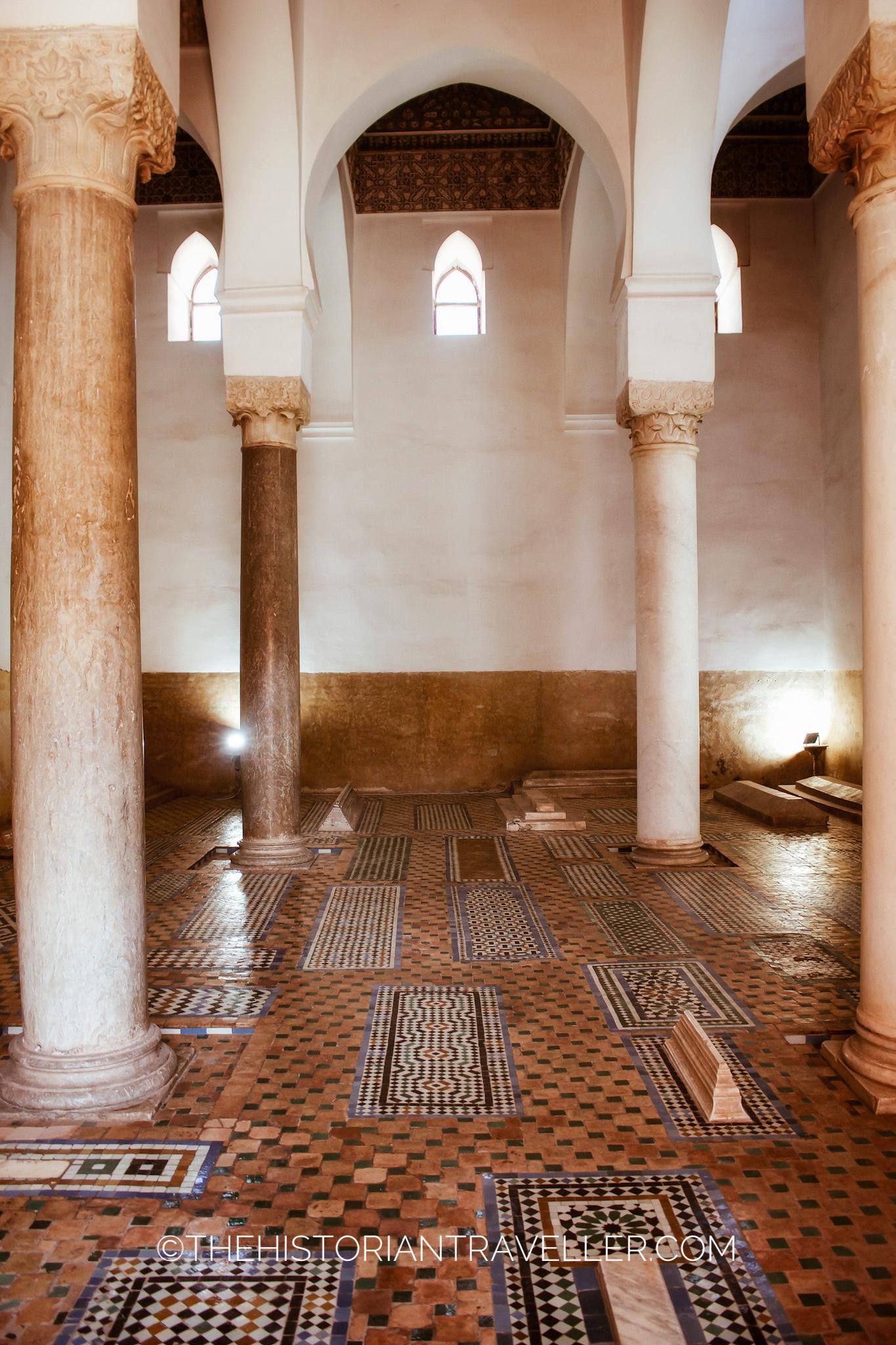
Close to the Badi Palace, the Saadian Tombs are a historical necropolis of Marrakech. Here are buried the corpses of about 60 relevant Saadians including the Sultan Al-Mansour, his successors and his family. The burial site was built in the 16th century but for centuries was known only to the royal family and their relatives. Indeed, visiting such site can be considered a privilege as it was considered one of the “forbidden” places in Marrakech until the beginning of its restoration in 1917. General public was allowed to visit from 1920. However, even now tourist can see the marvellously decorated rooms only from specific openings in the walls without entering the actual chambers.
One of the most impressive chambers to visit is the Chamber of the Twelve Columns. This is the most richly decorated chamber in the entire necropolis, generally considered the highlight of the complex. To note the chamber is visible only from a small opening in the walls, this creates long queues in the garden.
Entrance Fee: 70 DH
Koutoubia Mosque
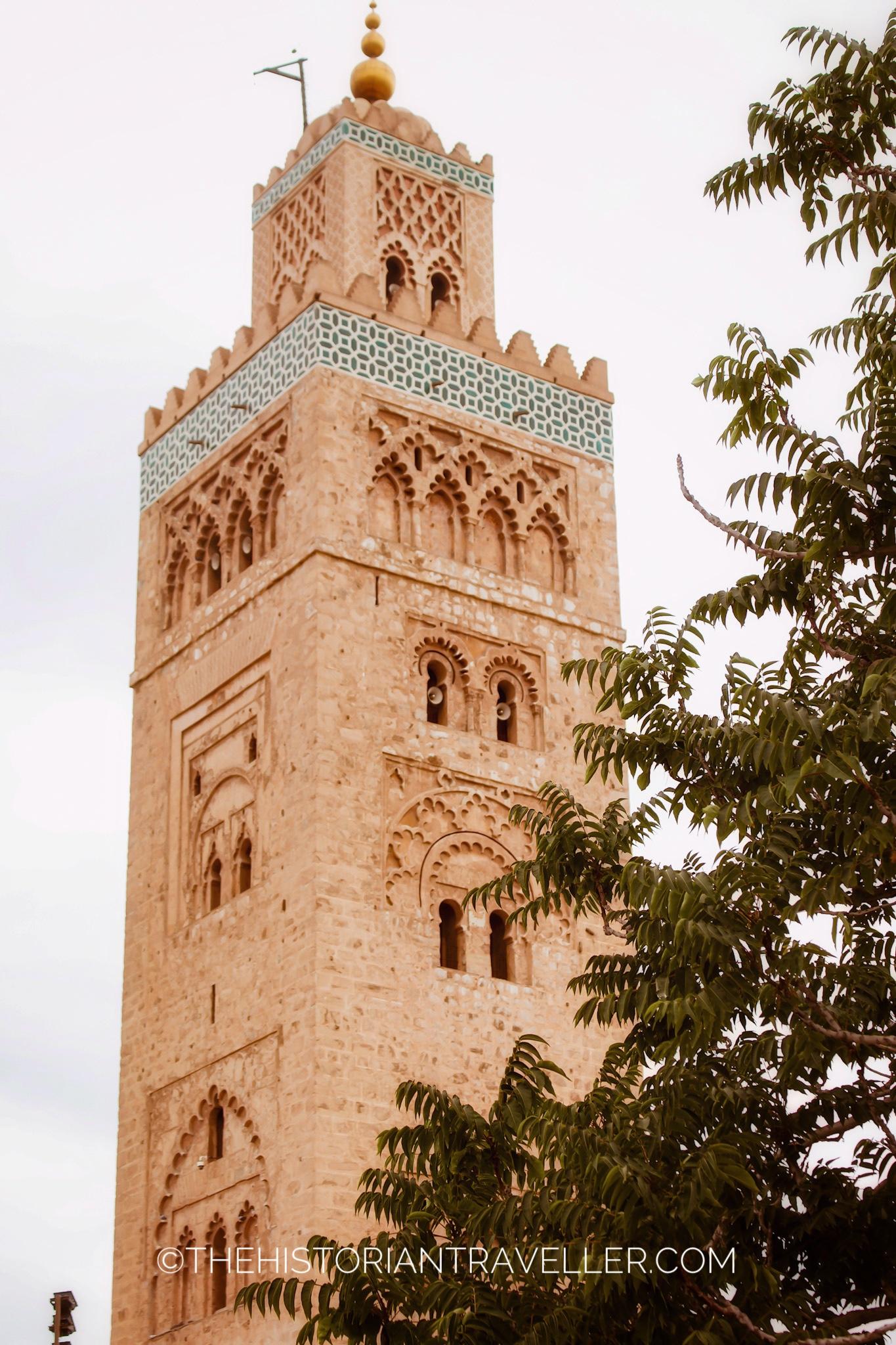
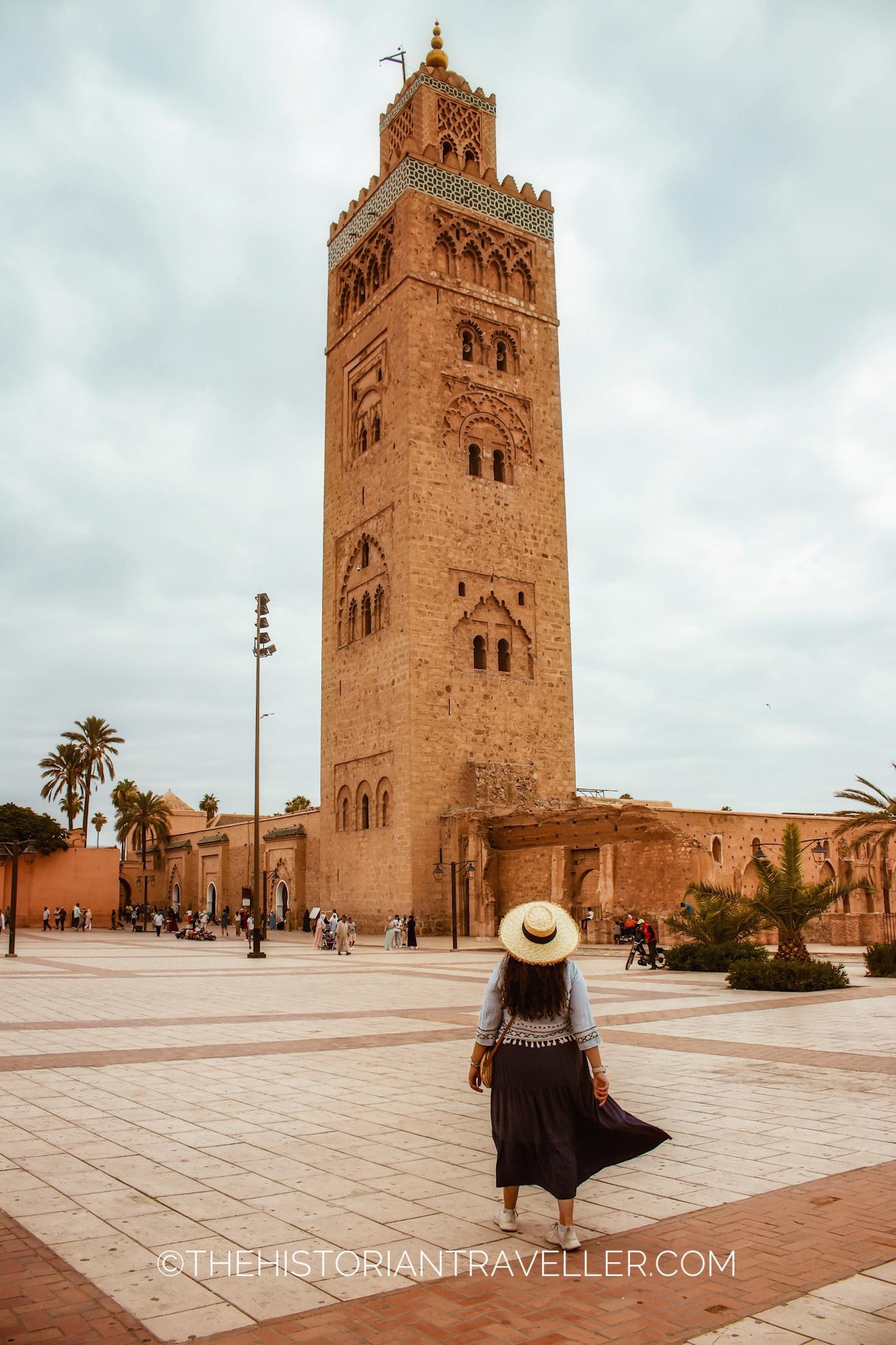
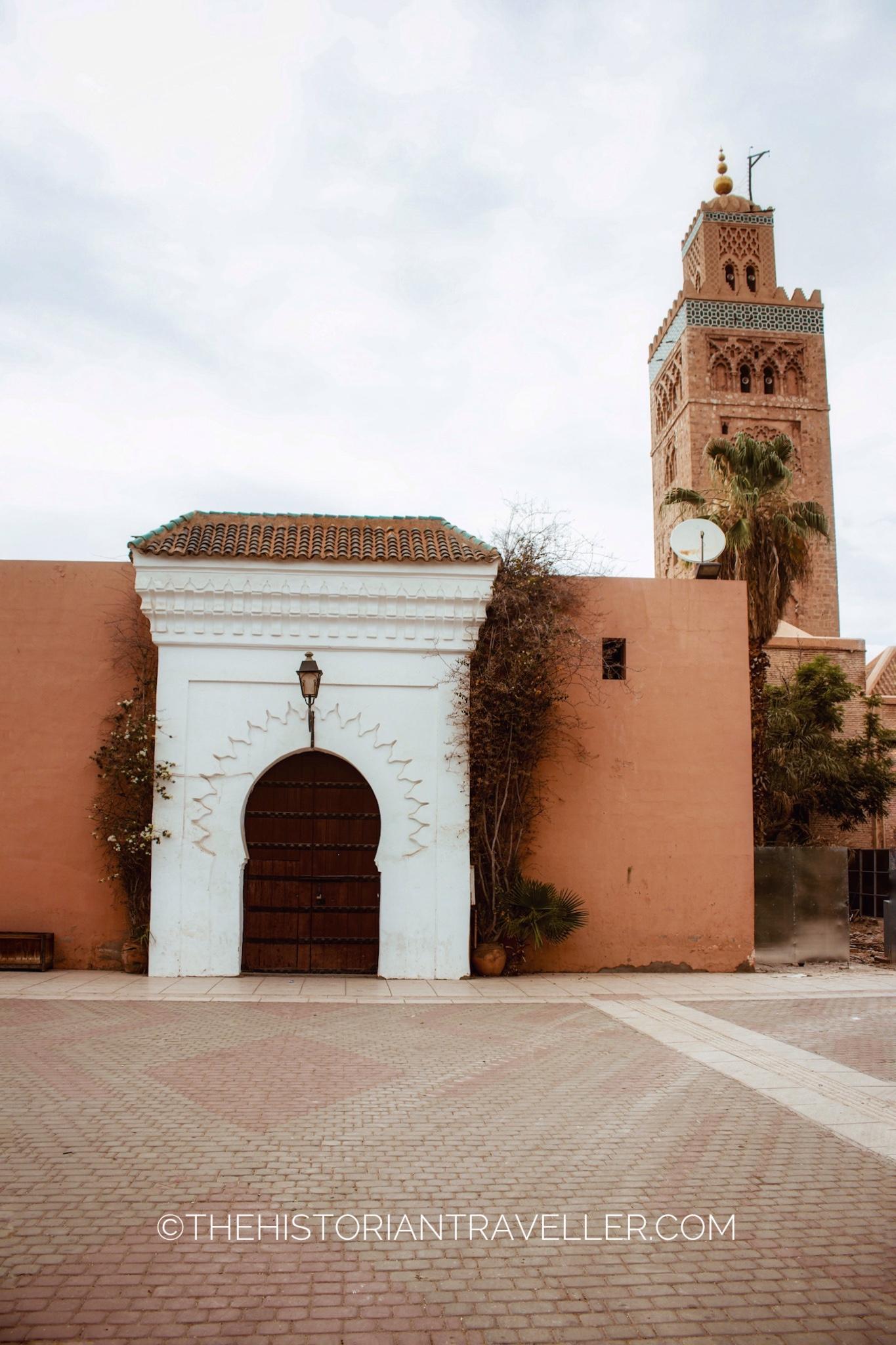
It’s easy to say the Koutoubia Mosque is one of the most important symbols of Marrakech. Just at 200 mt from Jemaa el-Fnaa, the imposing minaret of the mosque elevating at a height of 77 mt is well visible almost from every angle of the square.
The story of the Koutoubia Mosque is quite interesting as it looks like the current mosques is called “Second Koutoubia Mousque” because built over or adjacent to the “First Koutoubia Mosque”. This first mosque was built in 1147 while the second in Between 1158 and 1195. For some time, it is recorded the two mosques appeared as unique grand mosque for a certain period of time until the first one was abandoned/dismantled and its remains forgotten until 1923 excavations. Surviving parts of the first mosque are still visible on one side of the current Koutoubia Mosque.
Tourists, unless Muslim can’t access the mosque. Ergo, most people visit just its outdoor ground and the lovely nearby gardens.
Jardin Majorelle
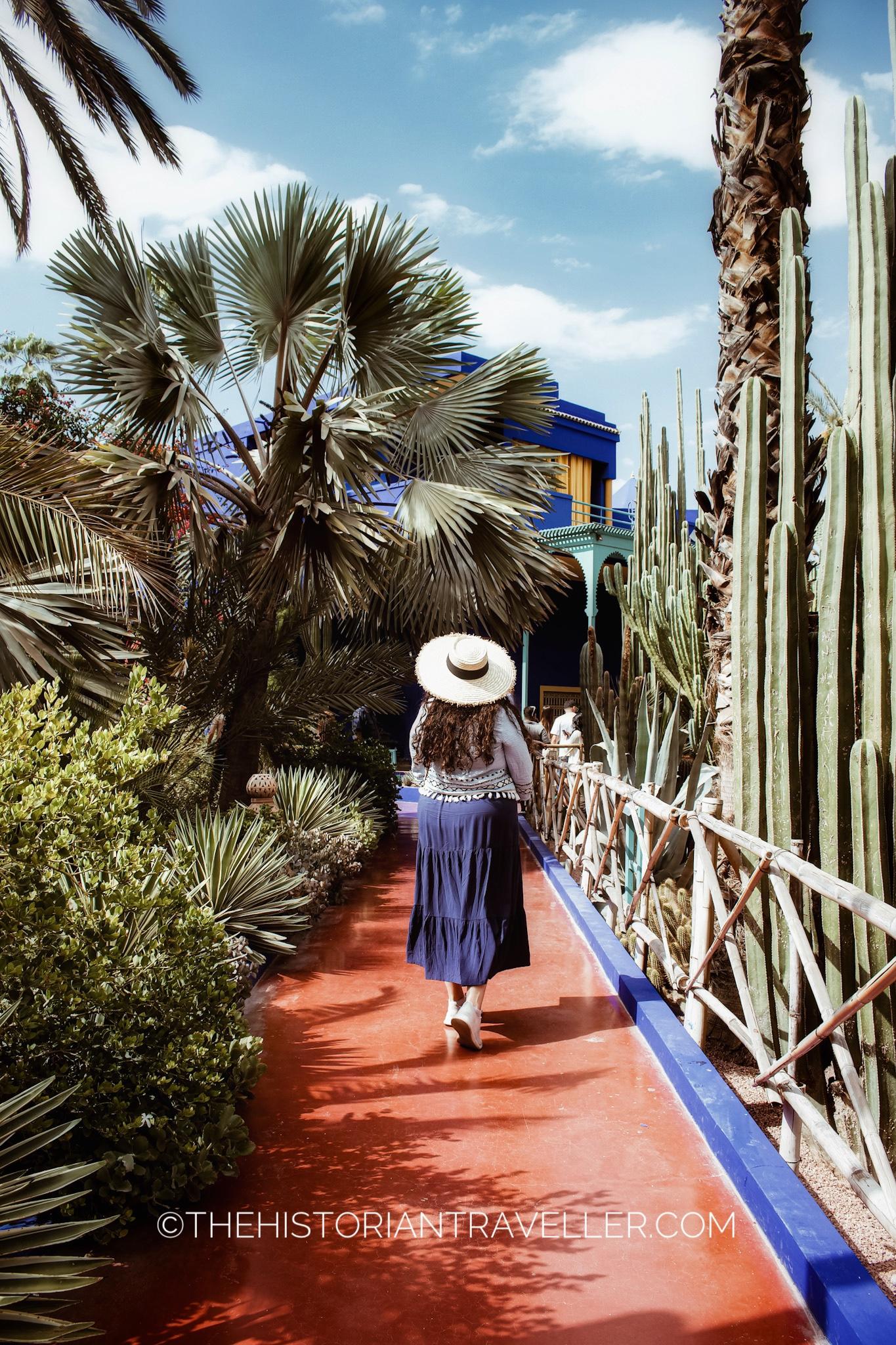
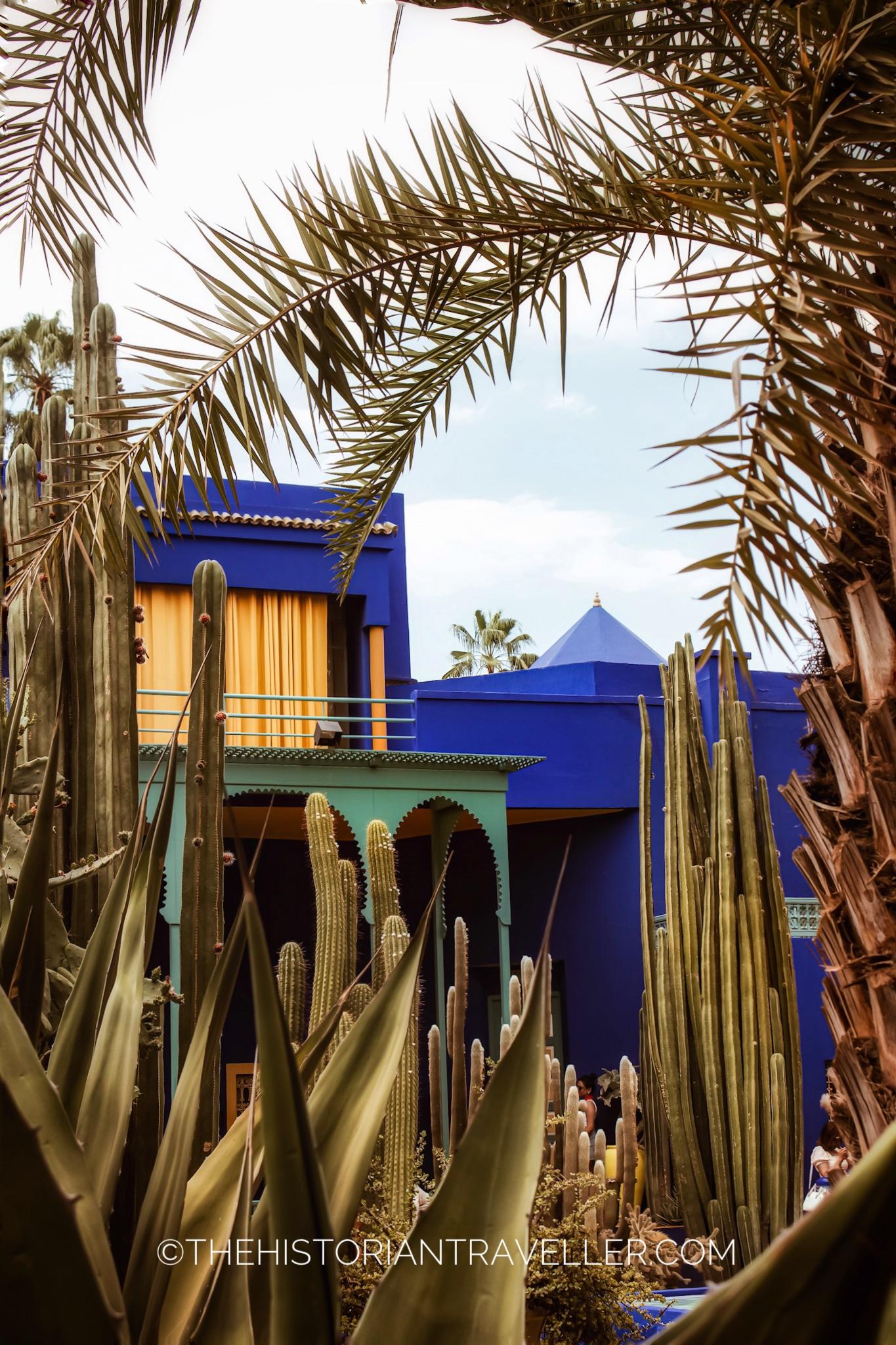
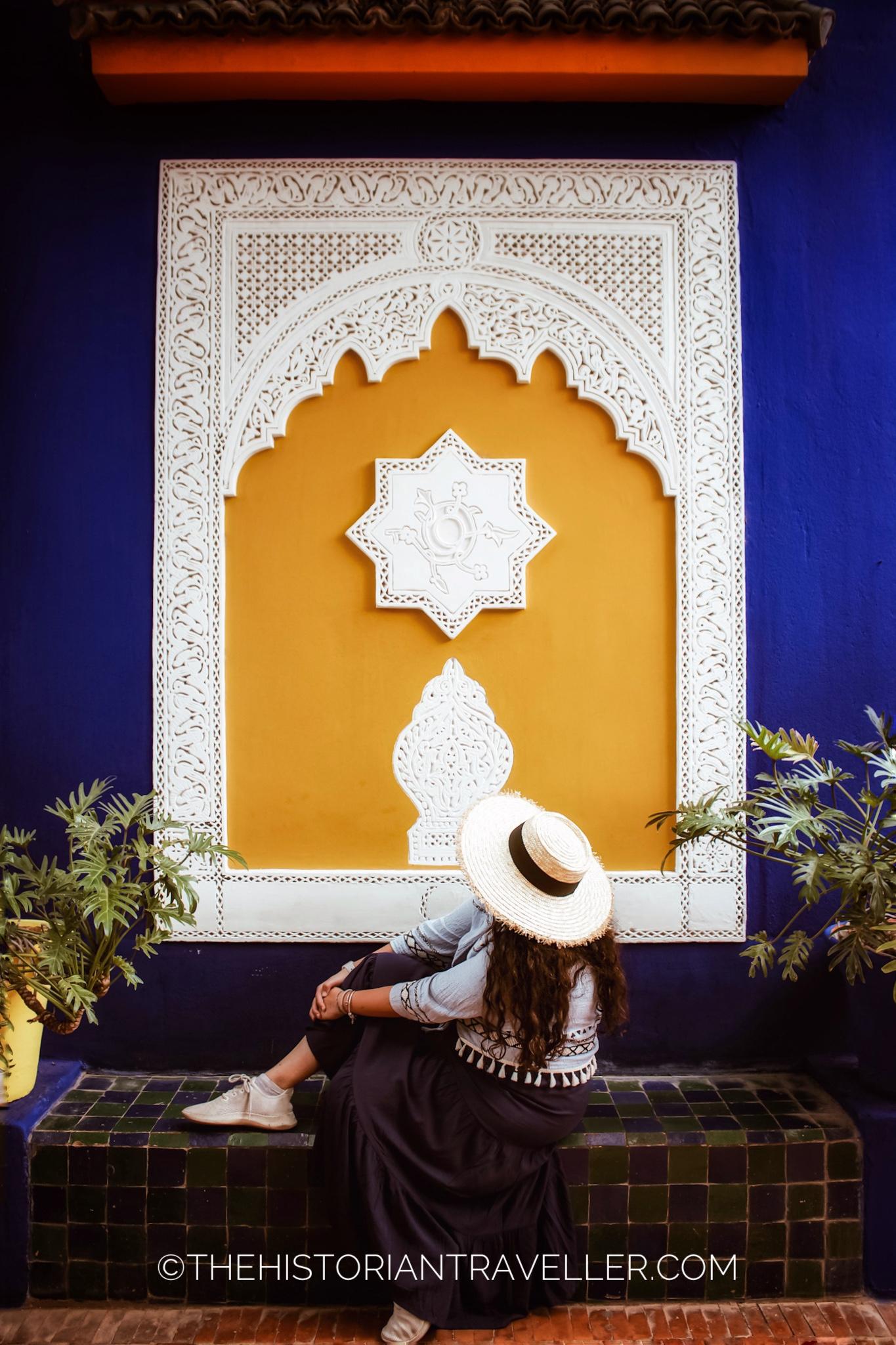
Belonging to a much more recent history, Jardin Majorelle is one of the most popular spots in Marrakech. The botanical garden was created by the French artist and Orientalist, Jacques Majorelle while the Cubist house was designed by the French architect, Paul Sinoir in the 1930s with the walls painted in the original colour “Bleu Majorelle”. The property used to be the main residence of Jaques Majorelle until 1950, but after his death in 1967, fell in disrepair. In 1980, the property was purchased by the fashion designers, Yves Saint-Laurent and Pierre Bergé who worked to restore it. After the death of Yves Saint Laurent in 2008, Pierre Bergé
donated the Jardin Majorelle to the Fondation Pierre Bergé –Yves Saint Laurent.
Nowadays, the property is managed by the Majorelle Foundation and includes a museum dedicated to the Berber Culture, the Yves Saint Laurent Museum and a small cafe.
To visit Jardin Majorelle and its museums it is mandatory to book online via this link. Prices vary according to the ticket. Jardin Majorelle only is 150 DH, while the combined ticket is 300 DH.
2. Stay in a Riad
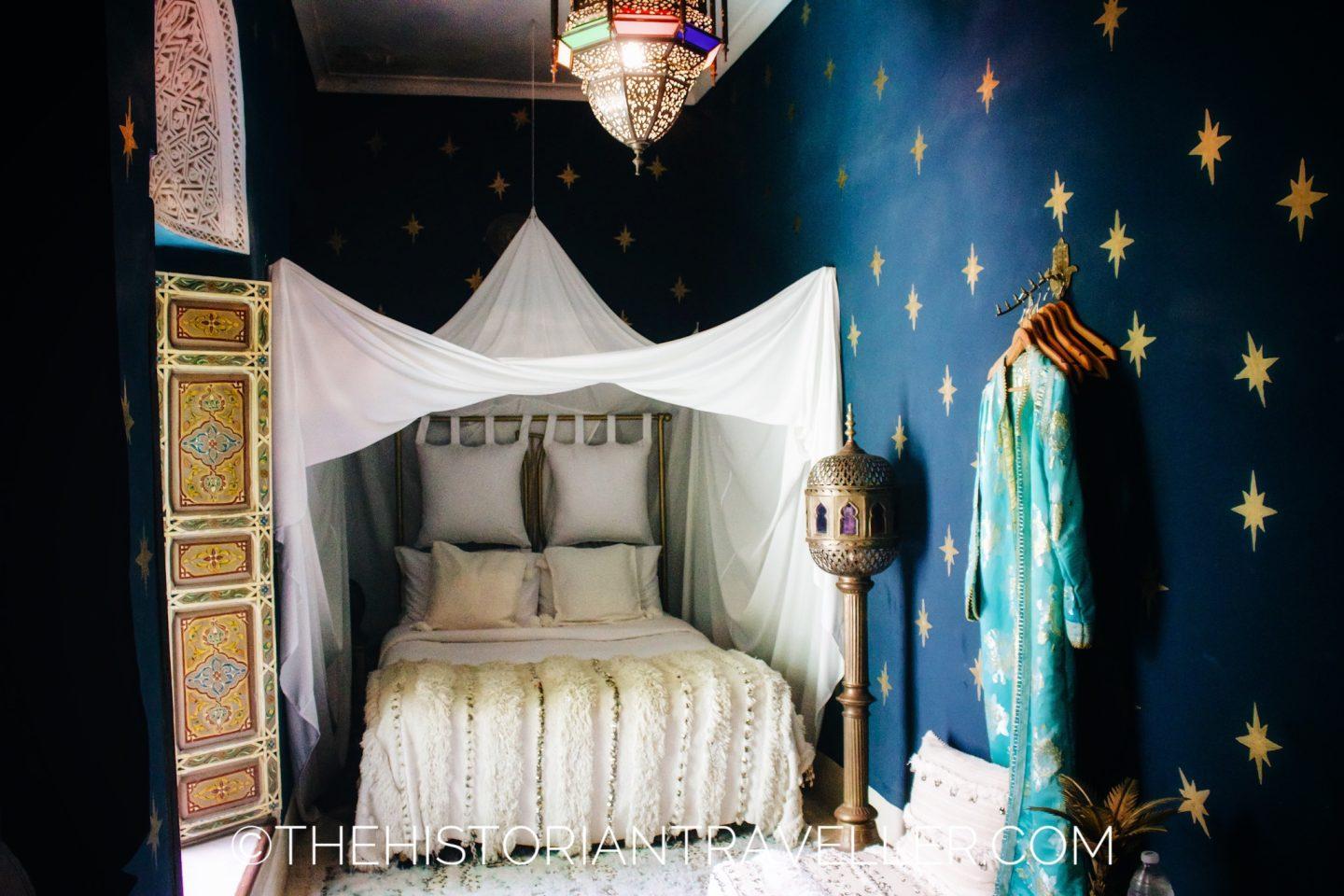
Visiting Marrakech without staying in a riad is like going to Italy without trying pasta! Staying in a riad in Marrakech is a must-do experience that will enrich your stay and show you a totally different way or living your holiday. But for those who never heard this term before…
What is a riad?
For someone who has never heard about these types of accommodations before, it’s difficult to have a clear picture of how they differ from general hotels. In the Arabic language, the word Riad means ‘garden’. This is a type of domestic architecture that historically originated in the Middle East, particularly in Persia. During the Middle Ages, this architecture arrived in Spain as well as in Morocco. Indeed, one of the most famous riads in the world is the Generalife in the Alhambra complex. In Morocco, riads are the historical houses that feature one or more stories around an interior garden featuring a fountain. Traditionally, the centred gardens of the riads were full of fruit trees like oranges or lemons.
Don get confused between Riad and Dar. Indeed, differently from riad, the word ‘dar’ means house. This type of domestic architecture is similar to the riad featuring a multi-storey accommodation. However, instead of a garden, dar usually feature a central patio. Dar are also smaller than riads and don’t have a central fountain.
What are the advantages of staying in a riad?
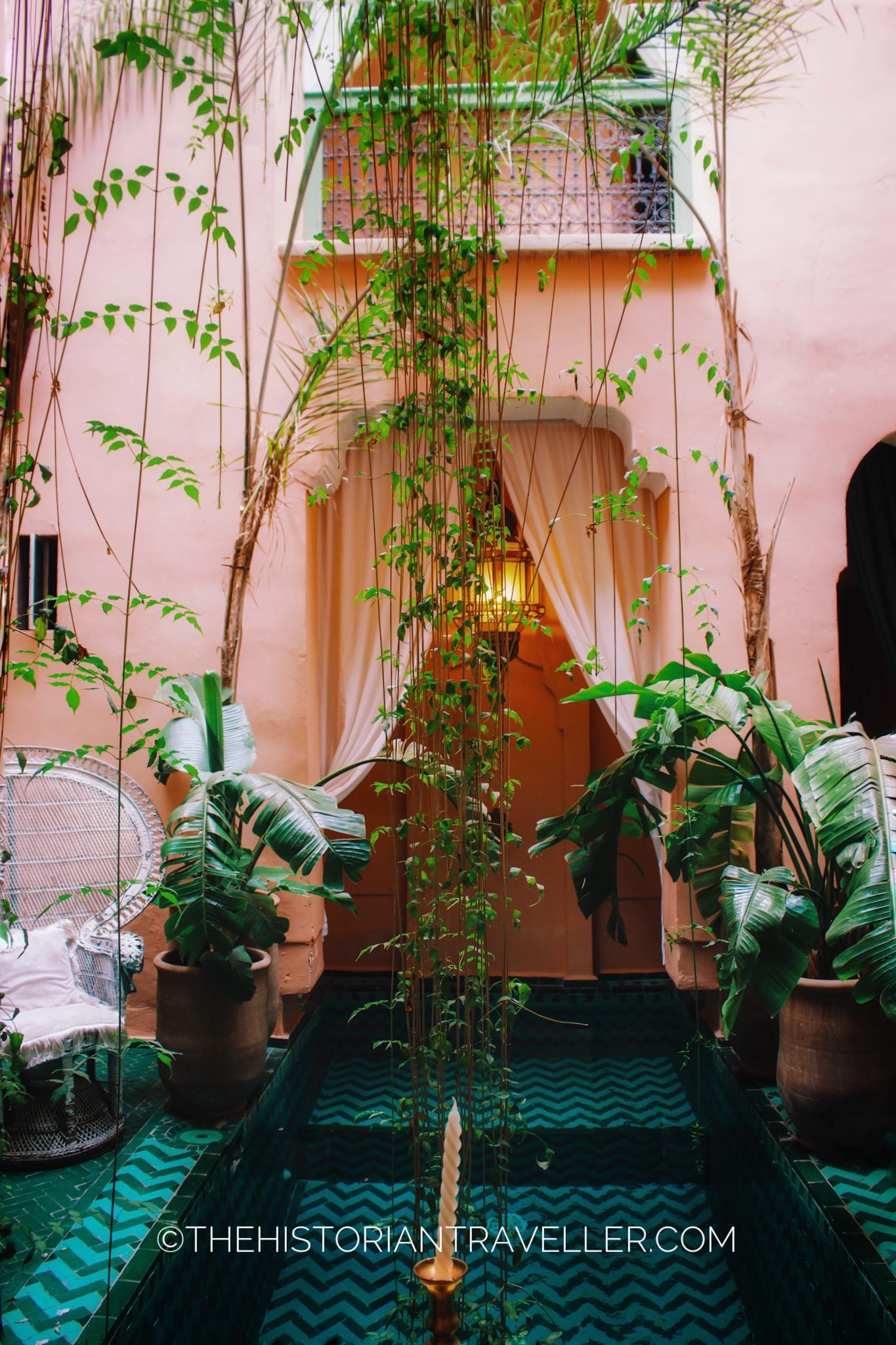
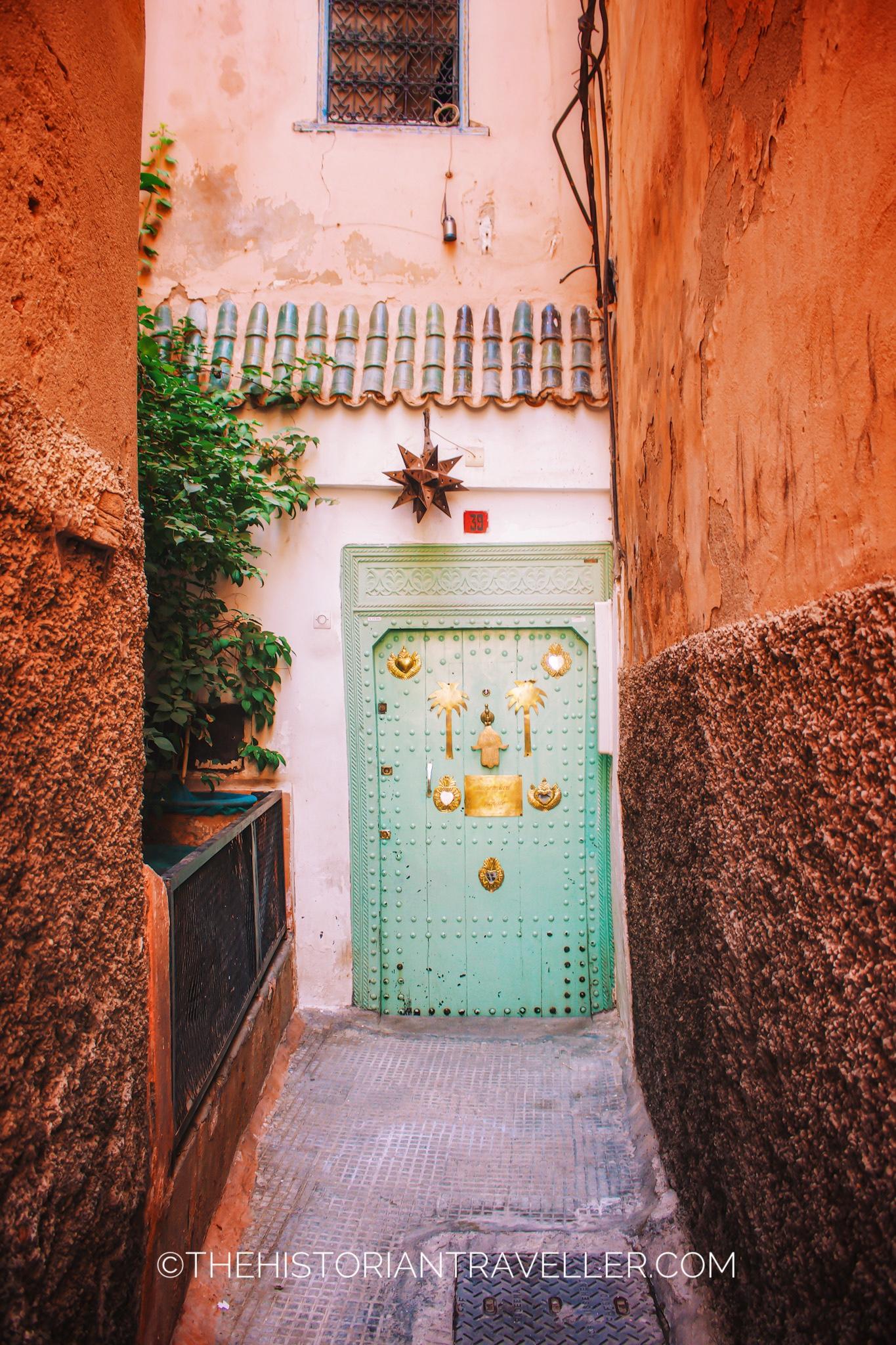
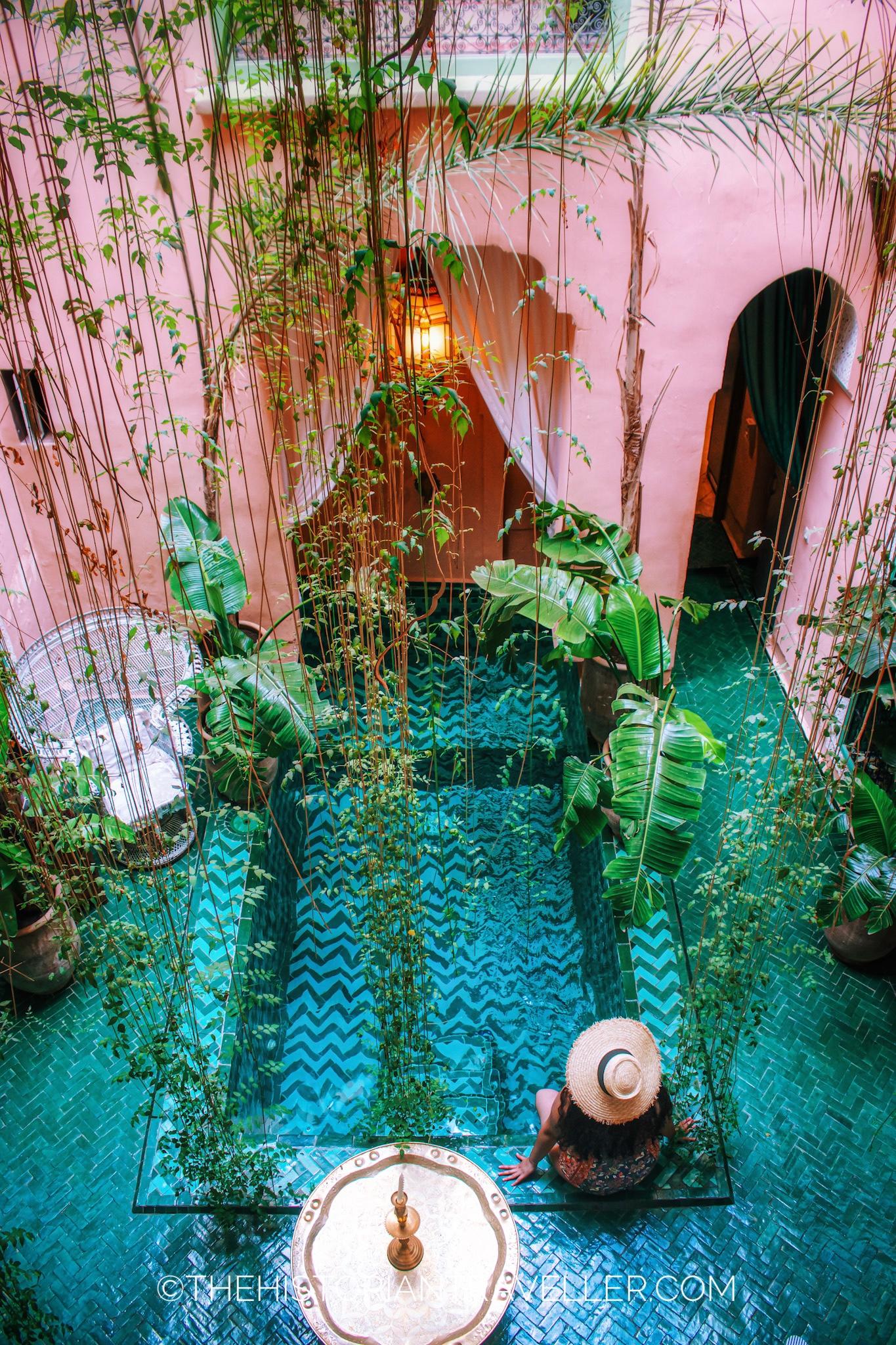
I am firmly convinced that a visit to Morocco, particularly in Marrakech, can’t be considered fulfilled without a stay in a riad. I know that many prefers the comfort and luxury of modern hotels (that in Morocco are most of the time located well-out of the medinas). BUT riads have their own unique charm. There are many advantages of staying in a riad compared to a regular hotel. First, most of these accommodations are real piece of history. Some of them have been saved from destruction, some other are rare jewels of architecture. Staying in a riad is a unique occasion of catching a glimpse of Morocco’s history all in one go.
Second, they are relatively small. Indeed, many riad have 4 to 10 room at maximum. This will grant you a major attention from the staff, more privacy and better service than the one you can have in a massive hotel with hundreds of other guests. A further bonus point is that if you are lucky, you might be even the only guest having an entire riad all by yourself! This happened to us at the lovely Riad Idrissy in Fes where for two straight days we’ve got a fantastic property all for ourselves! This granted us also an upgrade to the suite with a lovely private terrace!
Lastly, historical and authentic riads are located inside the medinas in Morocco. This will grant you a car-free experience and the opportunity to have most landmarks at a walking distance from your accommodation.
How to choose a riad in Marrakech?
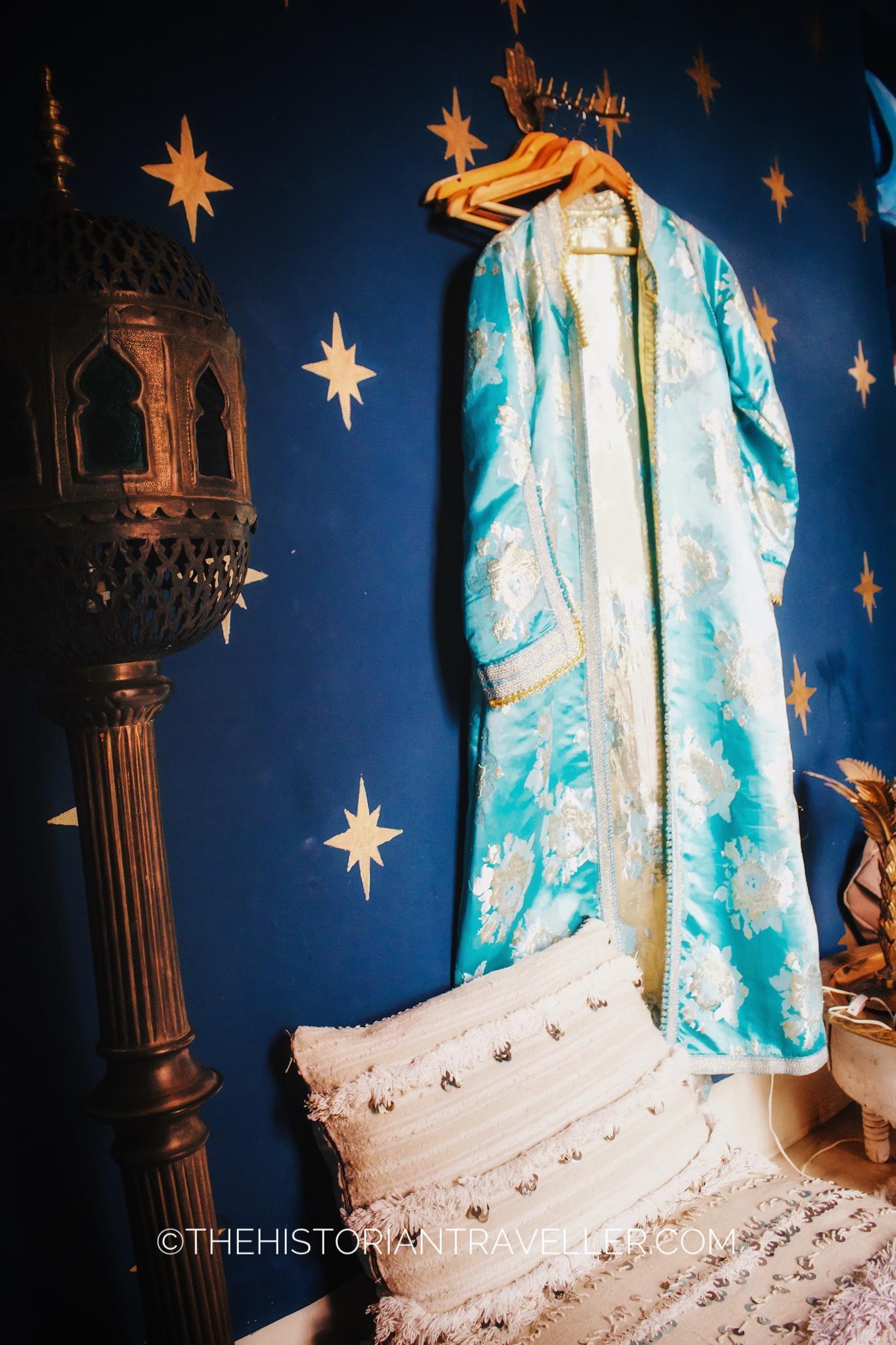
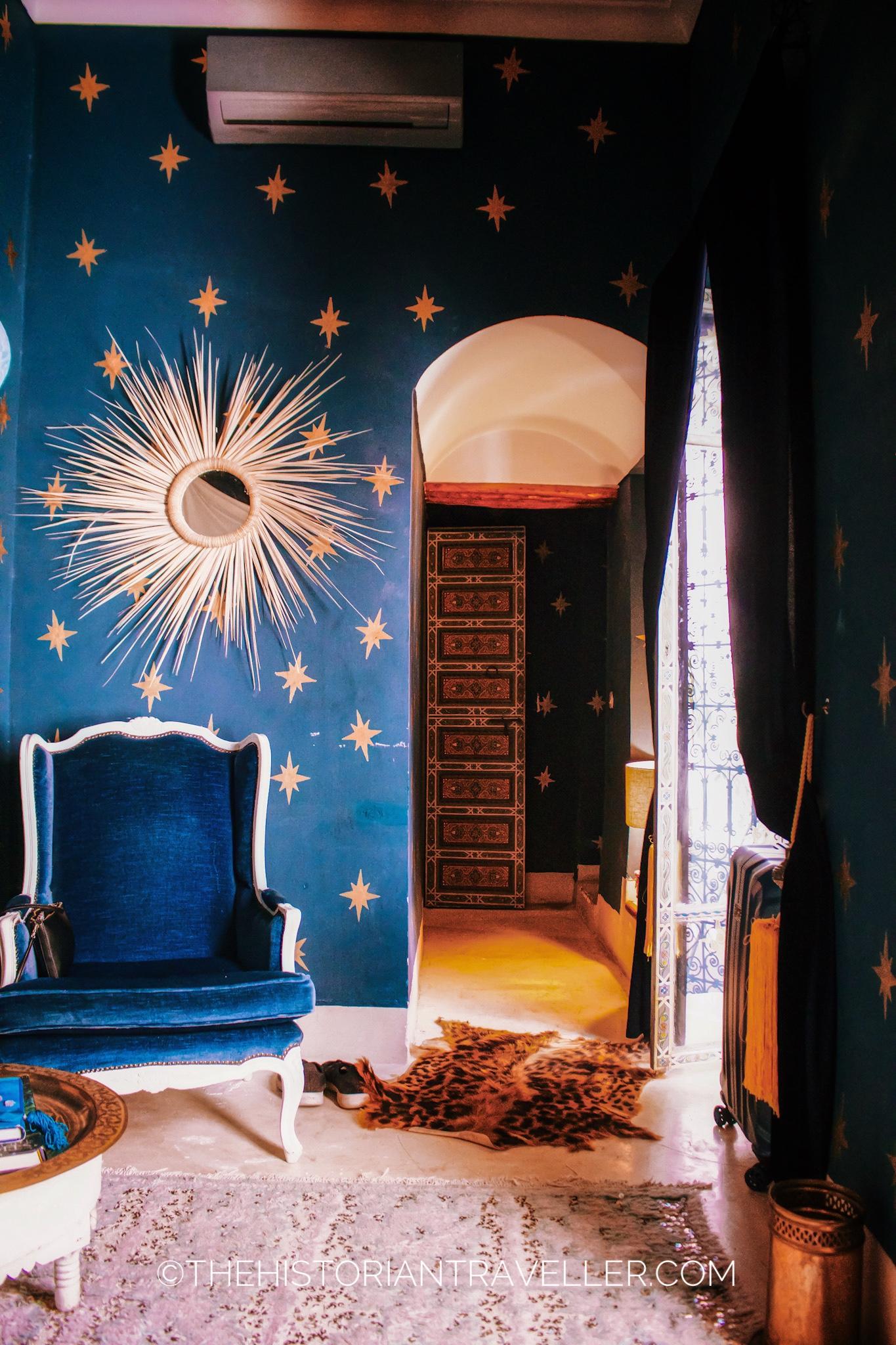
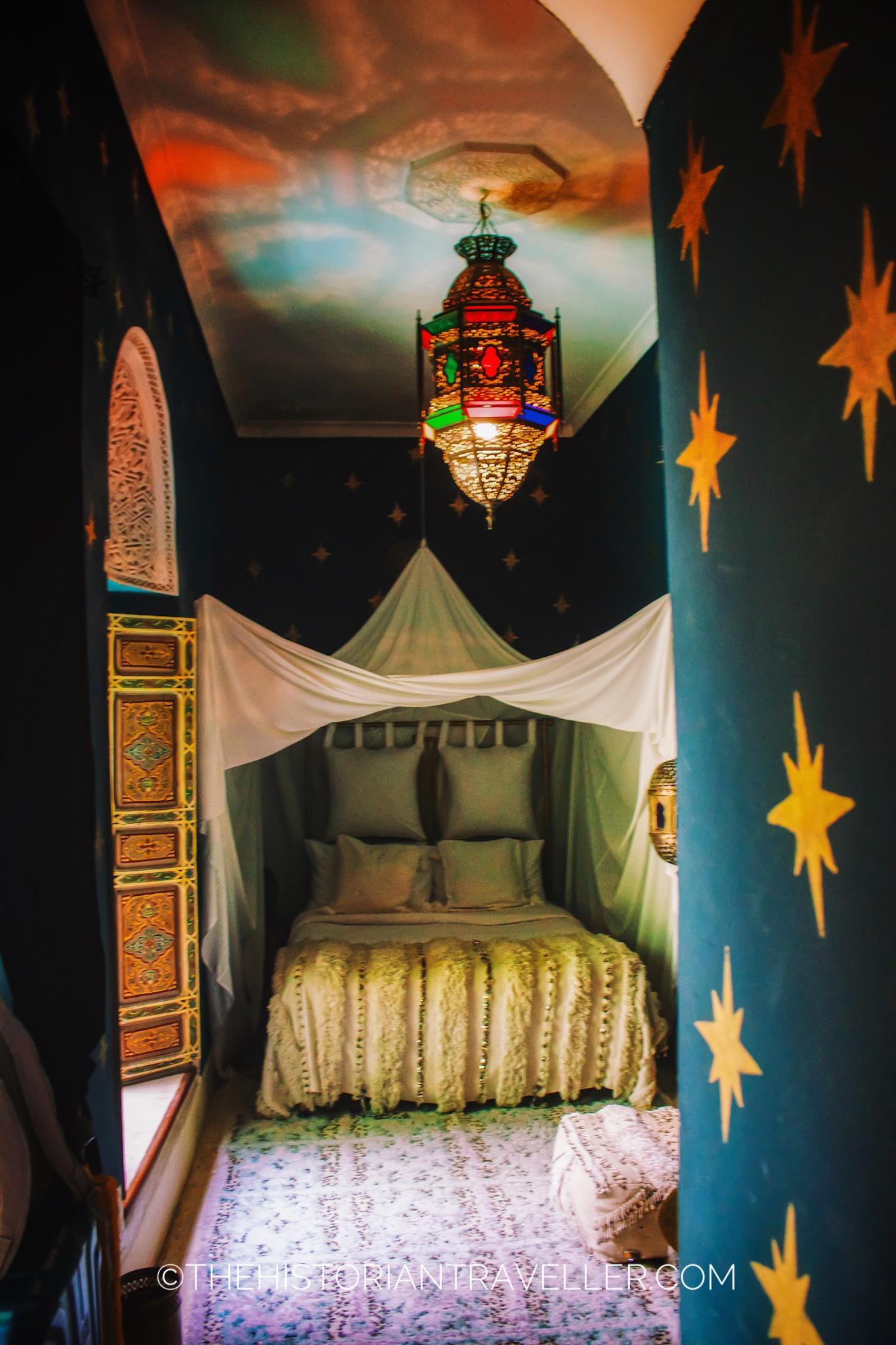
I admit that choosing a riad in Marrakech wasn’t very easy. This because there is too much offer and lovely places that is actually very hard to decide. Therefore, my decision was dictated mainly by 3 criteria. Reviews, position and aesthetic (in any particular order). Reviews are quite important to me in my decision of where to stay. Regardless of the category, I would never stay in a place that have more bad reviews than good ones.
The position where the riad was located was an essential point to us. Indeed, many fancy hotels in Marrakech are actually out of the Medina. This has pro and cons, but if you want a direct taste of Marrakech’s culture, spend your days inside the medina is an essential part of that experience. We wanted a riad that was in a good area of the medina not too far from most places we wanted to visit.
Lastly, aesthetic. Being a photographer means that I care about aesthetic a lot. I personally love interior design especially when it’s well-curated. Therefore, I did a deep research and made a list of places satisfying my criteria. Even if I had a few nice riads at the top of my list, Riad The Bohemian Jungle was the only one having a room that looked like straight out of One Thousand and One Nights. Therefore, there was a clear winner! If you want to stay in the same room, this is called Tuareg room (each room of the riad is different).
3. Go on a Hot Air Balloon
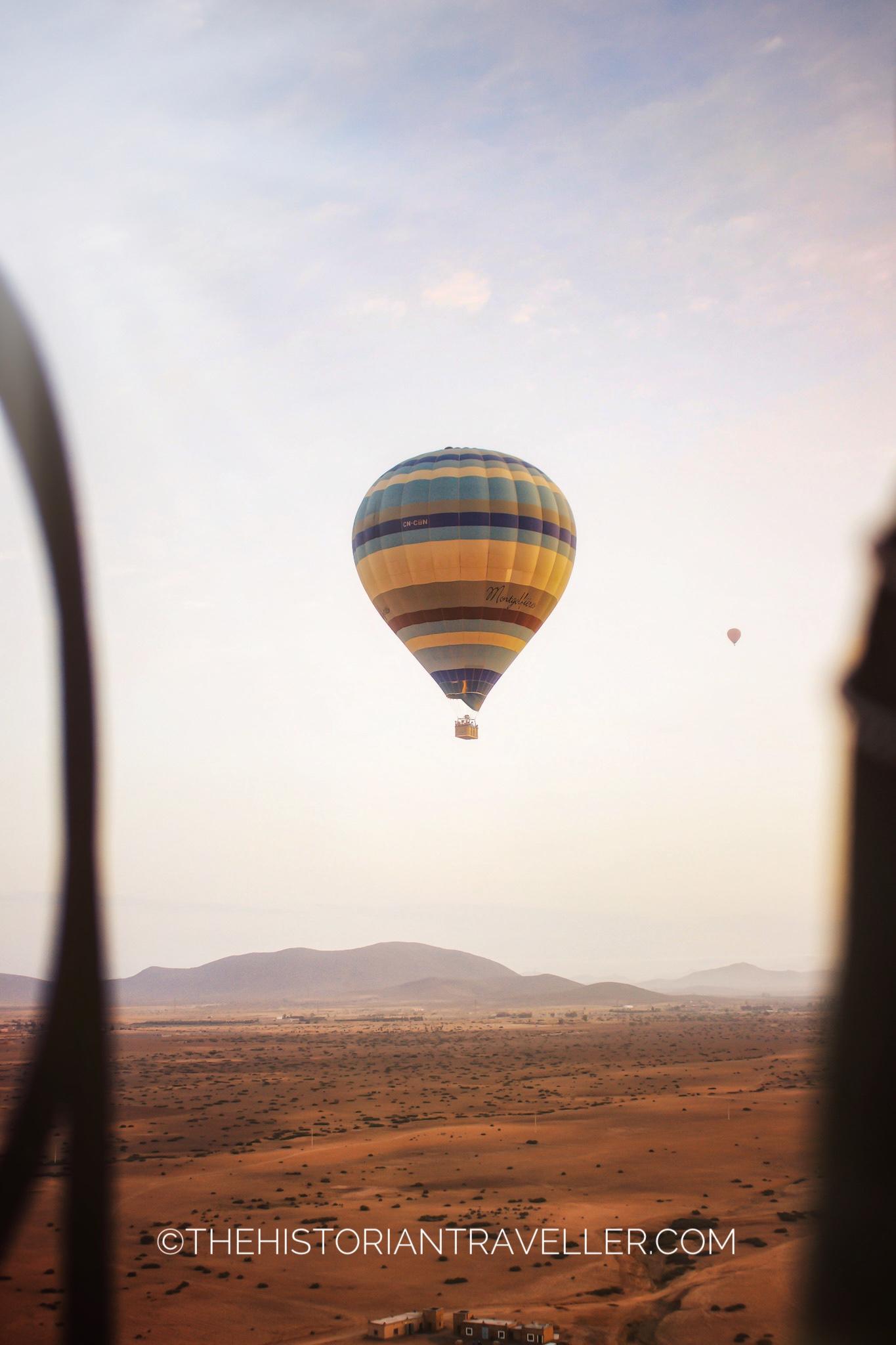
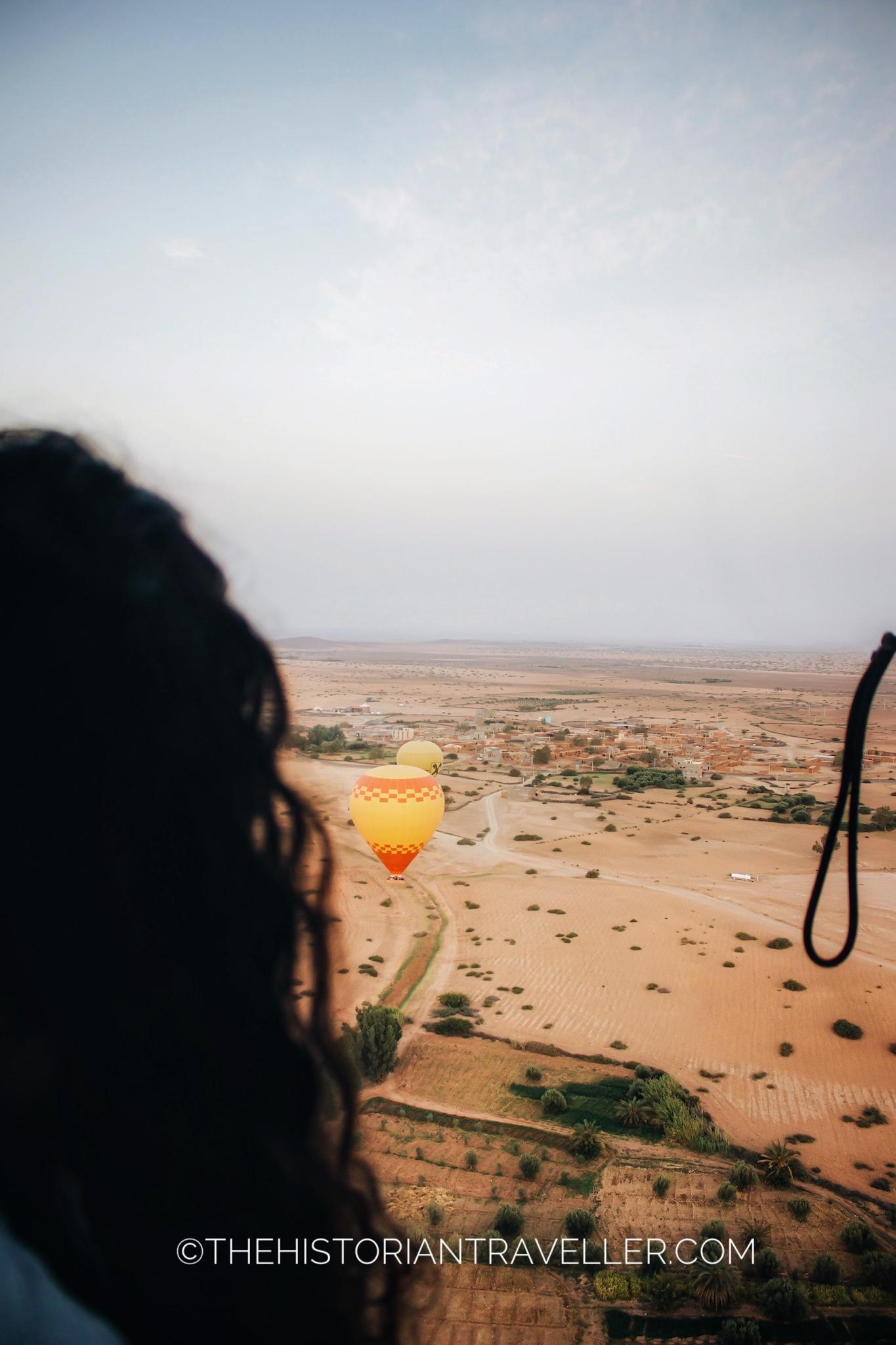
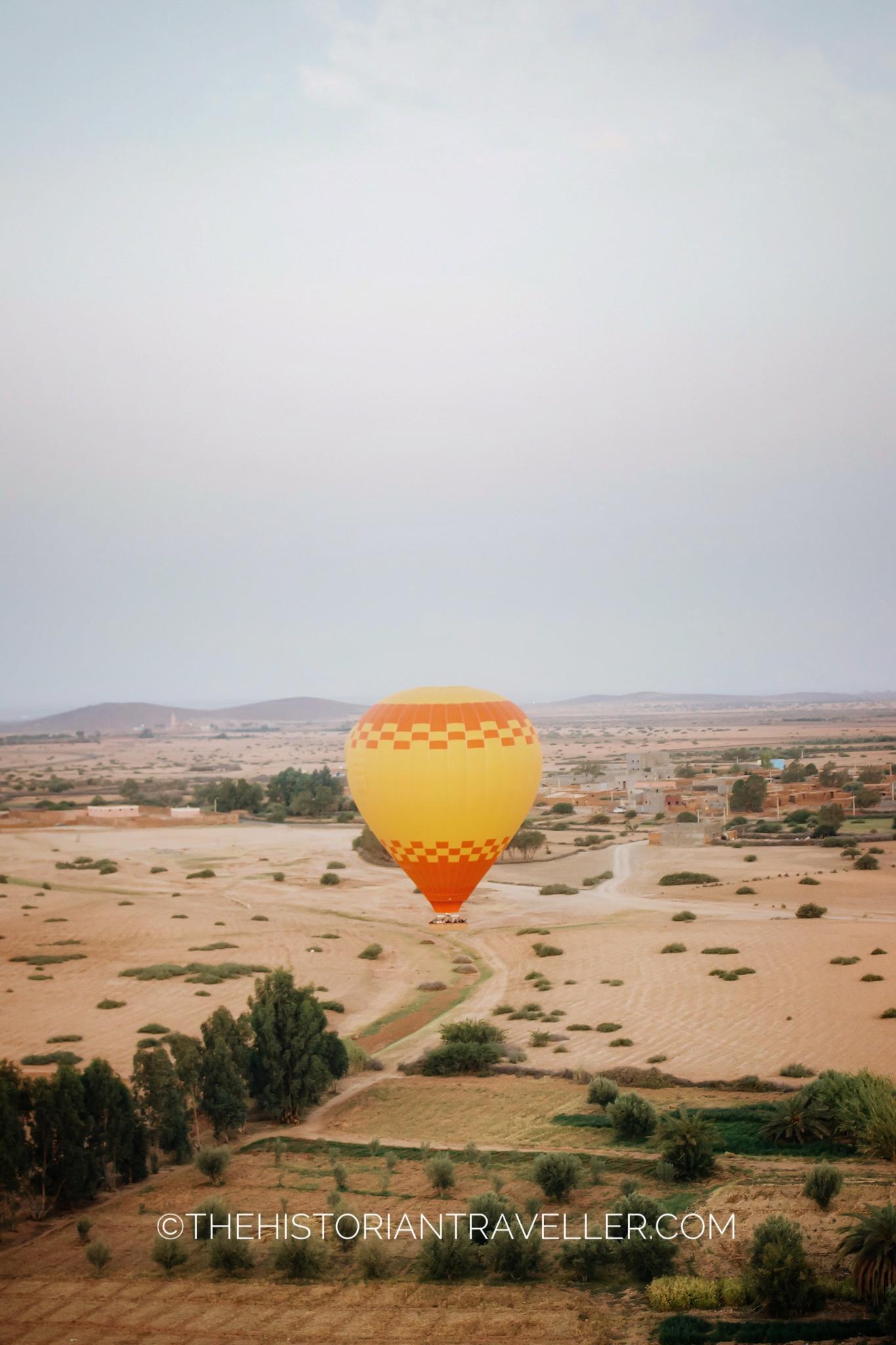
Not many know but Marrakech is a perfect hot-spot for a hot air balloon ride! Indeed, its proximity to the open land area of Palmeraie, make it the perfect place to check off this bucket-list adventure! A hot air balloon ride in Marrakech requires a very early morning wake-up, a good camera, some spare cash (flying is expensive!) and a great sense of adventure.
If you want to discover more on the topic, read about our experience with a hot air balloon in Marrakech.
4. Taste the best coffee you’ll ever have
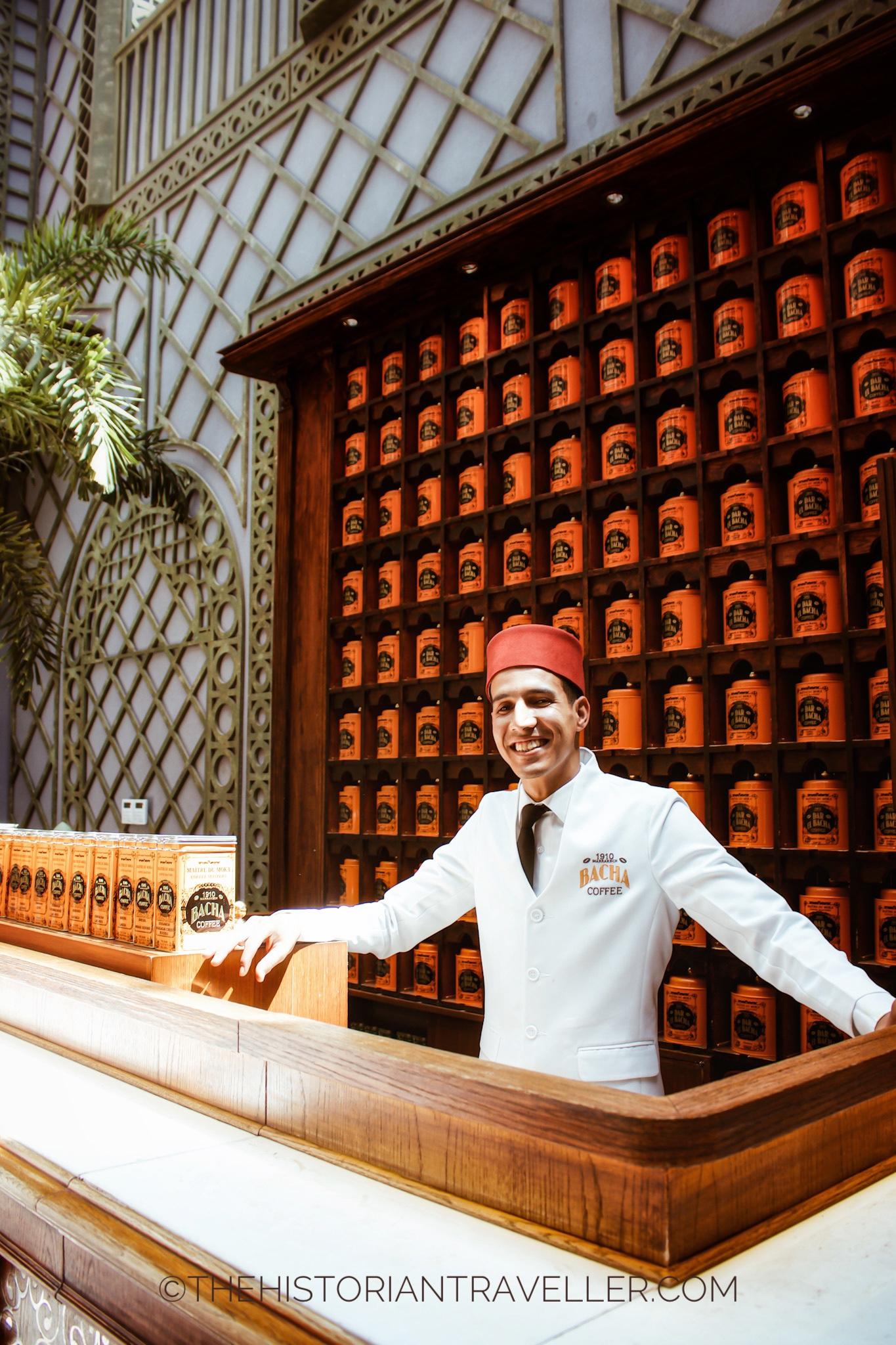
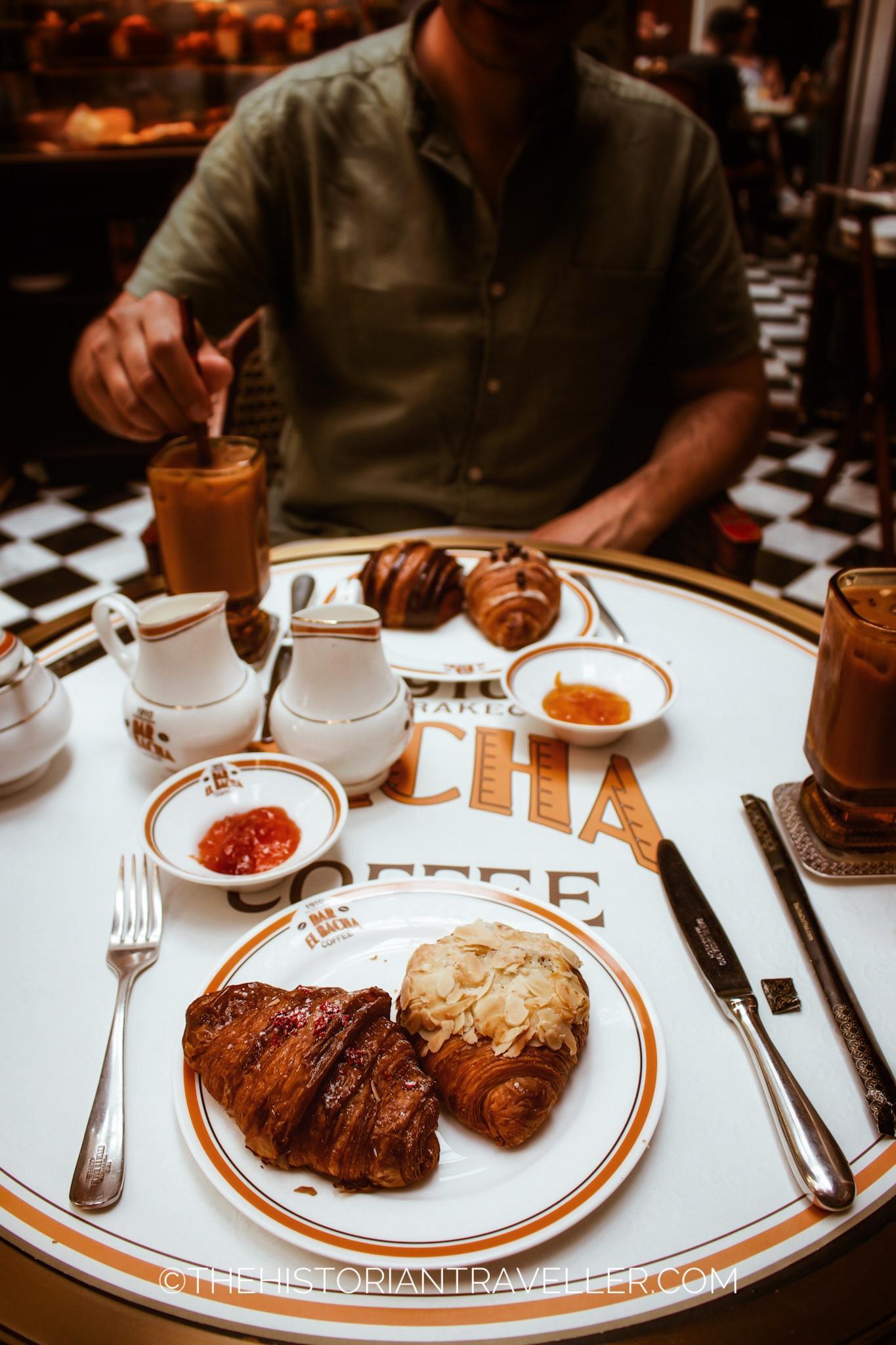
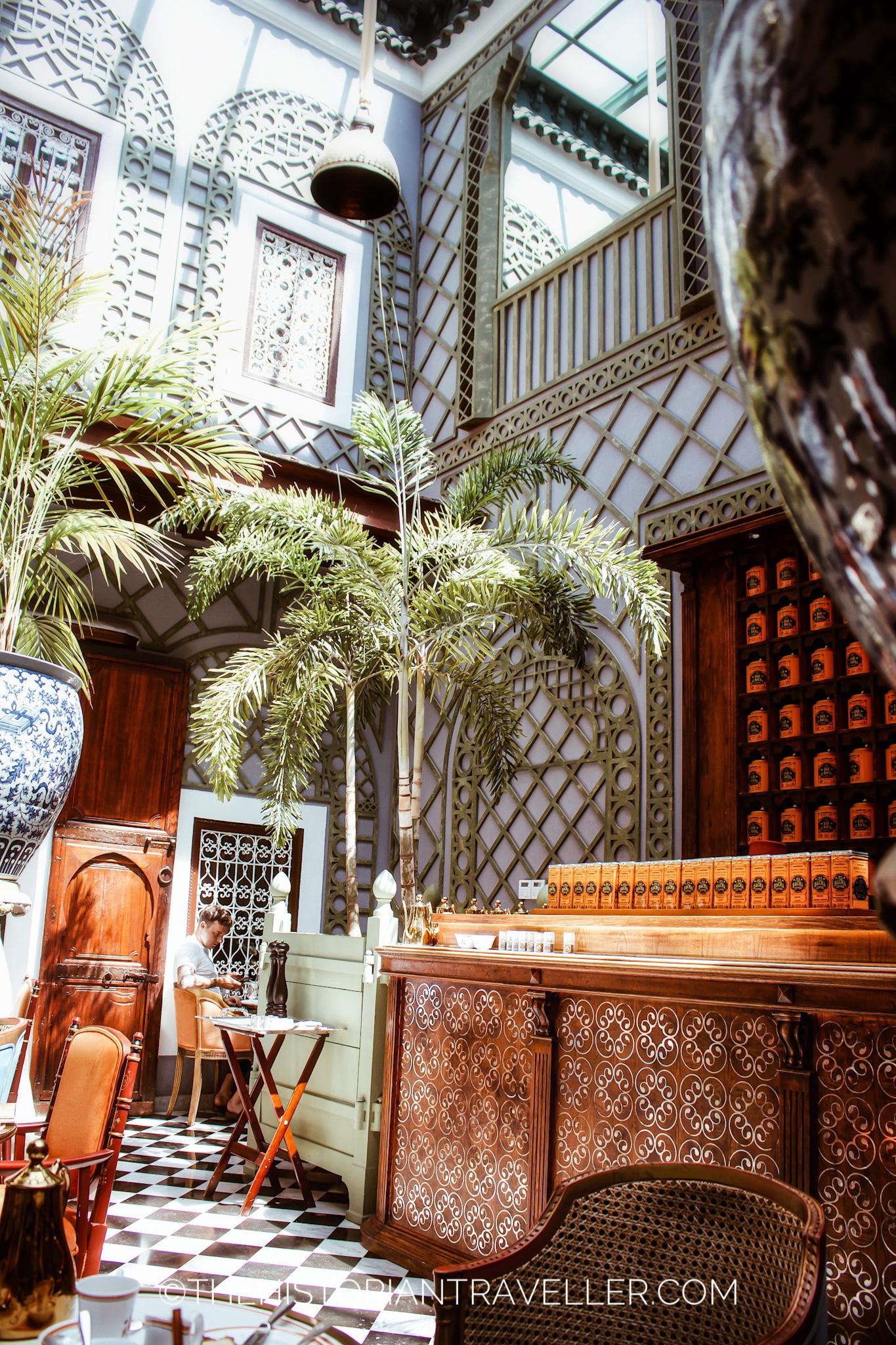
Of all the things I would expect to love in Marrakech, coffee didn’t come to my mind. When I was planning my itinerary of course I knew about Dar el Bacha and carefully planned an afternoon stop. Nevertheless, I didn’t expect that brief after-lunch coffee stop would turn into a real highlight of our trip. Built in 1910 within the stunning setting of Bacha Palace, Bacha Cafe’ is much more than a upscale coffee room. It’s an experience. Indeed, this little Cafe’ has one of the widest selections of coffee I ever seen.
This will come to your table under the form of two chunky menus with hundreds of coffee entries. I was a little overwhelmed at the beginning but the kind waiters are there ready to help and give you any information you might need on the different types of coffee. As this wasn’t enough, they have also a delicious assortment of cakes and pastries.
The only “downside” of the experience is that tables are not bookable and this place is so popular that queues might last up to 2 hours to enter. The good news is that you can use that time to visit the lovely Museum of Confluences, which is actually the palace where the cafe is located.
Entrance Fee: 60 DH (for the museum + cafe), 10 DH (only the cafe)
5. Live the Jemaa el-Fnaa experience
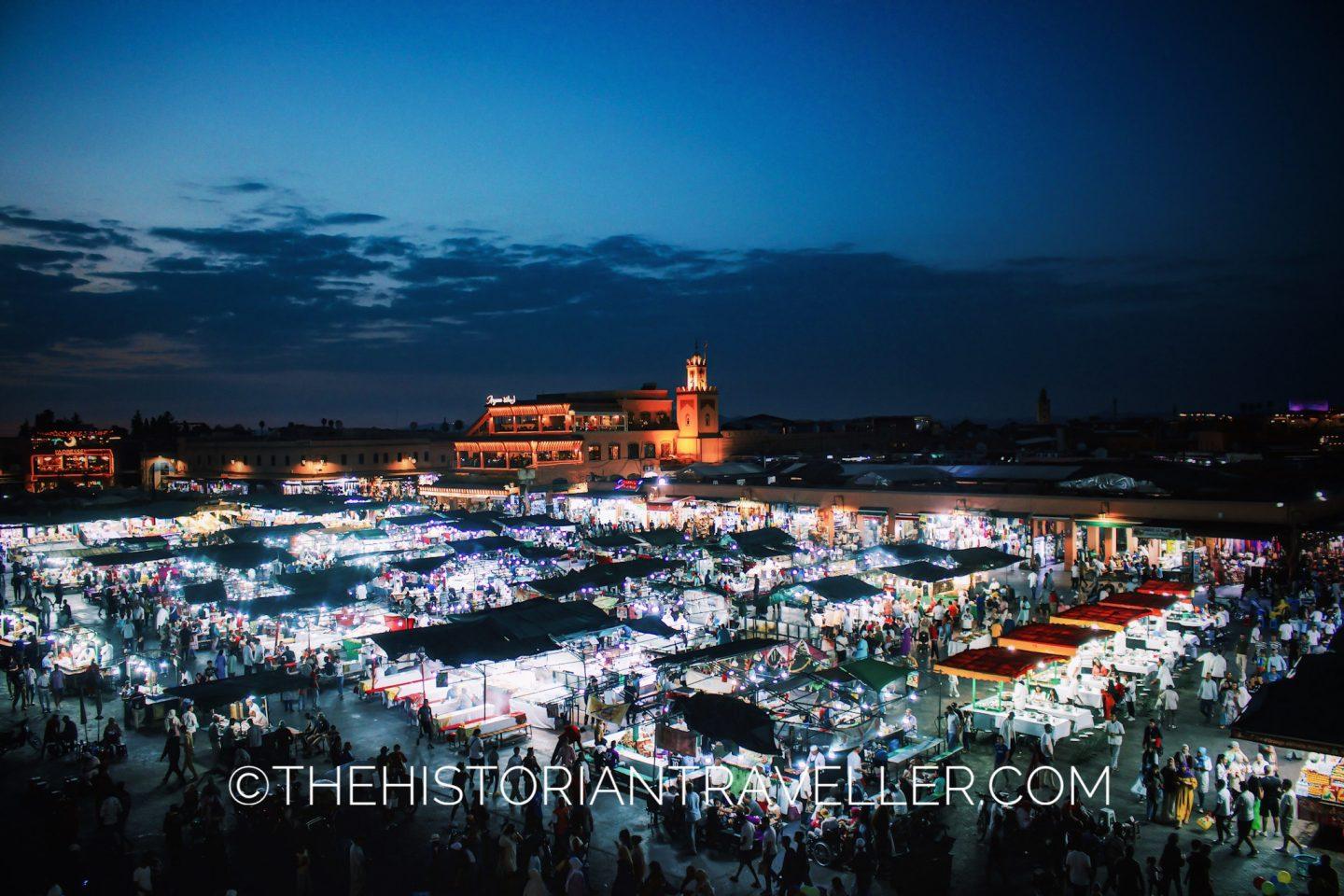
Whether you visit Jemaa el-Fnaa in the morning or at night, its charm will captivate you, making you feel as though you’ve entered another mystical, exotic dimension. Despite the less-than-ideal conditions for snakes, monkeys, and other animals that populate the square, as well as its persistent vendors, Jemaa el-Fnaa is one of the last remaining places in Marrakech where you can catch a glimpse of the past.
Indeed, the square has always been at the heart of Marrakech’s daily life, perhaps even since its foundation in the 11th century when it served as a site for public executions. Over the centuries, the square has played multiple roles, functioning as a marketplace, a location for a mosque, a gathering place, and a stage for fantastical performances, stories, and exhibitions. It has consistently been the epicenter of Marrakech’s cultural life. Therefore, it’s no surprise that as soon as you enter the medina, you’re often asked if you’d like to go to the square. After all, it’s where all the action happens.
The peculiarity of Jemaa el-Fnaa is its double face. Indeed, in the morning you can find vendors, snake charmers, the traditional orange juice stands and if, you are lucky, even a dentist. In the evening, the square changes completely face. It becomes a place of oral transmitted stories, enchantment and dances. It’s very loud and chaotic to overload your senses. Because of this peculiarity, the square is part of the special UNESCO project, Masterpiece of the Oral and Intangible Heritage of Humanity.
Tip for getting the best from Jemaa el-Fnaa
If you think that getting around the middle of the square is a bit too much for you, you can watch take some distance and watch the action from one of the balconies. One of the best views is that from Le Grand Balcon du Café Glacier. You have to pay 50 DH to access the terrace and they will bring you mint tea.
If you are brave enough and want to enjoy the best Moroccan food in one of the stalls, don’t sit just in random places but look at the numbers! The most renewed ones are Aicha, who runs stall n.1 (in the southwestern corner) best for kebabs and tagines. Mohammed El Krita who runs the fish stall n. 14 (best for fried calamari and and fresh fish coming from Essaouira). Lastly, to end up your dinner with a dessert, Chez Mohammed at stall n. 71 will provide you with the best tea or Morocco’s special coffee nous nous.
6. Get lost in the Medina
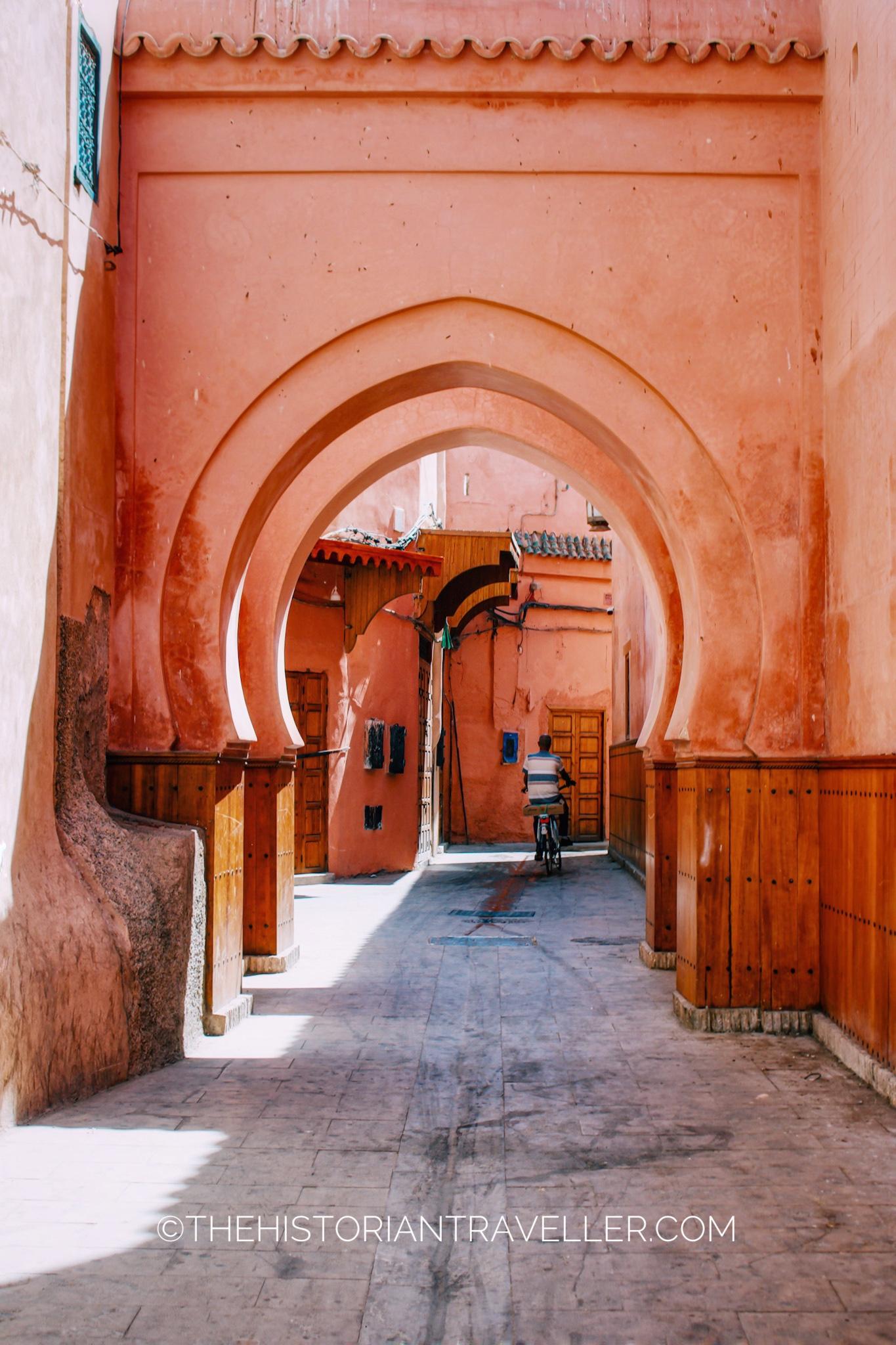
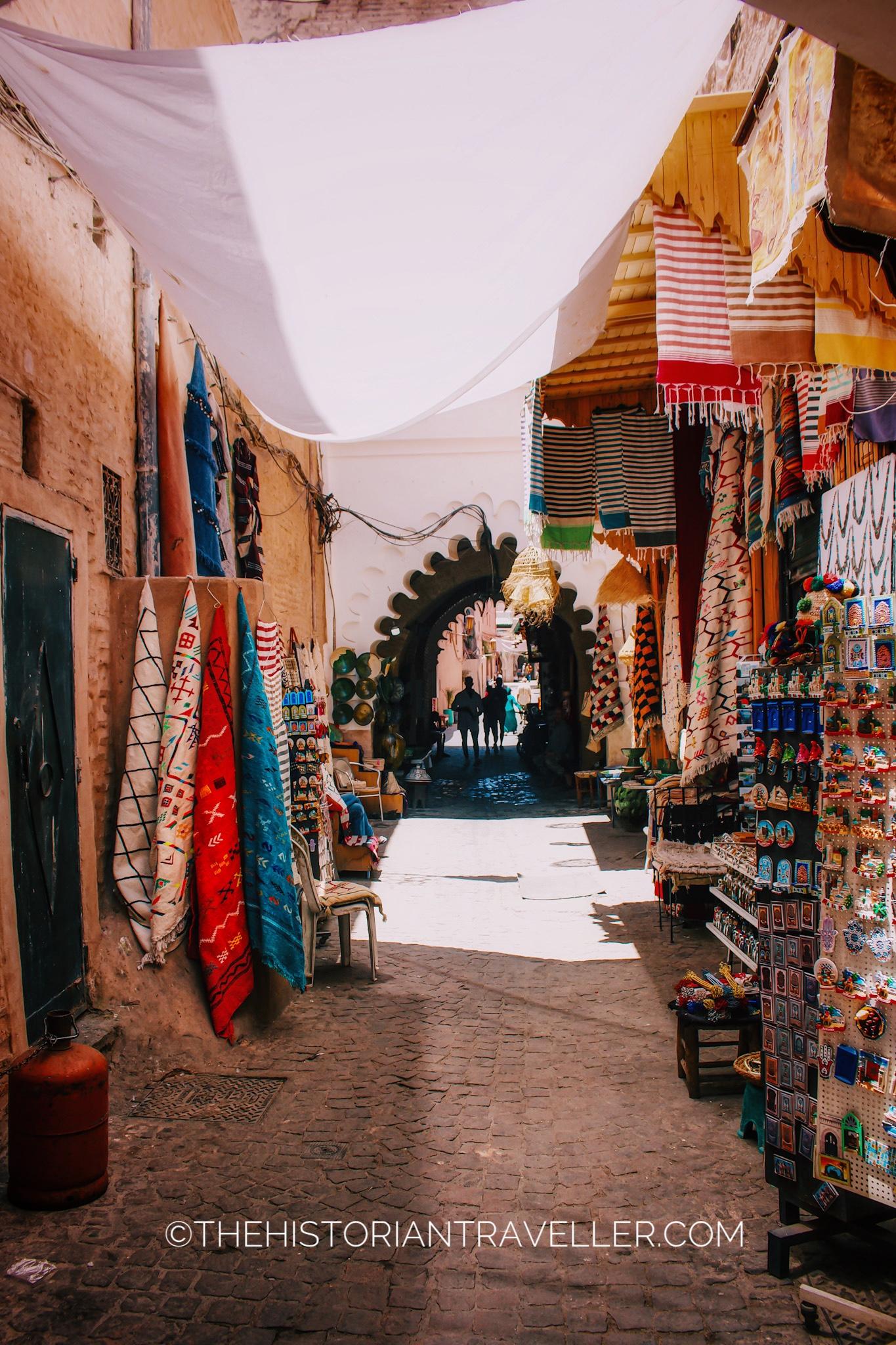
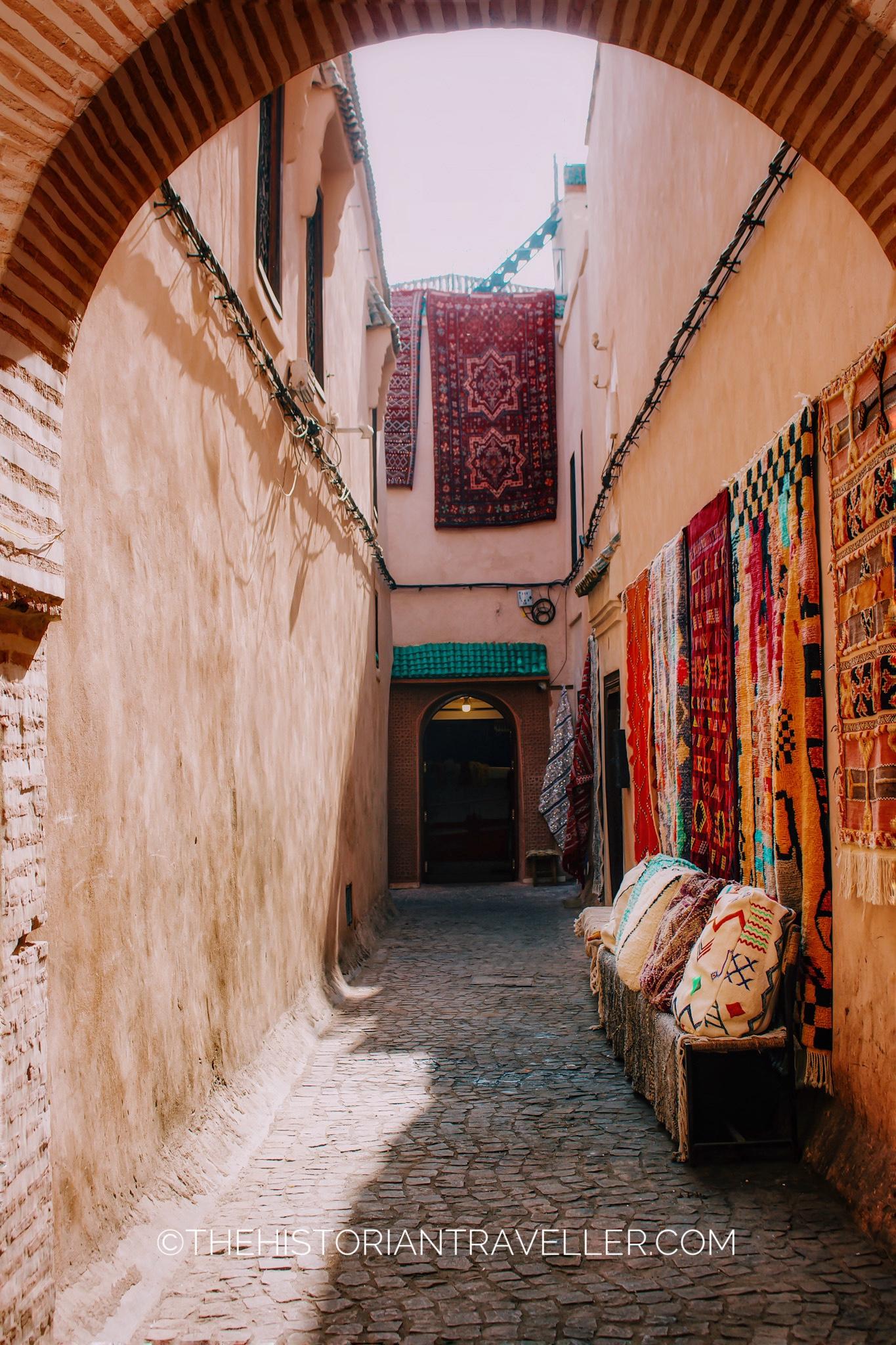
The medina of Marrakech is born contemporary to the city’s foundation in 1070–72 by the Amoravid dynasty. It is a protected UNESCO World Heritage Site and the oldest part of the city of Marrakech. If you ever desired to step back in time, walking the labyrinthine alleys of the Marrakech medina will give you this unique chance. Indeed, many of the souks still keep the magical charm they had at the time of their creation in the Middle Ages. Most of Marrakech’s historical sites and markets are enclosed within the walls of the Medina. Moreover, the Medina is a car-free zone. This means you can entirely walk it on foot.
Does Google maps work in Marrakech medina?
I would say that in the Marrakech Medina, Google Maps works better than in Fes. However, there is always a difference of a couple of meters when searching for a landmark. The good news is that we never got lost and always reached the right place. Marrakech is really easygoing. Google Maps can take you almost everywhere without any problems. For a smoother experience, use Google My Maps to save all the attractions, landmarks, and restaurants you would like to visit and download it offline to your phone before your trip. This will save you a lot of time once there and will help you to not get (too) lost even when there is no signal.
Scams to avoid in the Medina
One of the popular scams you will likely face when in Marrakech, is the one I called “The square is this way”. Indeed, whether you are getting around Marrakech, Fes or Chefchaouen there will always be someone ready to tell you that you are going in the wrong direction (even if they clearly don’t know where you are going!). Indeed, someone will tell you “hey, you are on the wrong road, the square is this way” or “this street is closed and you can go this way”. This is probably one of the scams that happen the most. And tourists still fell for it.
In Marrakech, some people are particularly pushy in trying to accompany you to “the square”. Of course, it’s pretty clear these gentlemen won’t take you to the square. Indeed, they try to disorient tourists taking them to side roads of the medina and get them lost. When the tourist will realise the scam, it will be to late as the gentlemen will ask money to get him on the “right road”. We never fell for this trick but I know people who did.
Therefore, say no thank you!. Whether they want to bring you to the actual square or isolating you from the crowd, the result will be always the same. They want money from you. So, just to be safe. Don’t follow anyone, anywhere.
7. Challenge yourself with a cooking class
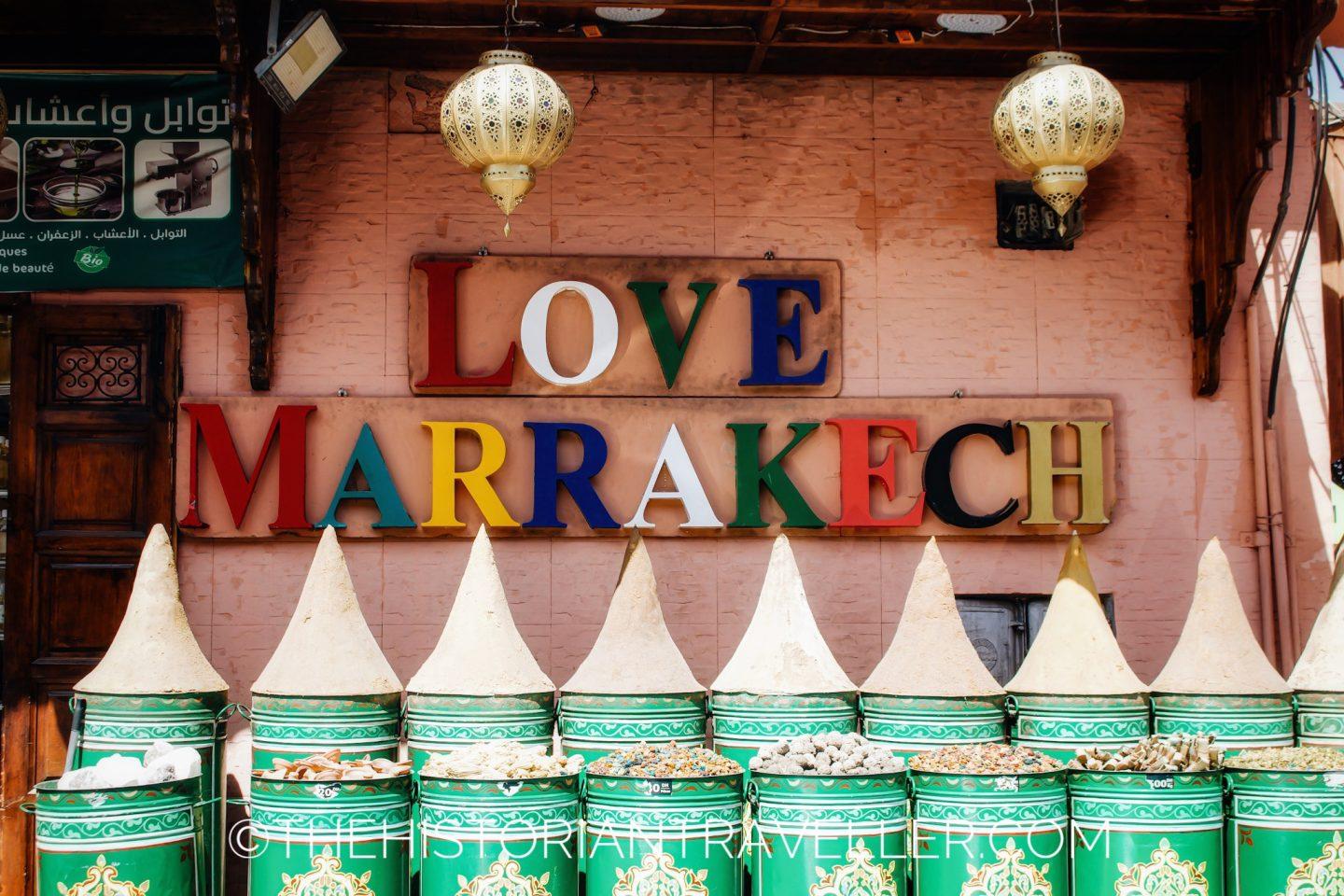
Taking a cooking class in Marrakech is a fantastic way to immerse yourself in Moroccan culture and learn how to prepare traditional dishes. These classes are often offered by local restaurants, riads, or culinary schools, and they typically provide a hands-on experience where you can learn to cook Moroccan specialties like tagines, couscous, and pastries. Some cooking classes also include a visit to a local market to shop for ingredients, adding an extra layer of authenticity to the experience. It’s a great way to bring a taste of Marrakech home with you, as you’ll learn the techniques and recipes to recreate Moroccan cuisine in your own kitchen.
What to consider when booking a cooking class in Marrakech
When choosing a cooking class in Marrakech, there are several important factors to consider to ensure you have a memorable and authentic experience. I divided them into primary and secondary factors.
Primary factors
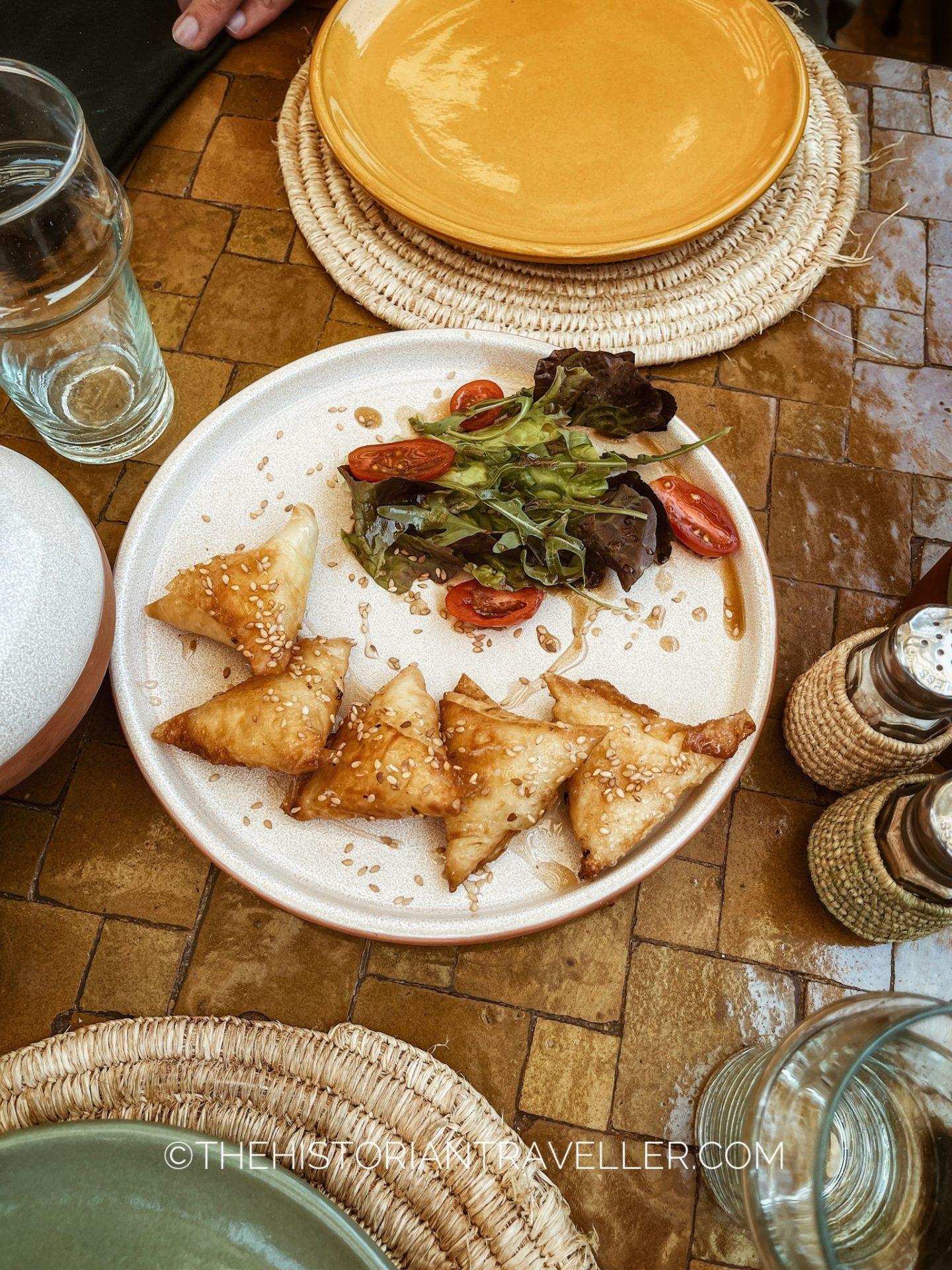
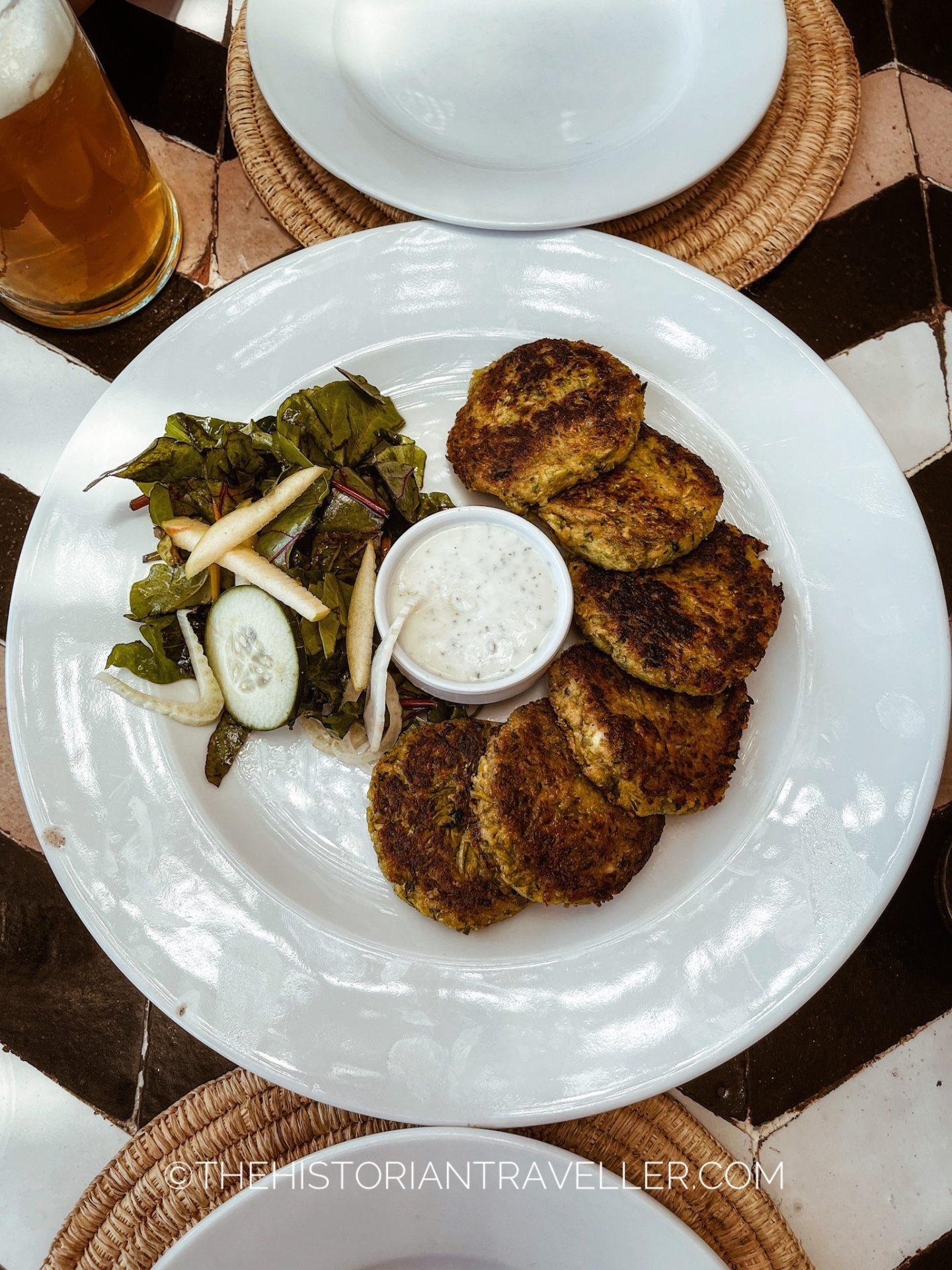
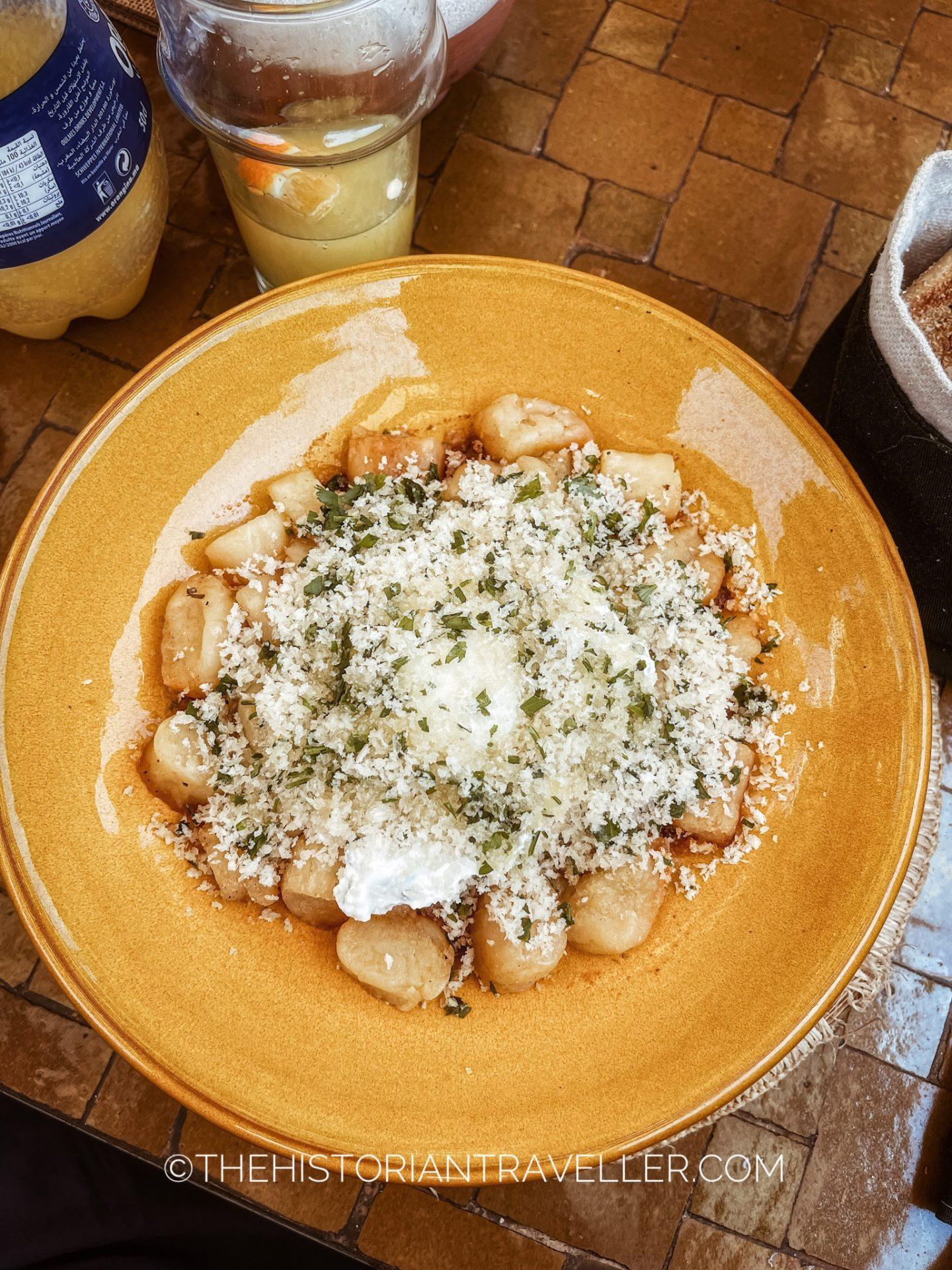
Type of Cuisine. Decide whether you want to learn traditional Moroccan cuisine or if you’re interested in a specific regional or international style of cooking. Marrakech offers a wide range of culinary options.
Location. Consider the location of the cooking class. Some are held in cooking schools, while others take place in riads (traditional Moroccan guesthouses) or restaurants. Choose a location that suits your preferences.
Instructor’s Credentials. Check the qualifications and experience of the instructor. They should have a deep knowledge of Moroccan cuisine and be skilled at teaching cooking techniques.
Menu Selection. Ask about the menu and dishes you’ll be preparing. Ensure it aligns with your culinary preferences and dietary restrictions.
Market Visit. If you’re interested in an authentic experience, consider classes that include a visit to a local market to purchase ingredients. This adds depth to your understanding of Moroccan cuisine.
Language. Confirm that the class is conducted in a language you understand, or if they offer translation services if needed.
Hands-On Experience. Determine the level of hands-on participation. Some classes are more demonstration-based, while others encourage active cooking and involvement.
Secondary factors
Class Size. Find out how many participants will be in the class. Smaller groups often allow for more personalised instruction and a hands-on experience.
Duration. Determine the length of the class. Cooking classes can vary from a few hours to a full day. Choose one that fits your schedule and interests.
Allergies and Dietary Restrictions. If you have food allergies or dietary restrictions, inform the cooking class organisers in advance to ensure they can accommodate your needs.
Reviews and Recommendations. Read reviews and seek recommendations from fellow travellers or online sources to gauge the reputation and quality of the cooking class.
Cost. Compare prices and what is included in the cost (ingredients, recipes, aprons, etc.) to ensure it fits your budget.
Availability. Check for class availability and book in advance, especially during peak tourist seasons, to secure your spot.
Cancellation Policy. Understand the cancellation policy in case you need to make changes to your reservation.
8. Explore Marrakech’s centuries-old gardens
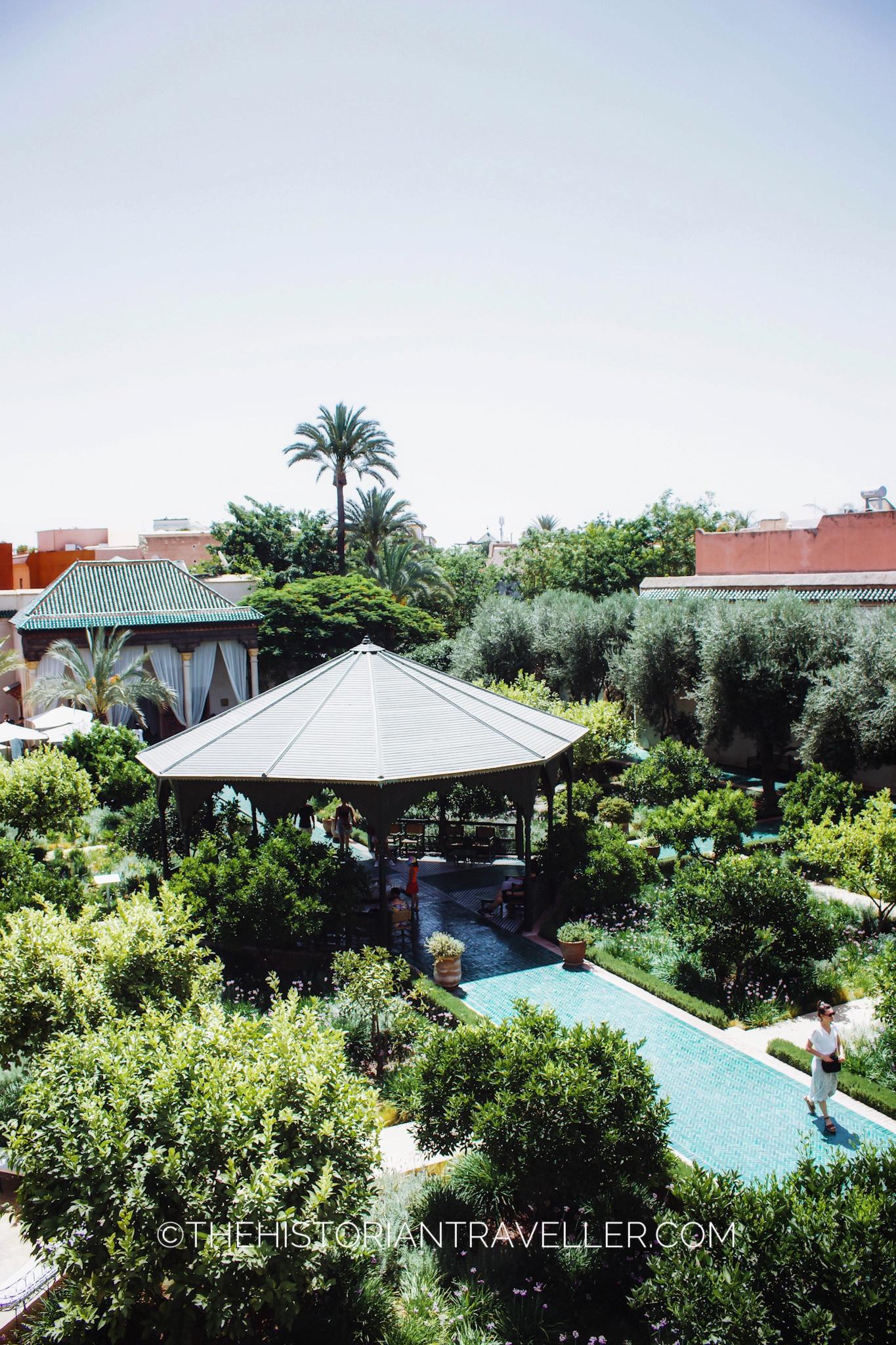
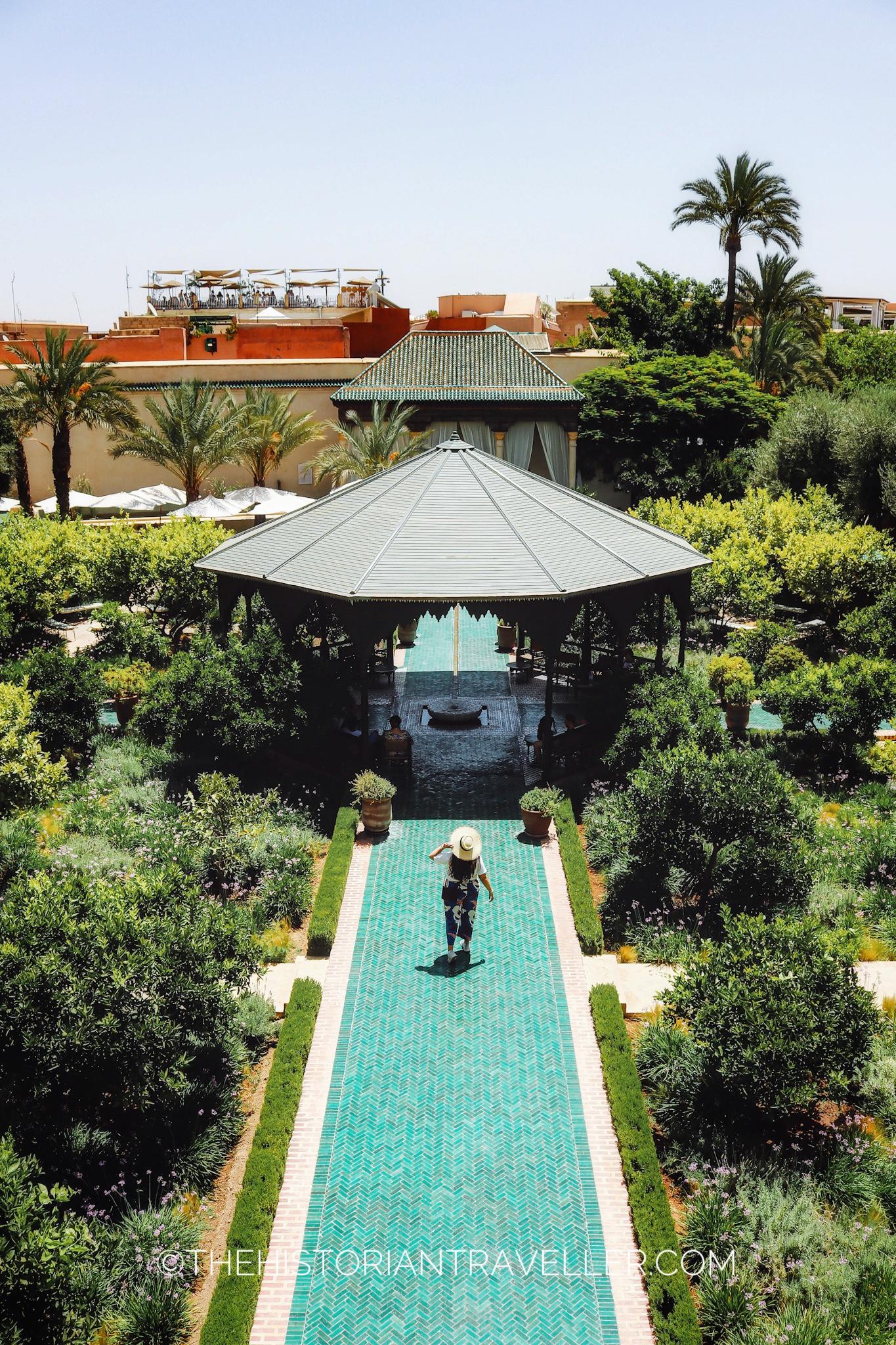
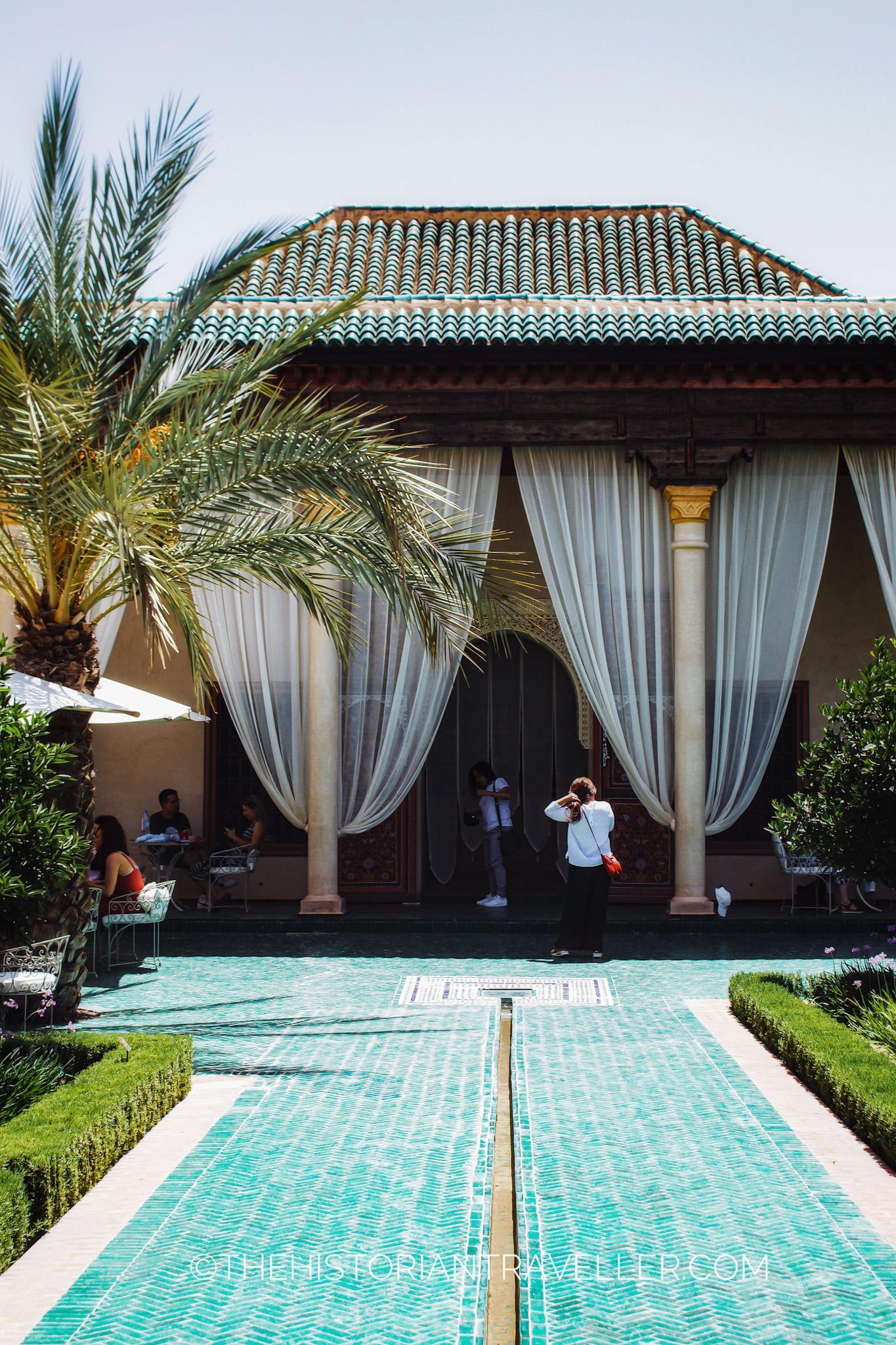
Enhance your stay in Marrakech exploring its outer gardens. Indeed, the city is renowned for its lush and enchanting green spaces providing a peaceful escape from the bustling streets of the medina. Many gardens in Marrakech are UNESCO World Heritage Sites. Indeed, gems like the Menara Gardens or Agdal Gardens date back to the 12th century and still survive in contemporary society. Most of the city’s gardens are out of the medina walls. Therefore, you’ll need a car to explore them.
One of the few gardens you can visit inside the medina is Le Jardin Secret. This is a hidden oasis dating back to ack to the second half of the sixteenth century. Is one of the few gardens in the city that still keeps alive the khettara irrigation system used during the Almoravid period.
Tip: when visiting the garden don’t skip the tower! It is one of the highest view points in Marrakech.
9. Treat yourself with a luxury hammam
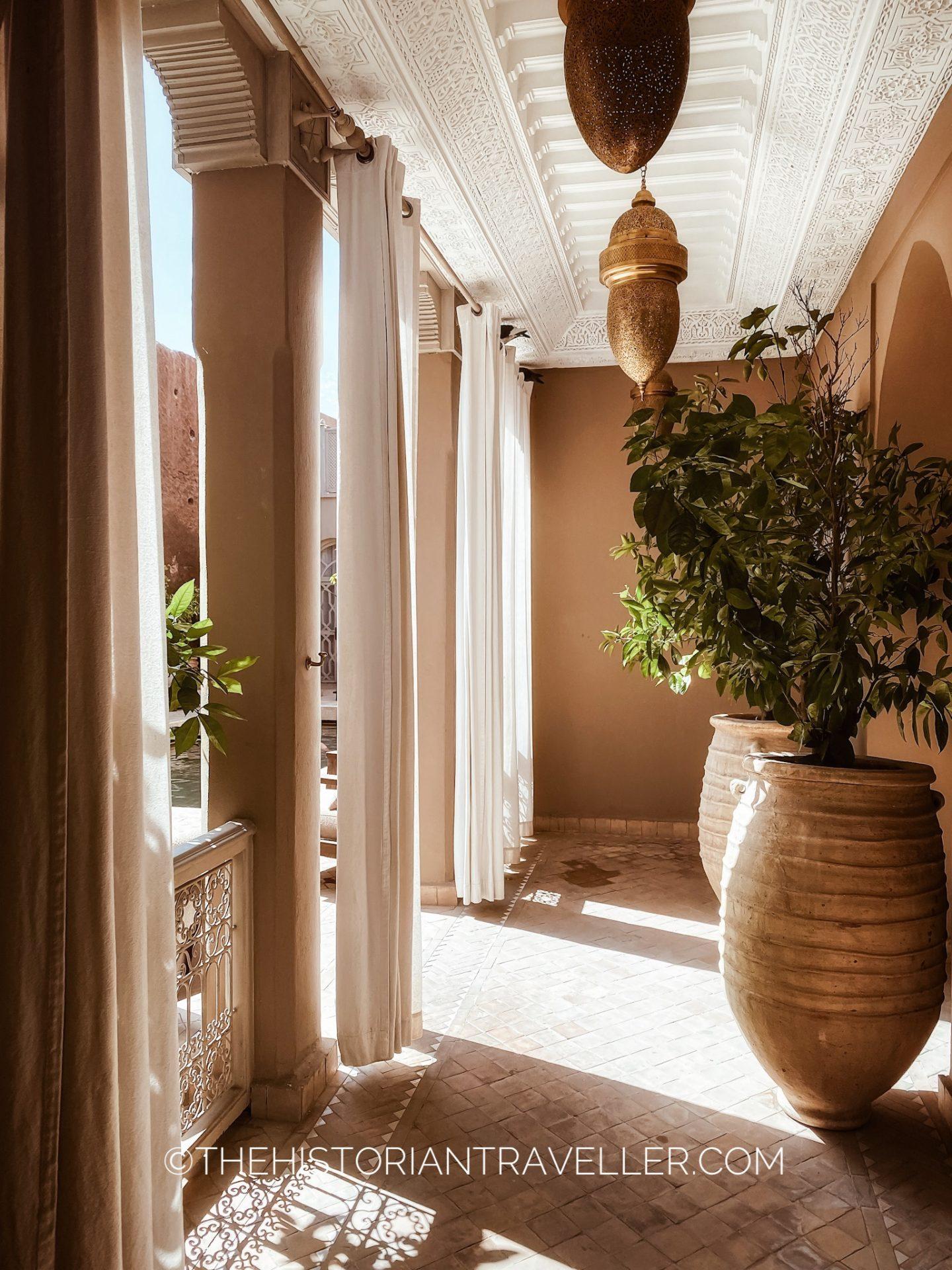
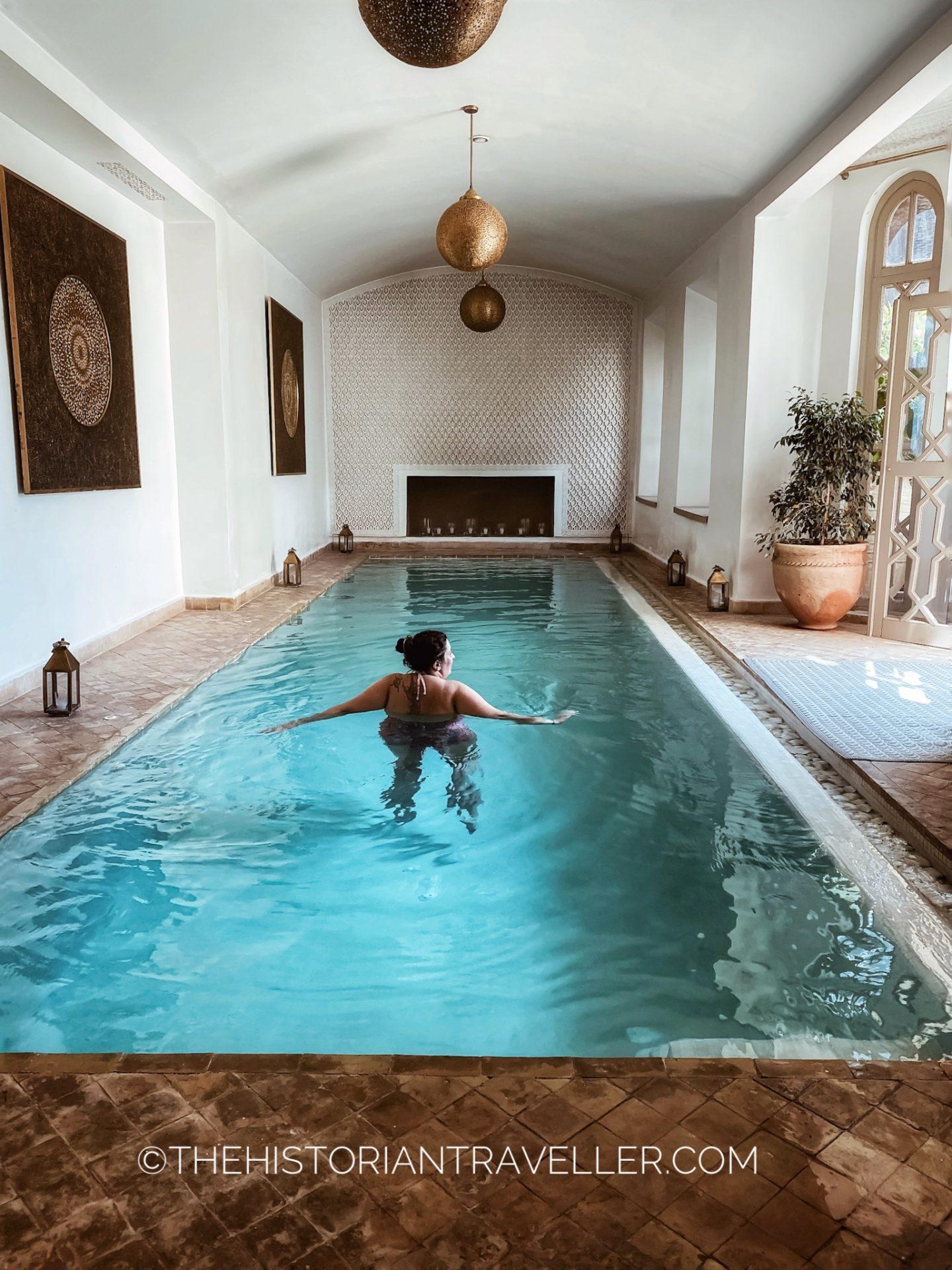
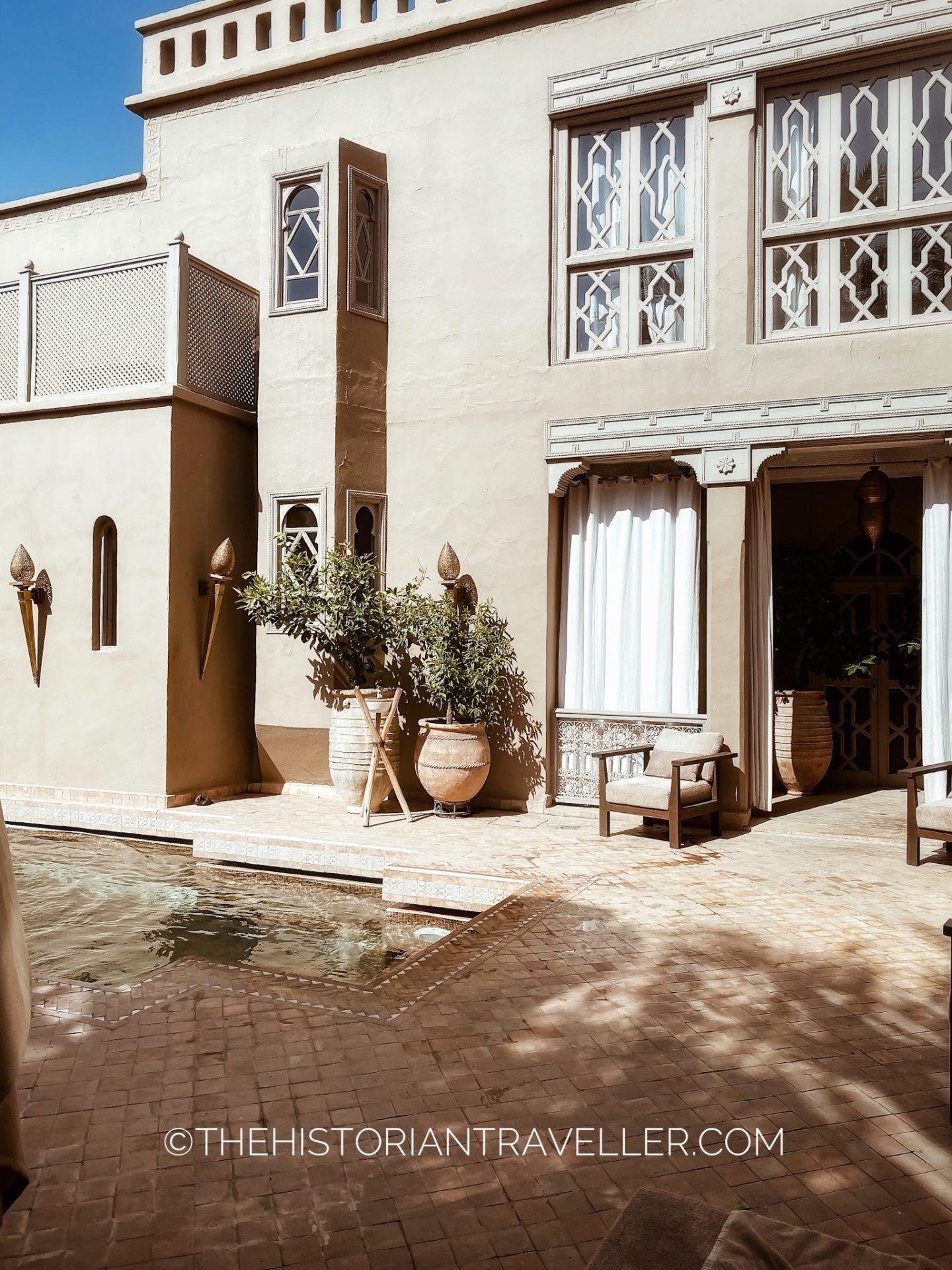
Exploring Marrakech is not just discovering amazing historical locations, but includes also immerse yourself into Moroccan culture and traditions. In this regard, an essential part of the Moroccan daily life is the hammam ritual.
What is a hammam?
If you never heard of the hammam before, you’ll discover very soon this is one of the most popular leisurely activities to do in Morocco. Generally, the hammam indicates two different things. The first, actually refers to the physical location called “hammam” this can be generally translated as “steam bath” or “public bath”. The second refers to the ritual of the hammam, which consist of a relaxing steam bath, a vigorous skin scrub and wash. Both location and ritual come from a centuries-old tradition. Historians thinks they were diffused in North Africa and Middle East by the Romans (who were quite famous for their public baths!).
Having a hammam is still an important social activity in many North-African and Middle Eastern countries. You’ll find out that hammams are divided by genre or operate on alternate hours for different genres.
Ah, and if I haven’t said before, it is expected to be naked for the whole experience. So, if you have issues in being fully naked in front of other people (which is legitimate), this might not be the experience for you.
Where I can do a hammam in Marrakech?
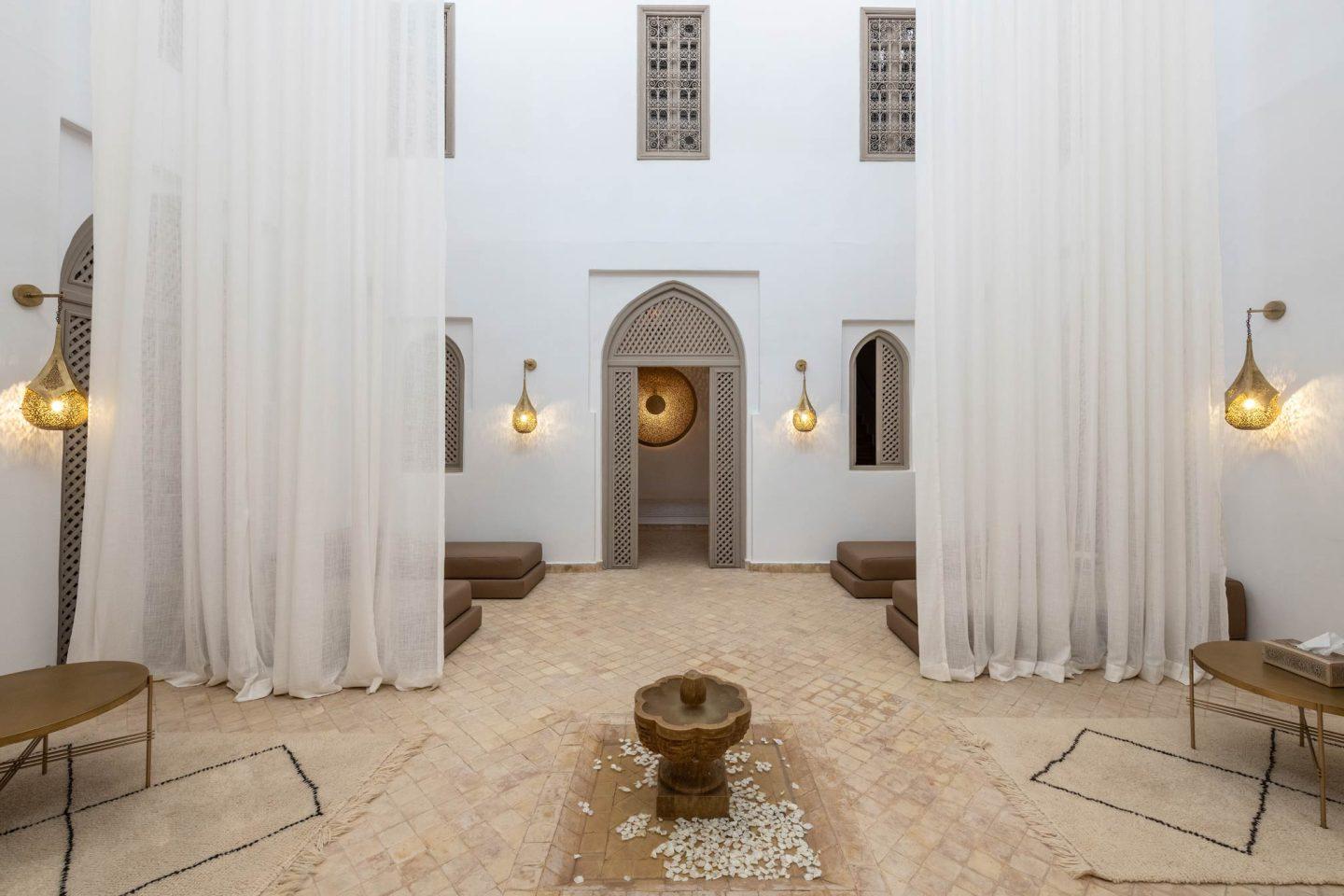
There are essentially two ways of having a hammam in Marrakech (and Morocco). The first is going to a public bath. The second is find a private hammam or spa (with hammam).
If you go for the brave way, and opt for the public bath, do a good research. Each neighbourhood of the medina should have its own “public bath” in the area. Ask if there are separate hammams for men and women or there is just one operating at alternate times. Ask what you need to bring with you. If you are still unsure, ask some female staff at your accommodation for suggestions. Who never knows, they might even come with you.
Private hammams are usually a much easier choice for tourists. In fact, almost every upscale hotel in Morocco has a spa with its own hammam. Moreover, riads usually have partnerships with private hammams. These grant flexibility, more privacy and a more luxurious experience. On the other side, while public hammams usually cost a few dirhams, private ones are much more expensive. Indeed, price ranges from 50 euros to 1000 euros depending on the place (and treatment). Most places provide a combined hammam+ massage and this is what we went for too.
How to have a couple hammam in Marrakech
As I said before, hammams are usually separated by genres. Therefore, in most of them (even private ones) couples are not admitted (unless accepting to receive the treatment separately). If you want a romantic experience with your partner, unfortunately, there isn’t much choice in Marrakech. However, after a thoroughly research, I found out that Les Bains des Marrakech is one of the few places in the city providing couple and groups experiences. So I booked it!
For both me and my husband I booked the “Signature n. 2 – The Legacy” which included a 2 hours experience with two treatments at our choice. We personally opted for 1h hammam + 1h massage, but there was also the option for mud treatments and facial care. All at the very convenient price of 799 DH. What a steal!
The experience was quite good in general. Unfortunately, I don’t have any terms of comparison for the hammam experience itself, which I realised is not really my thing, despite the very silky skin result. The massage was very good. We spent the whole afternoon at the hammam site as there are also various relaxation areas where you can bath and have a mint tea. Overall I think the price was appropriate to what we got. Despite I didn’t fully enjoy the hammam ritual itself.
10. Discover the magic of Marrakech souks
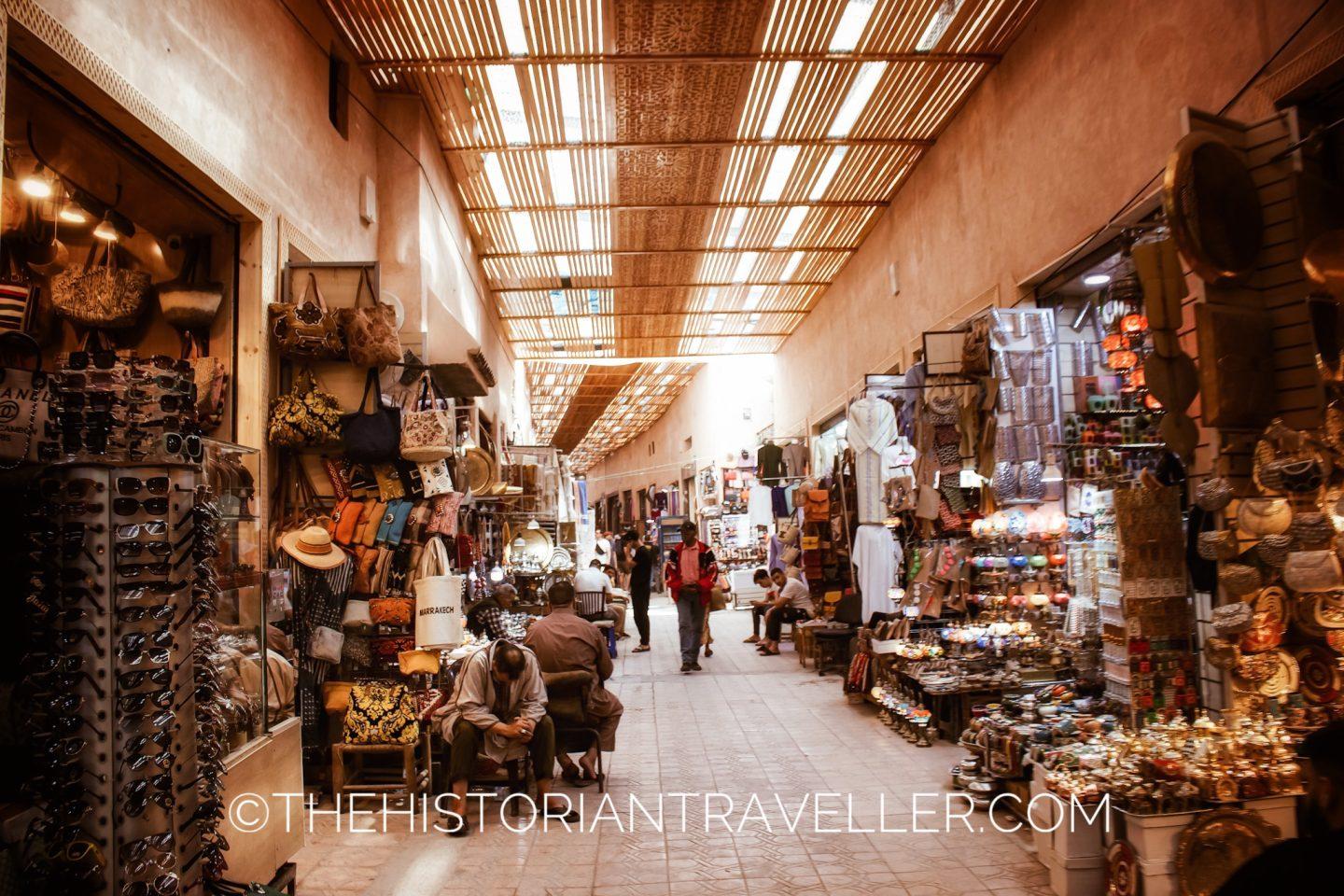
If I think about travel shopping, there is no better place for getting every thing one can imagine than Marrakech. From the most Moroccan touristy things like carpets, Argan oil or babouches to researched iconic pieces of art, manuscripts and even carved doors. The places where you can find all of these treasures are the souks.
Souks are the lifeblood of Marrakech. They are vibrant, bustling and a compulsory stop for any traveller in Morocco. You’ll pass them through while visiting historical attractions or searching for a restaurant. However, if you don’t have a map it’s unlikely you can distinguish one from the other.
What souks to visit in Marrakech largely depends on what you would like to buy. Most souks have a mix of items and souvenirs, while some others are more specific and focus exclusively on lamps or carpets etc. Here below you’ll find a small list of souks you can add to your list of places to visit in Marrakech. Nevertheless, I warmly suggest to look at the map above for a broader view of where most souks are located.
What souks to visit in Marrakech?
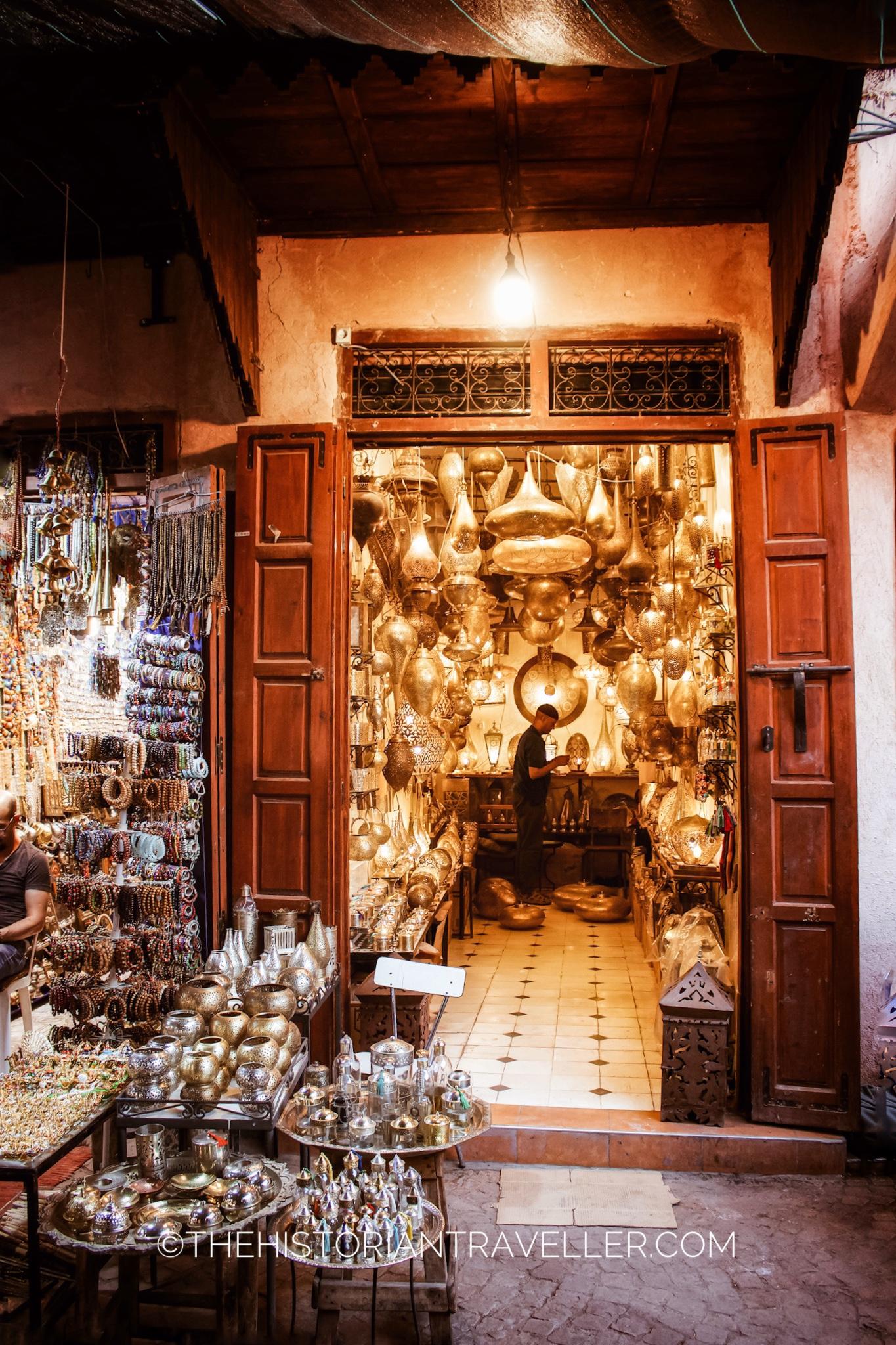
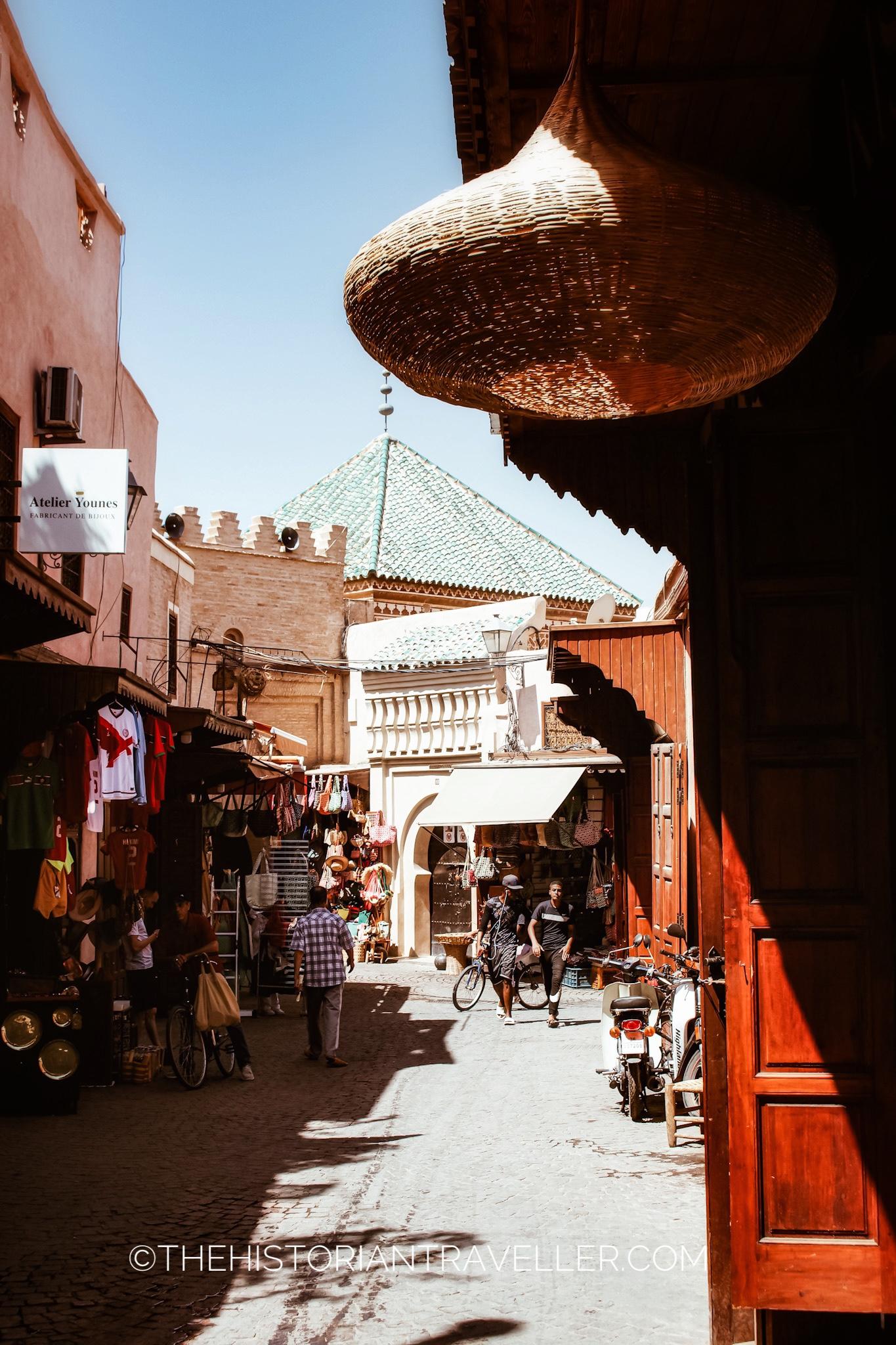
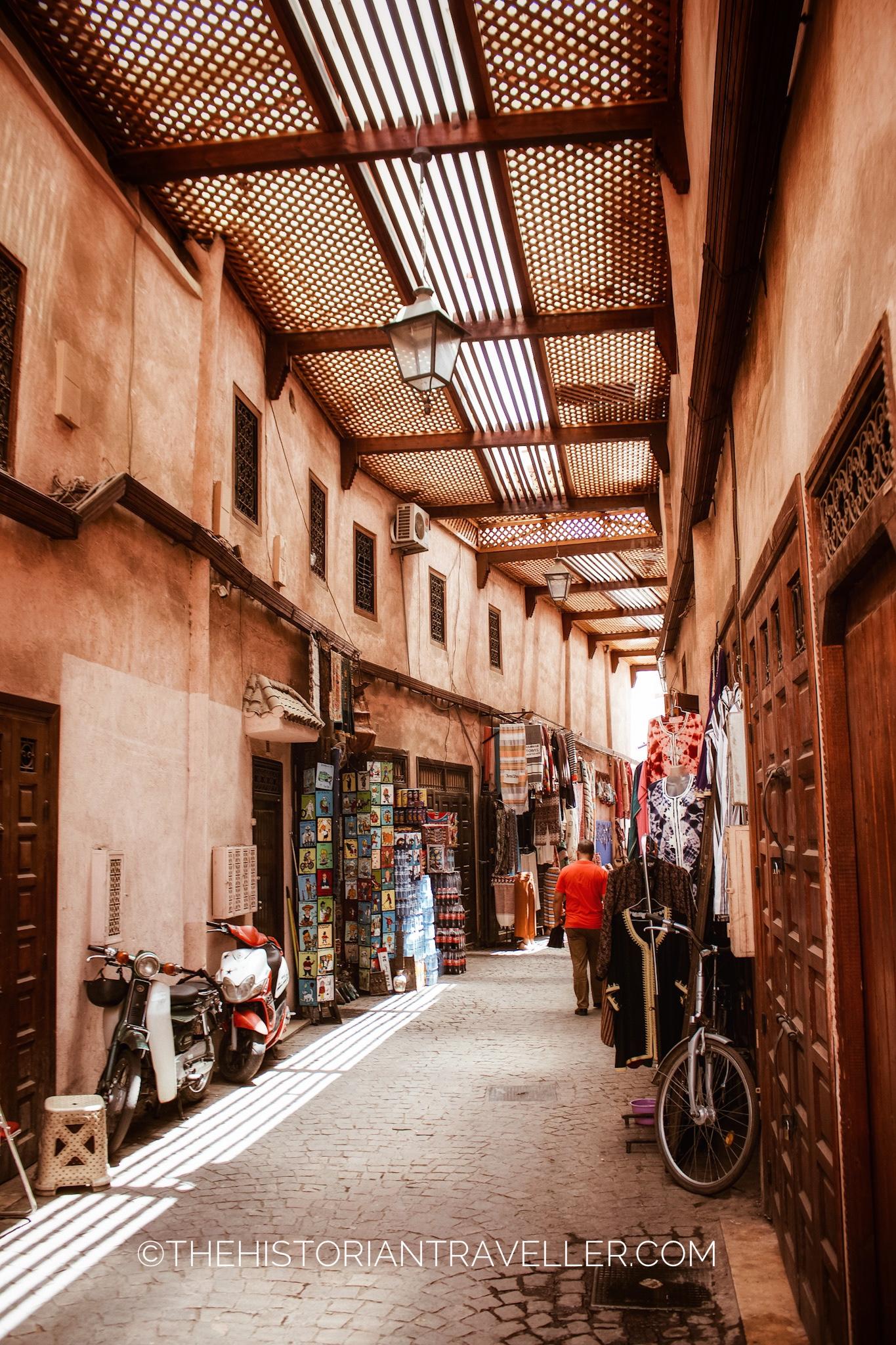
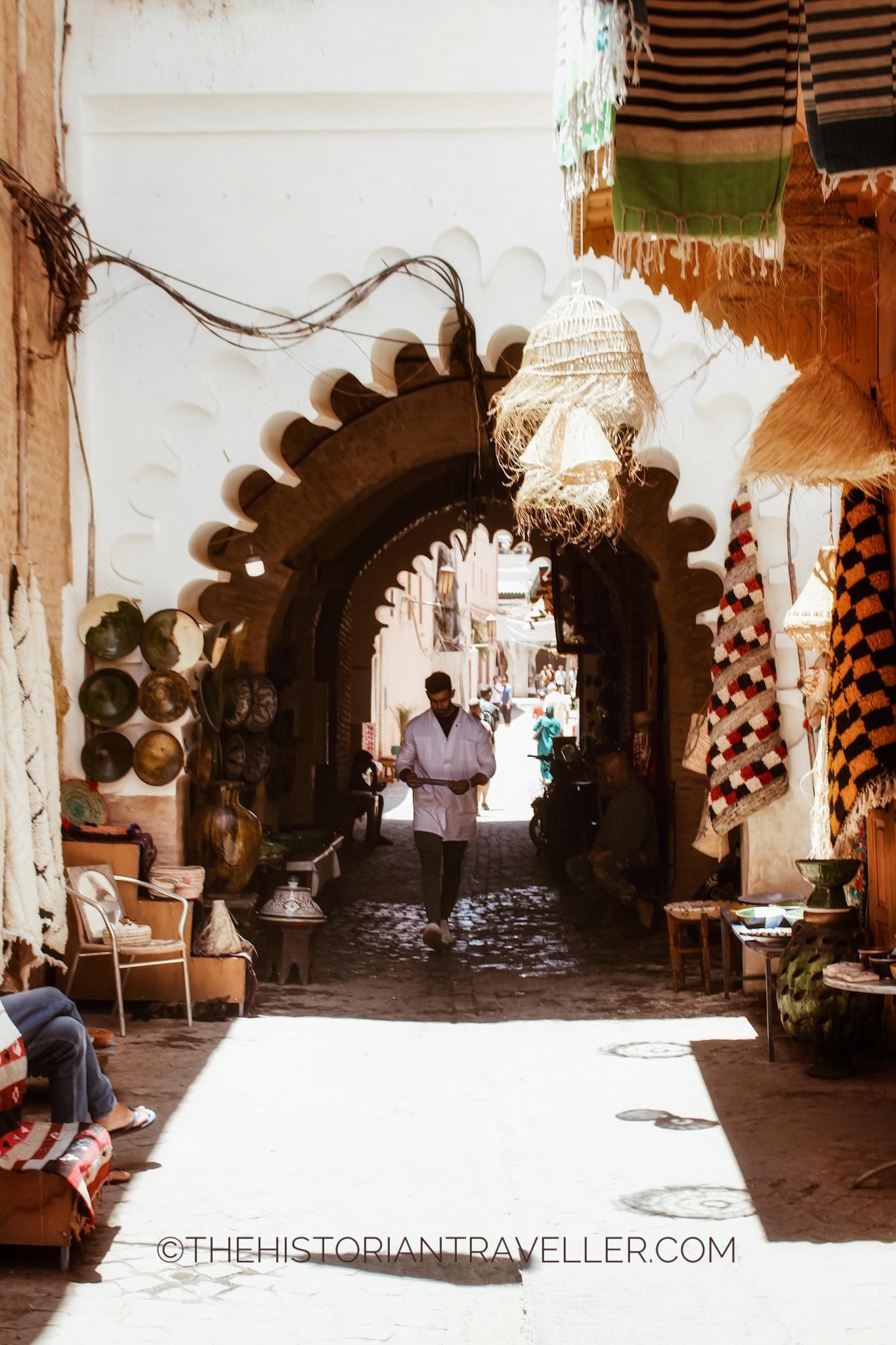
Souk Semmarine, close to the Jemaa el-Fnaa, is probably the most famous souk in Marrakech. Moreover, it’s also the first market that most travellers discover in the city on arrival. Souk Semmarine is the largest souk district in Marrakech and here you can find almost everything. From pottery, to spices to straw bags and colourful babouches. There is something for everyone and this is the best place to find souvenirs for your trip. Souk Semmarine is characterised by beautiful covered alleys and if you look closely some of the stalls, you can see also some impressive carved portals.
If you want to find some high-quality leather products, Souk Cherratine (not too far from the Almoravid Koubba) is the best place. Here you can find leather bags, babouches and belts. Similar but smaller leather souks are also Souk Smata and Souk Sbtana. Another famous souk famous as the “Blacksmith souk” of which name is Souk Haddadine. Here you can find not only bulgy furniture items made of various metals but also lamps and lampshades. If you go at dusk, most lamp shops will be illuminated creating a magical atmosphere. Souk Krabi, next to Place des Epices is the best place to go for finding handmade carpets. However, if you want some photogenic souks to photograph, Souk Sabbaghine is very picturesque. Indeed, here you will see multicoloured hanks of wool and cotton fabrics hanging up to dry all over the place and this creates a very colourful effect.
Souks haggling etiquette
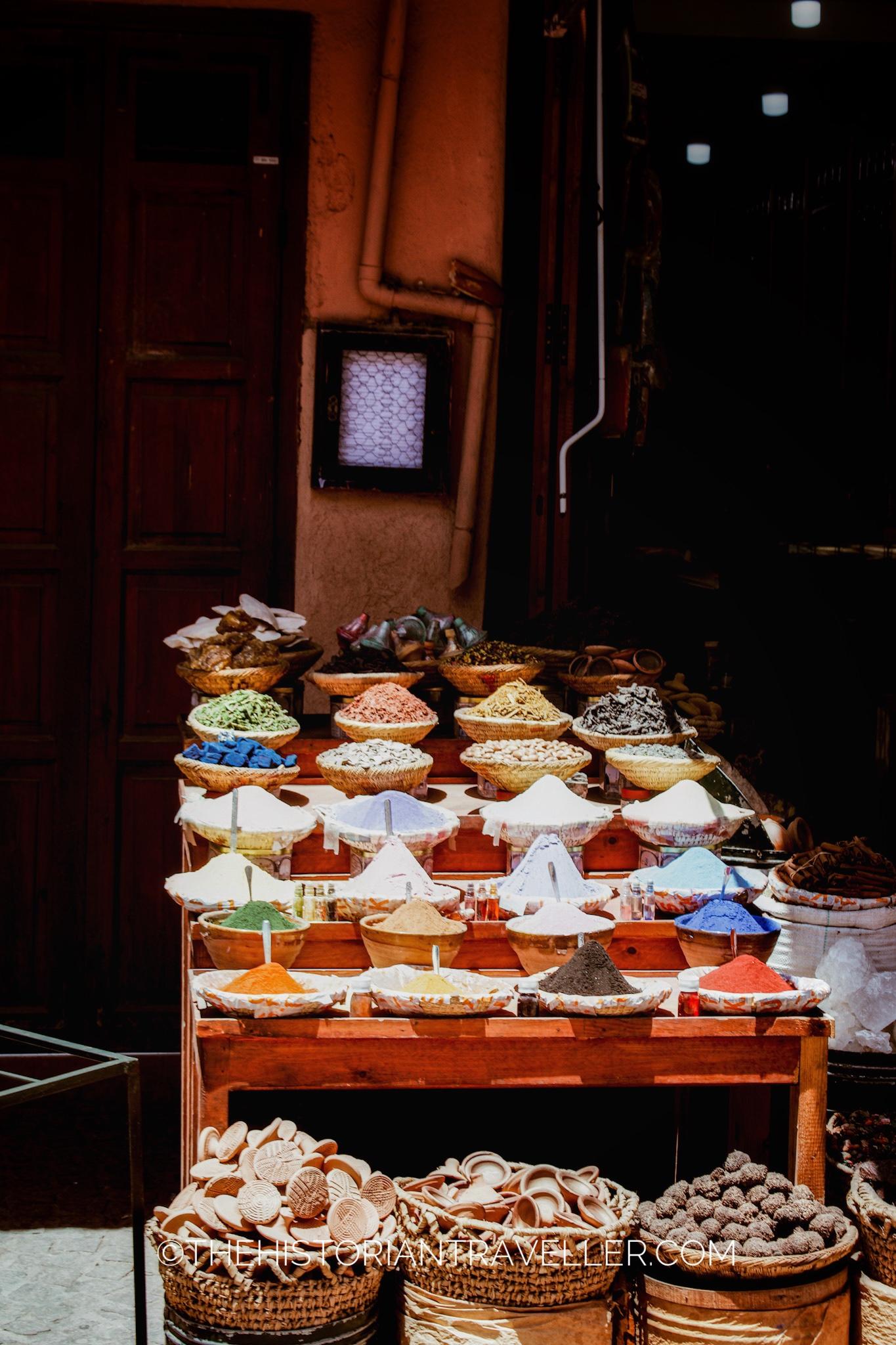
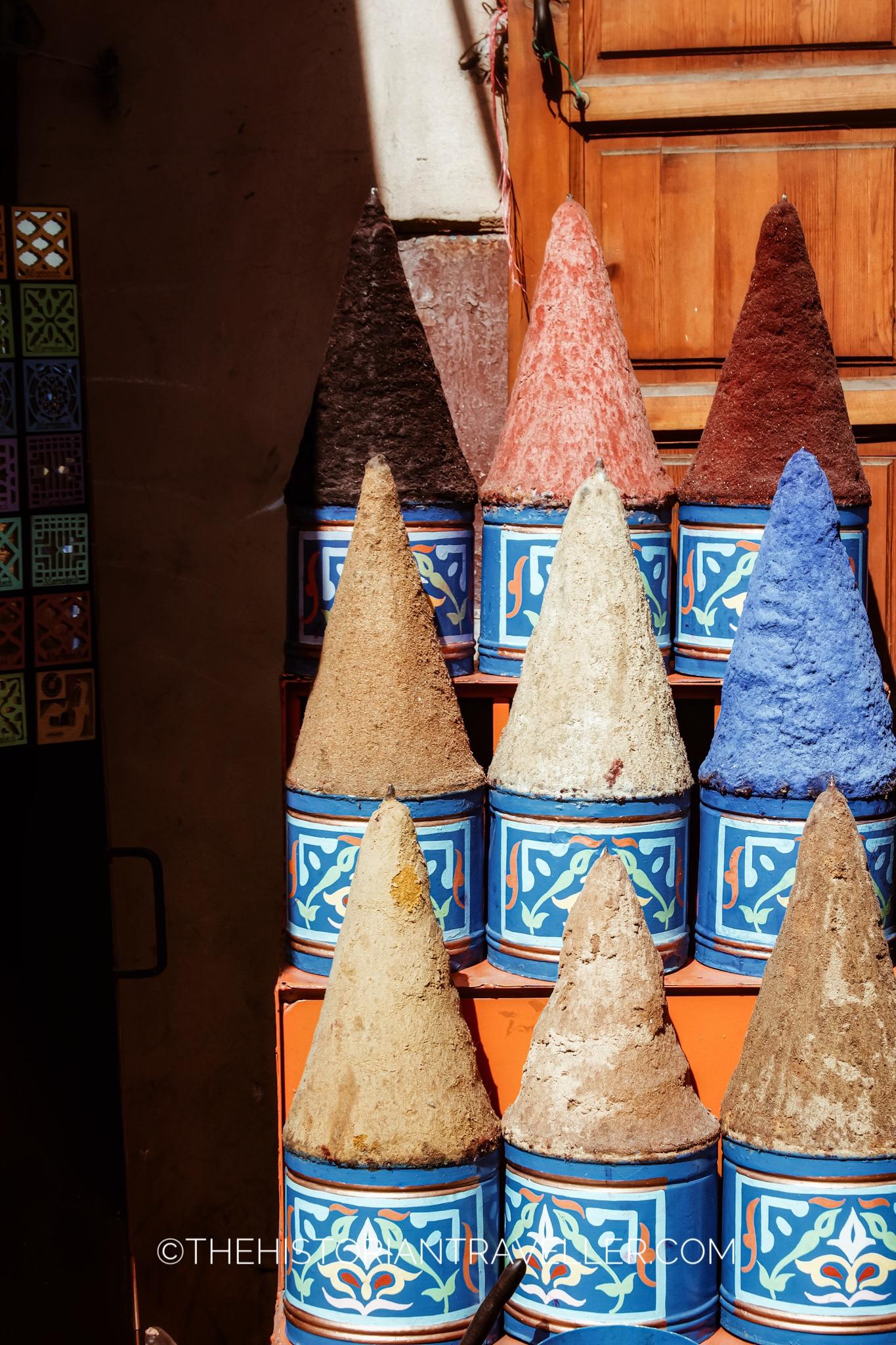
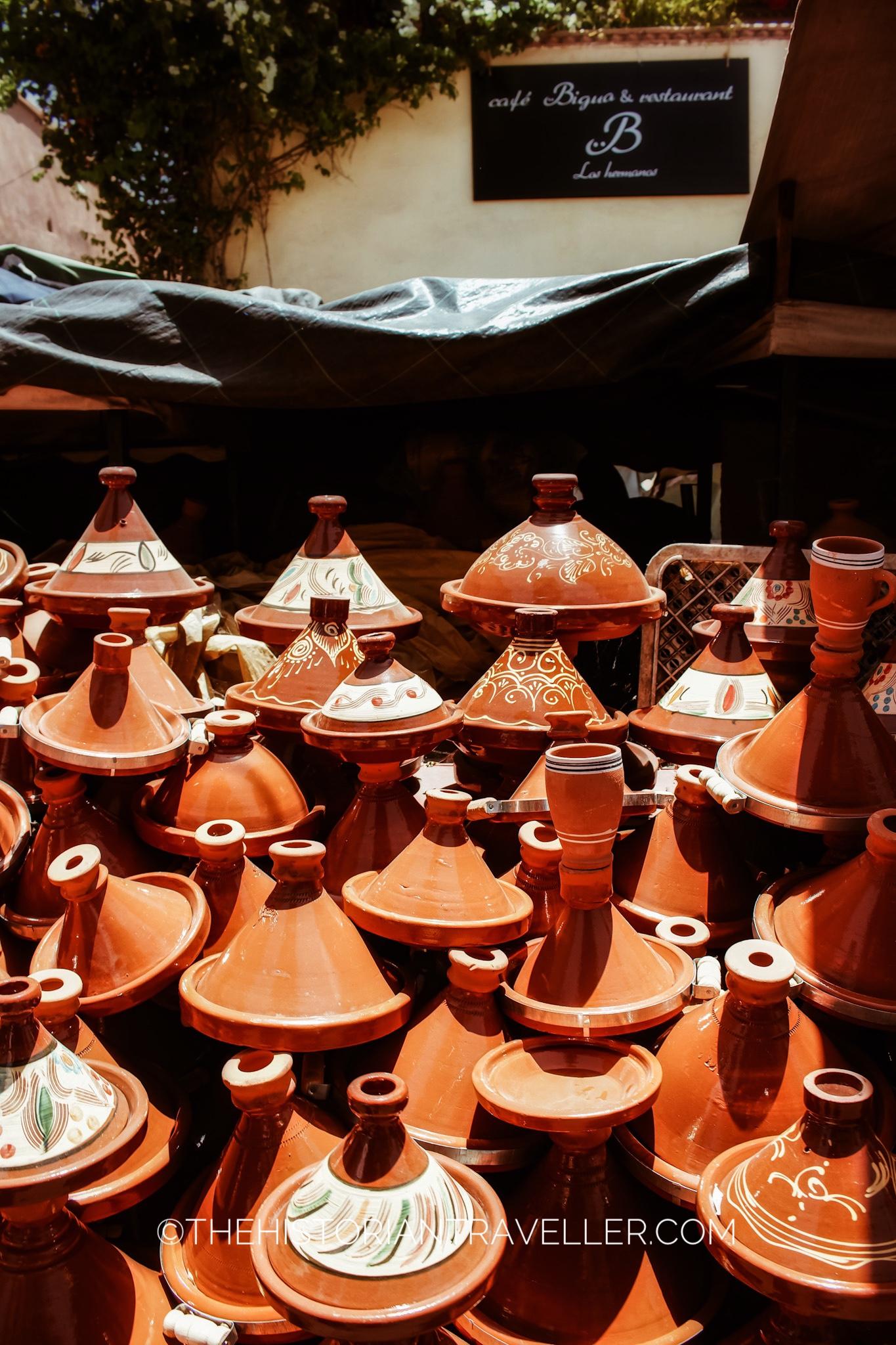
Haggling is at the base of cultural exchange in Morocco when it comes to shopping. You should never be afraid of saying a that an item “cost too much” if the vendor propose you an unfair price. Despite there are no fixed rules when it comes to haggling, it is good practice to play a “certain price cut game” with your vendor. This includes never ask for an item price first, never accept the price your vendor proposes at the first stage of your bargaining and never play your shot with a price that is too low (this is considered offensive towards the vendor).
It is generally considered polite to start your bargaining with 1/3rd of the asked price for an item and then build up around this. Most deals are usually concluded at 50% of the price initially stated. If you fail to agree a price because of a particularly stubborn vendor, it’s OK to go away. Just do this politely.
My Marrakech E-book is now live!
Want to discover absolutely everything about Marrakech to plan your next holiday? My Marrakech e-book is now live! This includes all the best tips, restaurants, places to stay and trip planners useful to organise your holiday! Planners are sold also separately. Check- it out here!
Catania Tourist Map
Do you to plan your trip to Catania and a map giving you the exact location of every single thing you need? I got you covered. This Catania Tourist Map include the exact location of over 150 places in between…
Marrakech Trip Planners
Want to plan your trip to Marrakech and need some planners to organise it? I got you covered. This Marrakech Trip Planners Pack include everything you need to plan your trip to Marrakech. A 32-pages planner that will help you…
The Historian Traveller’s guide to Marrakech
Marrakech Travel Guide Planning to visit Marrakech? This is the guide you need! From the top locations to explore, to the best restaurants and places to stay in the Red City of Morocco. Discover the most comprehensive guide on Marrakech…
Planning a trip to Morocco? Read these guides below
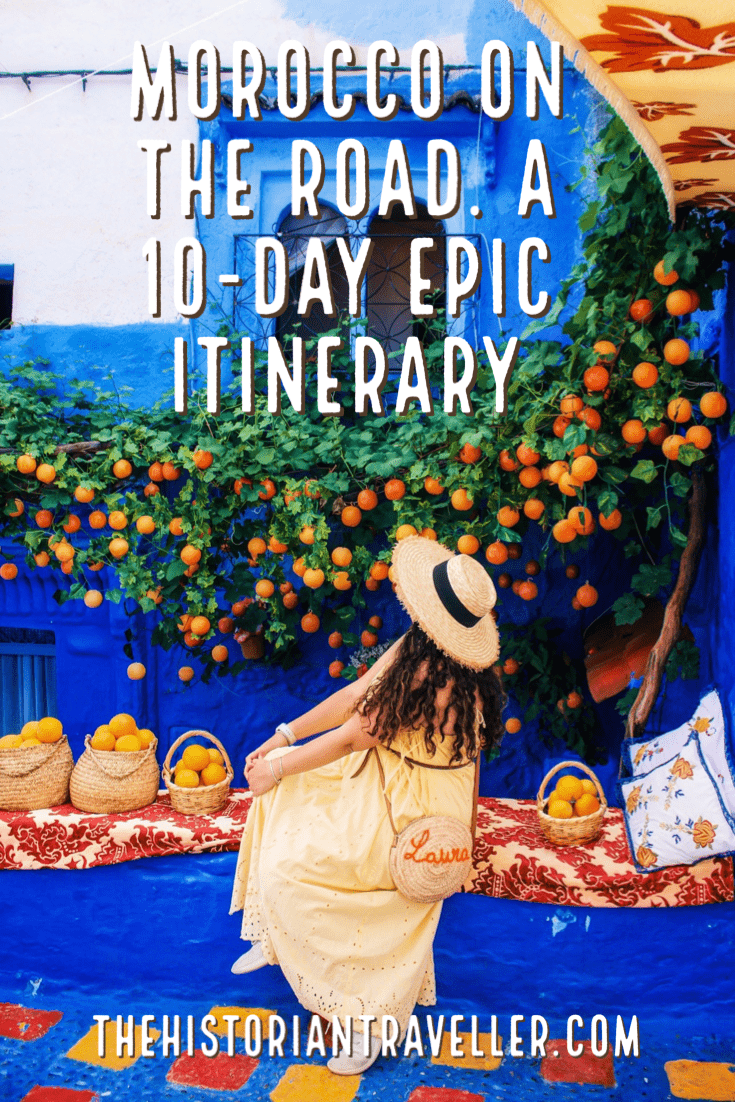
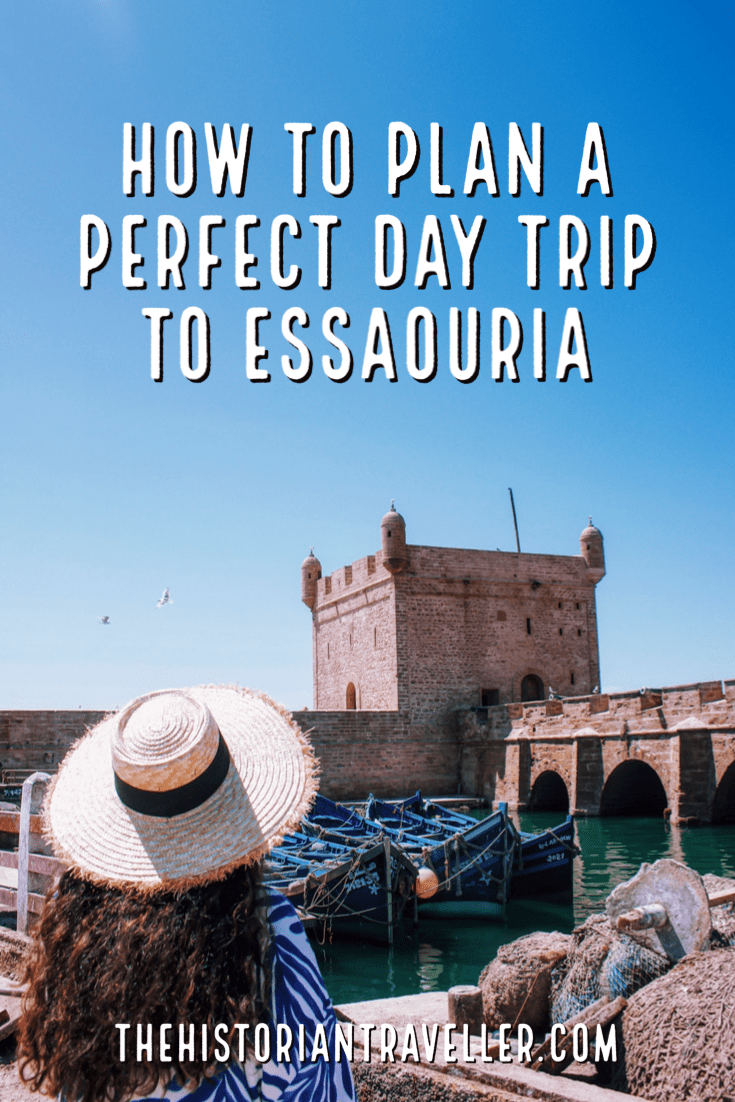
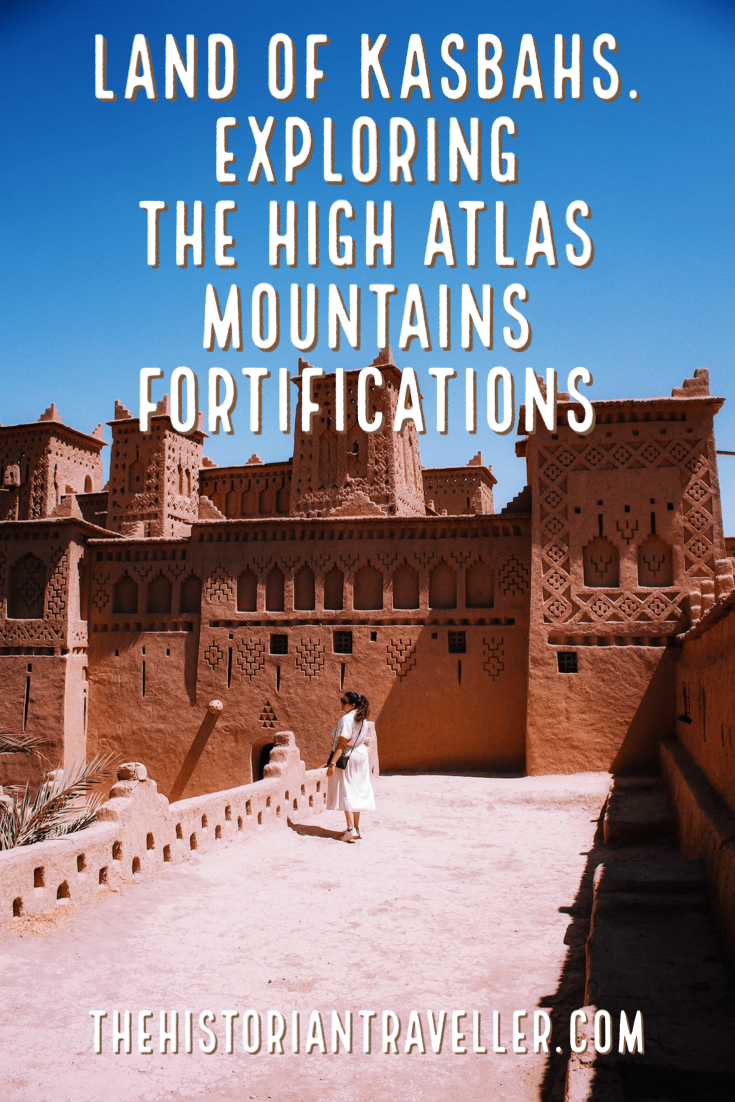
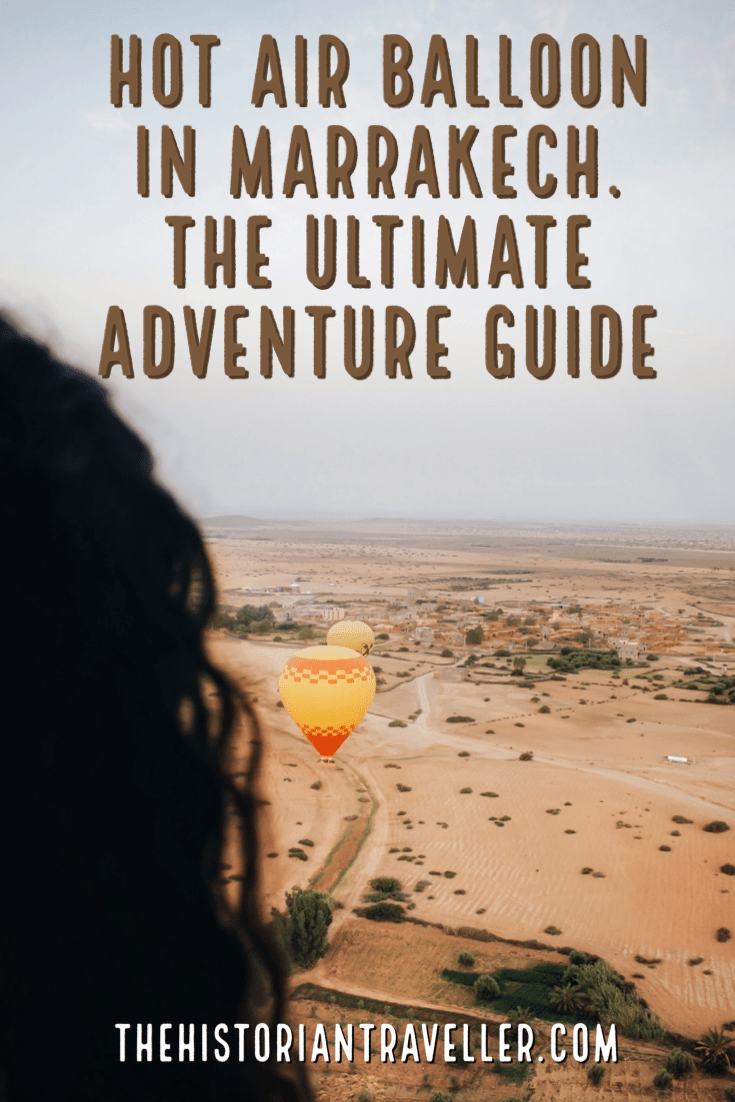
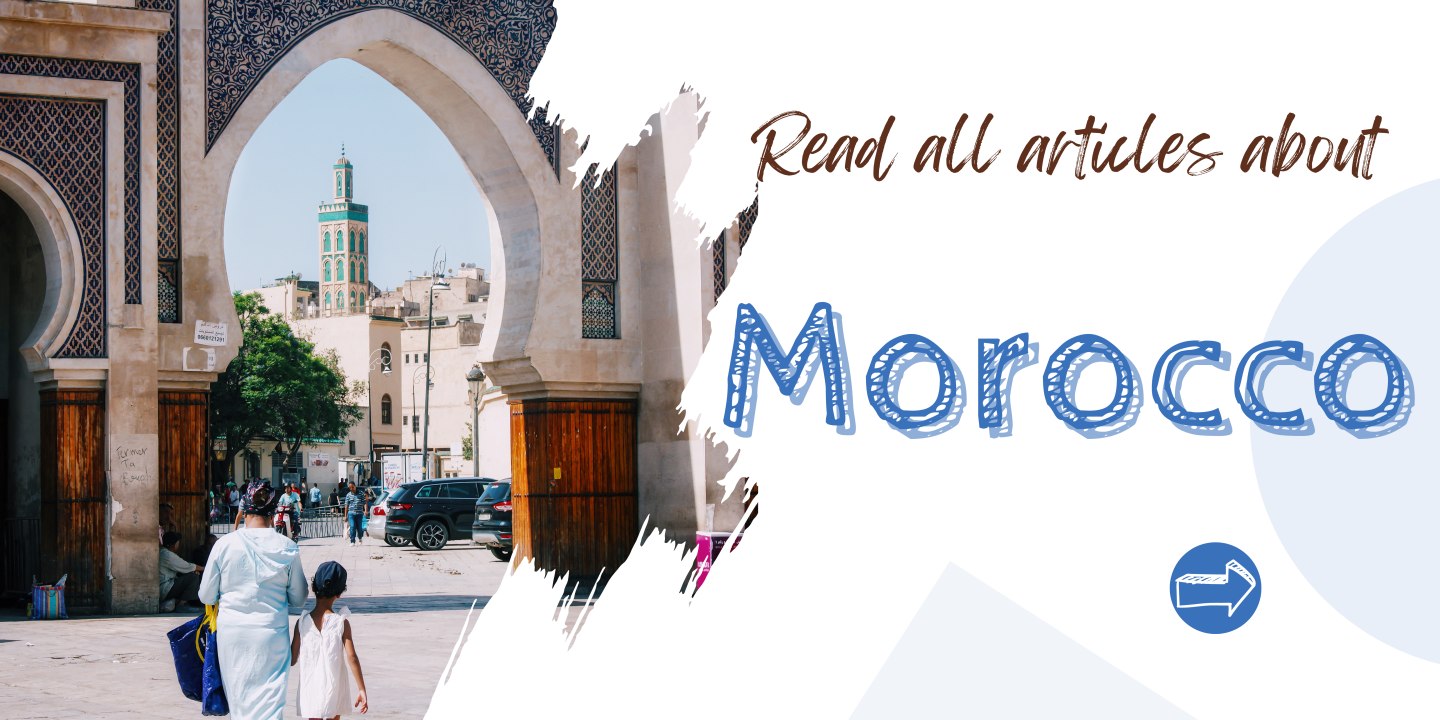
No time to read? Save it for later
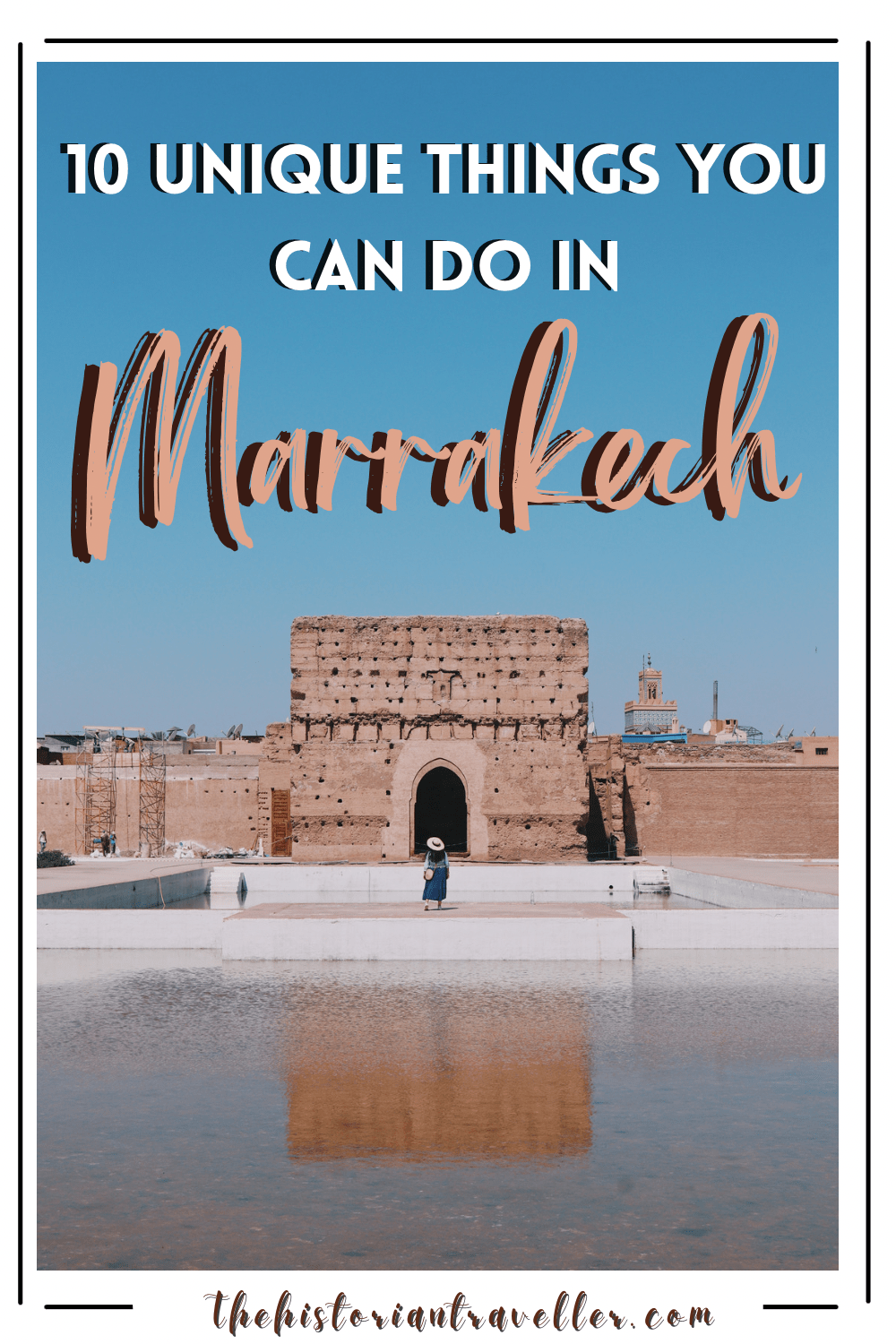

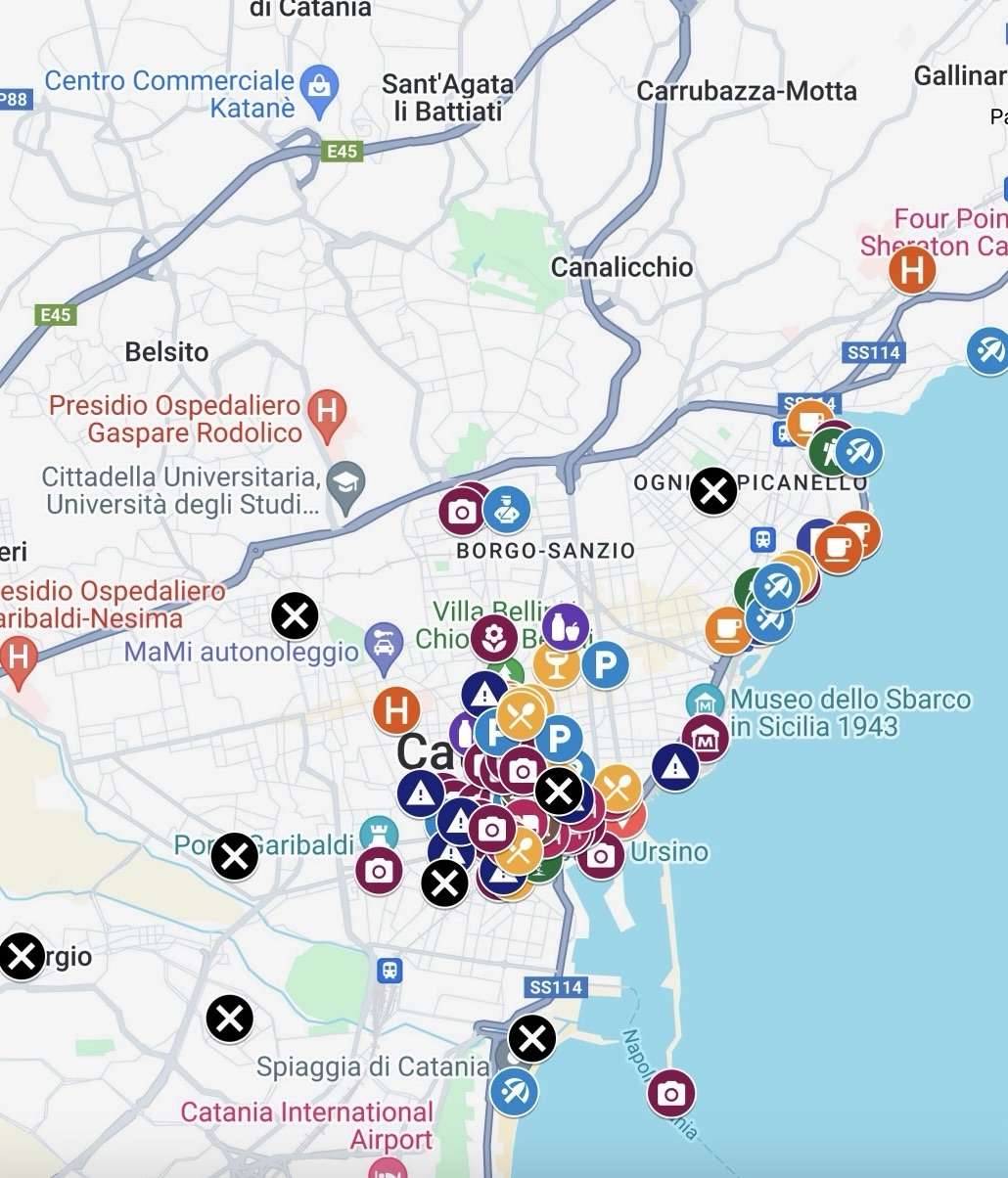
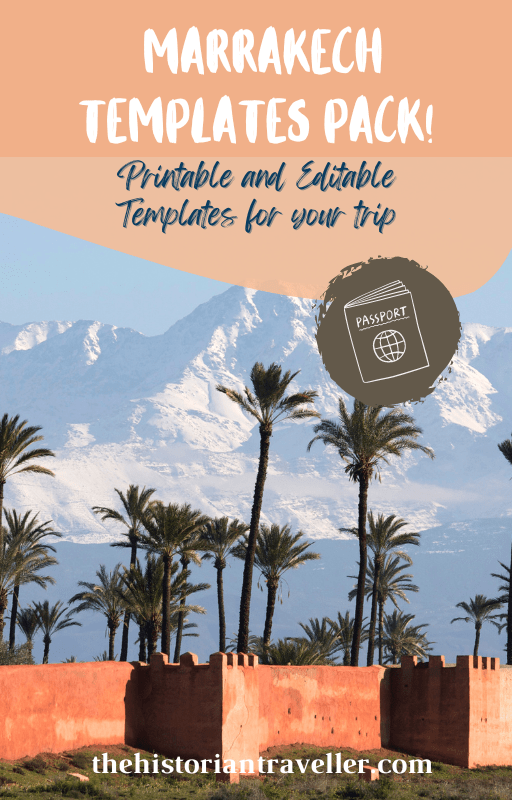
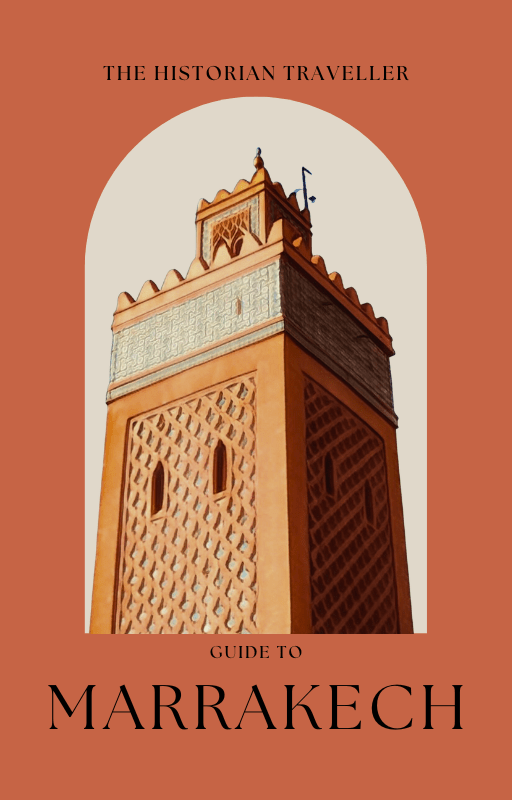
This is so helpful! Marrakech is on my bucket list so I’m definitely saving this for later. Thank you for taking the time to put all of these details together. I can’t wait to visit. It looks so pretty!
What an insightful guide on the top things to do in Marrakech! I definitely saving this listicle for later I’d love to visit on a future trip! Thanks for sharing your helpful recommendations!
Author
Thanks for reading!